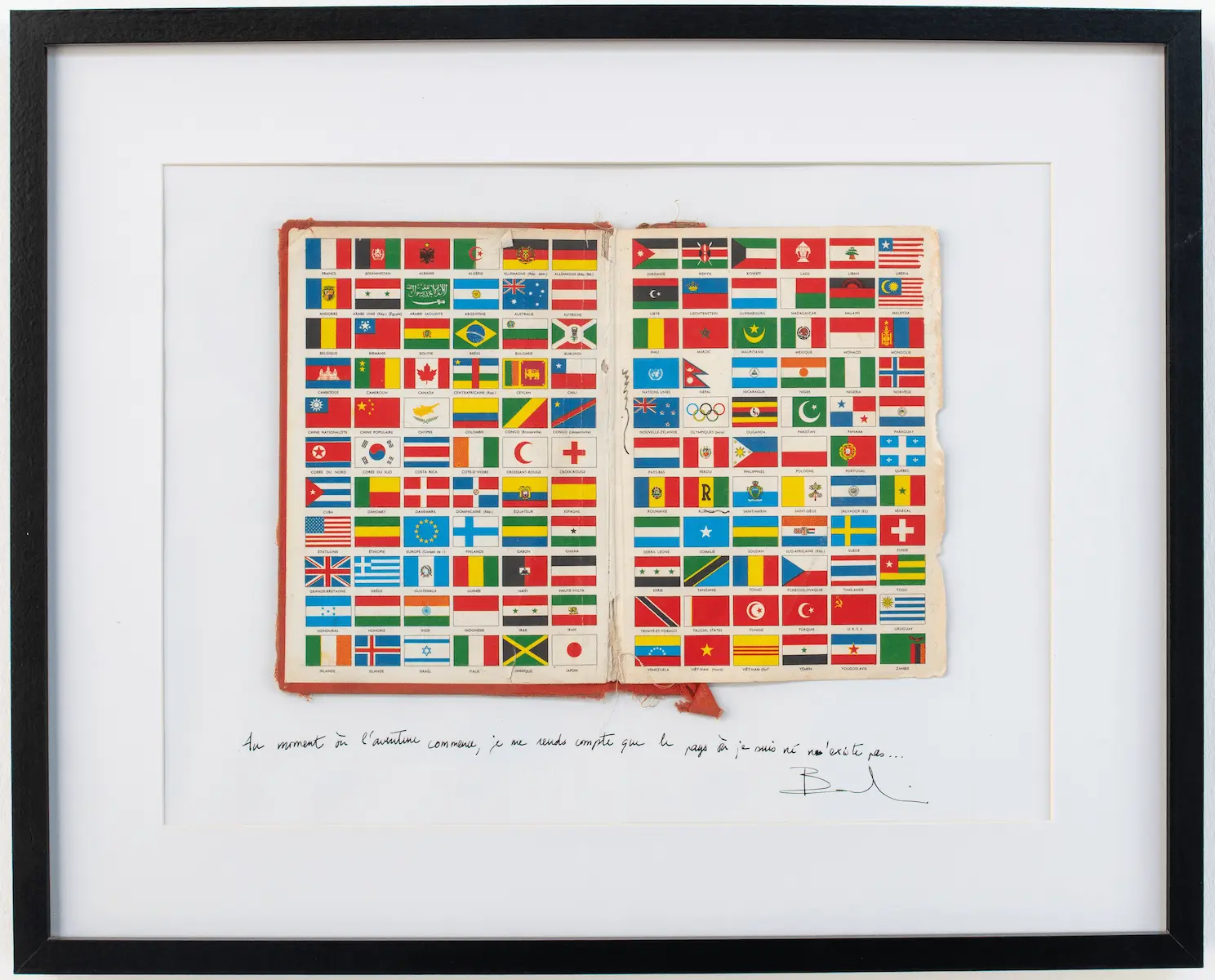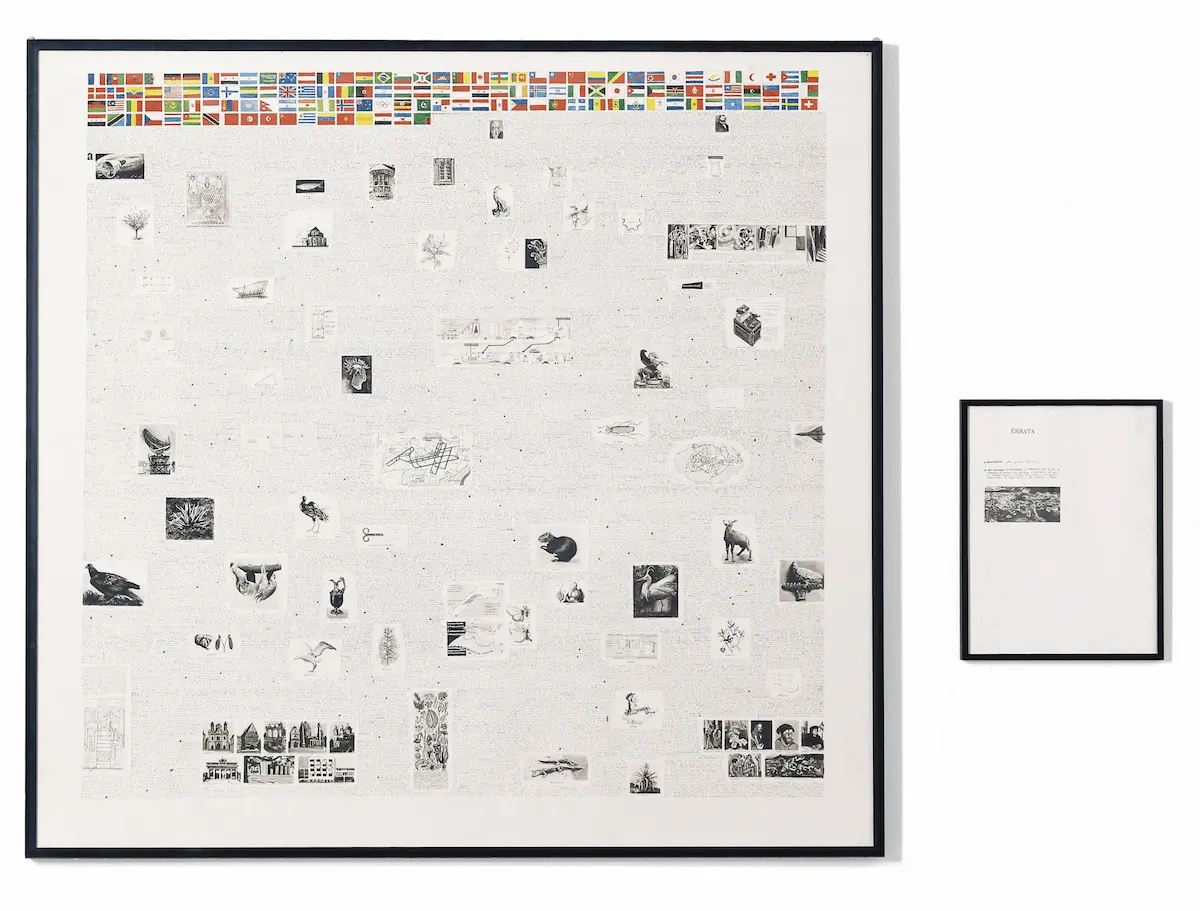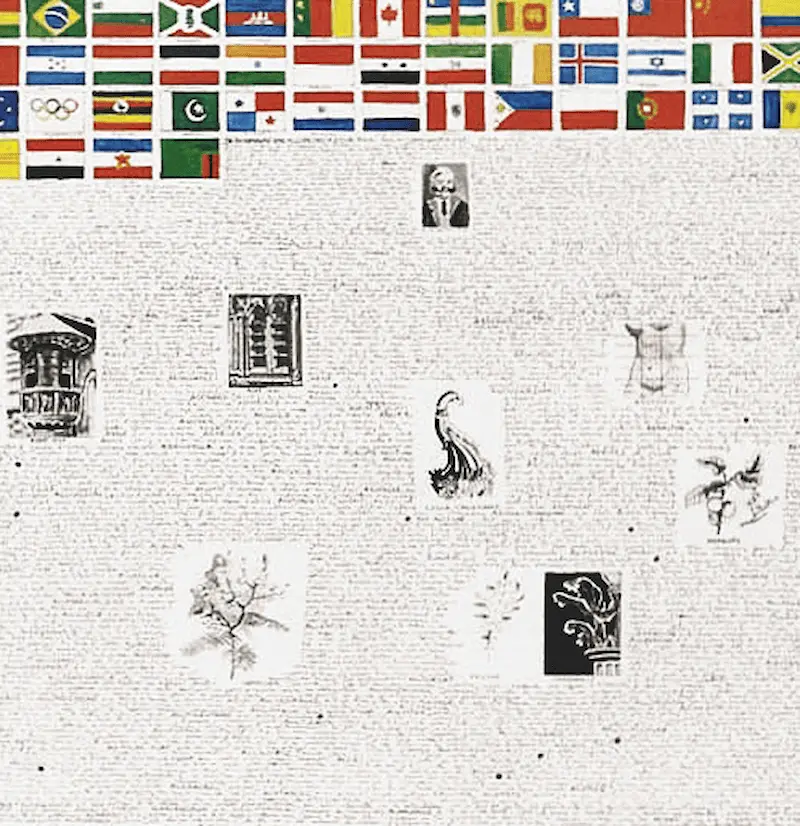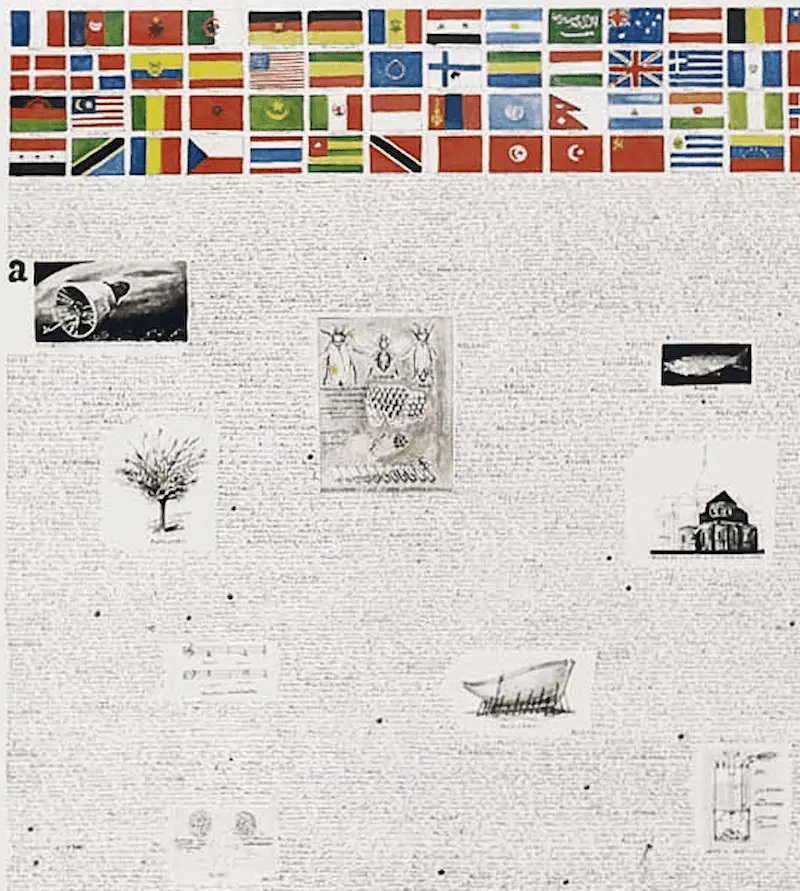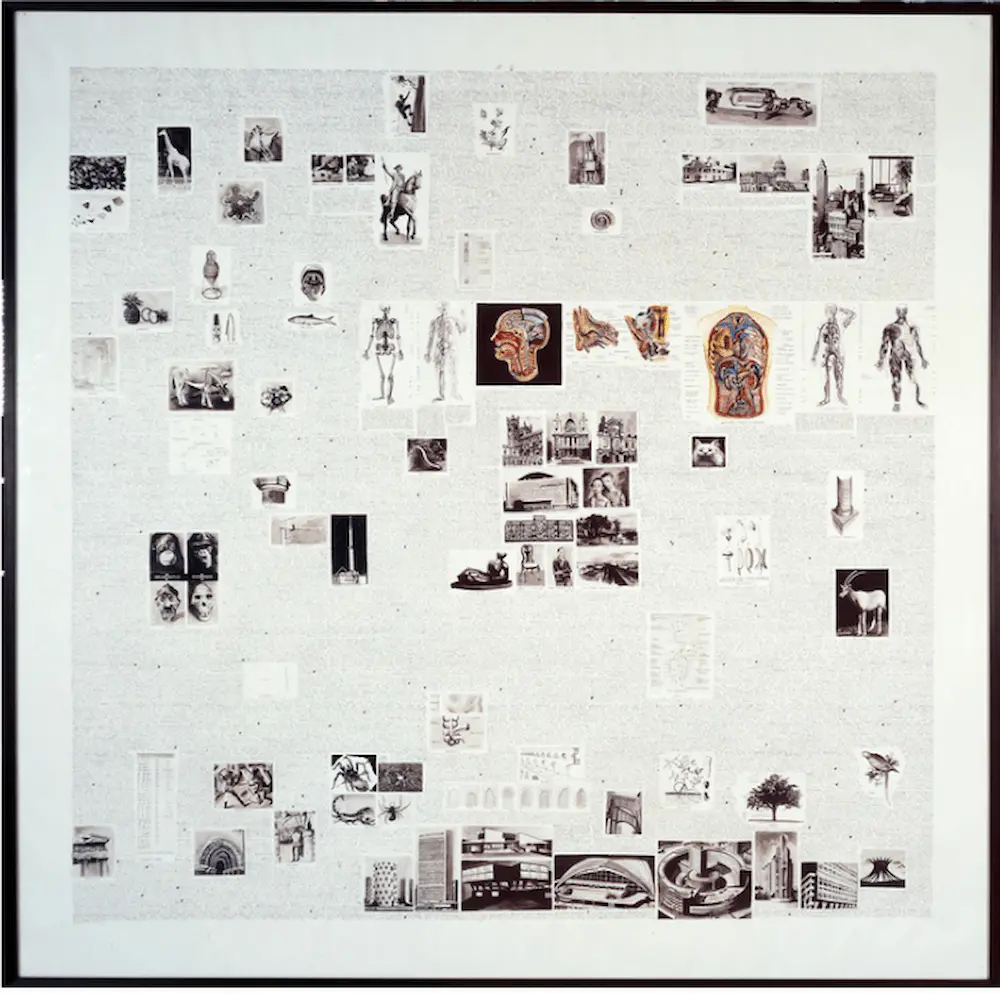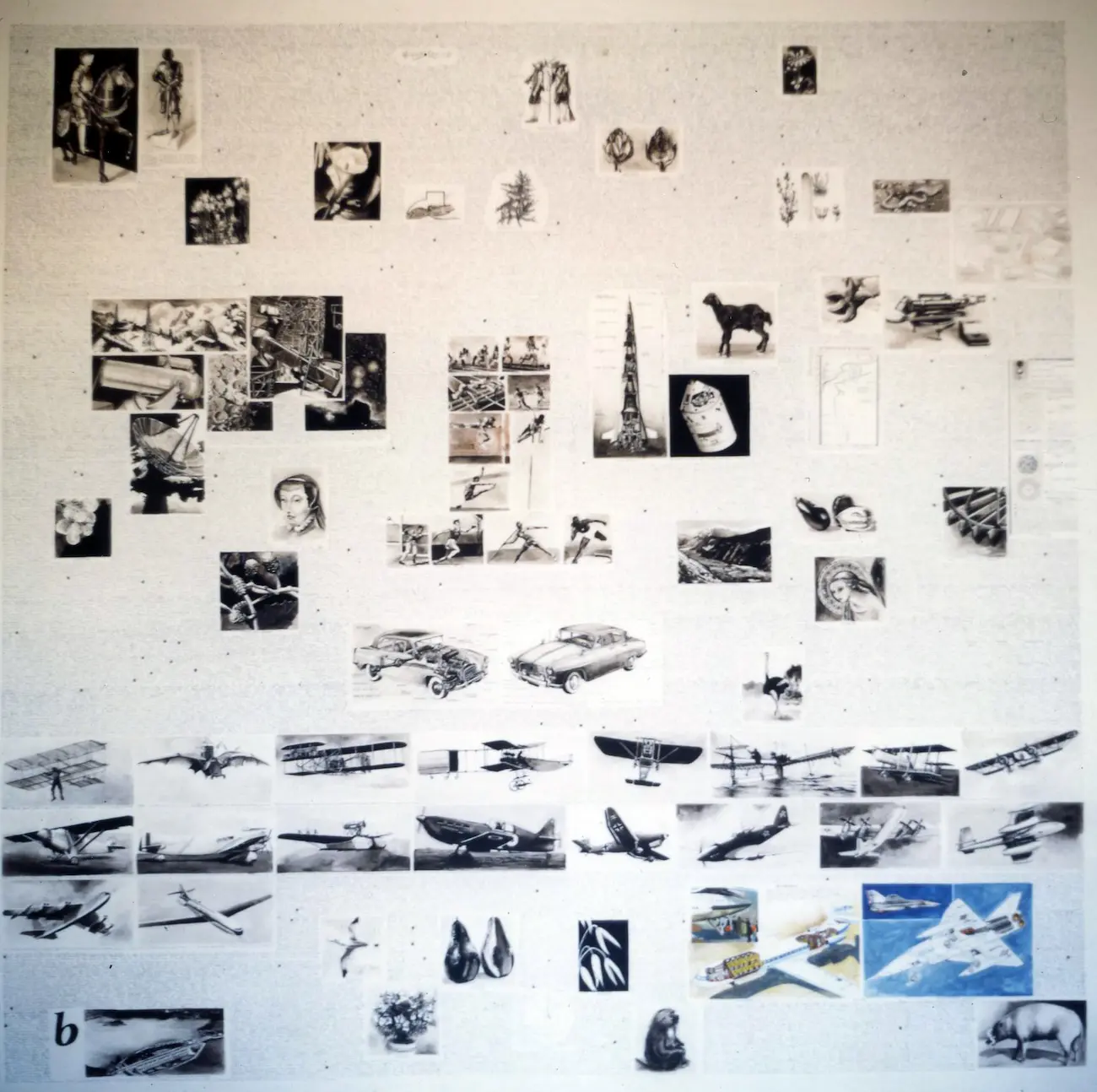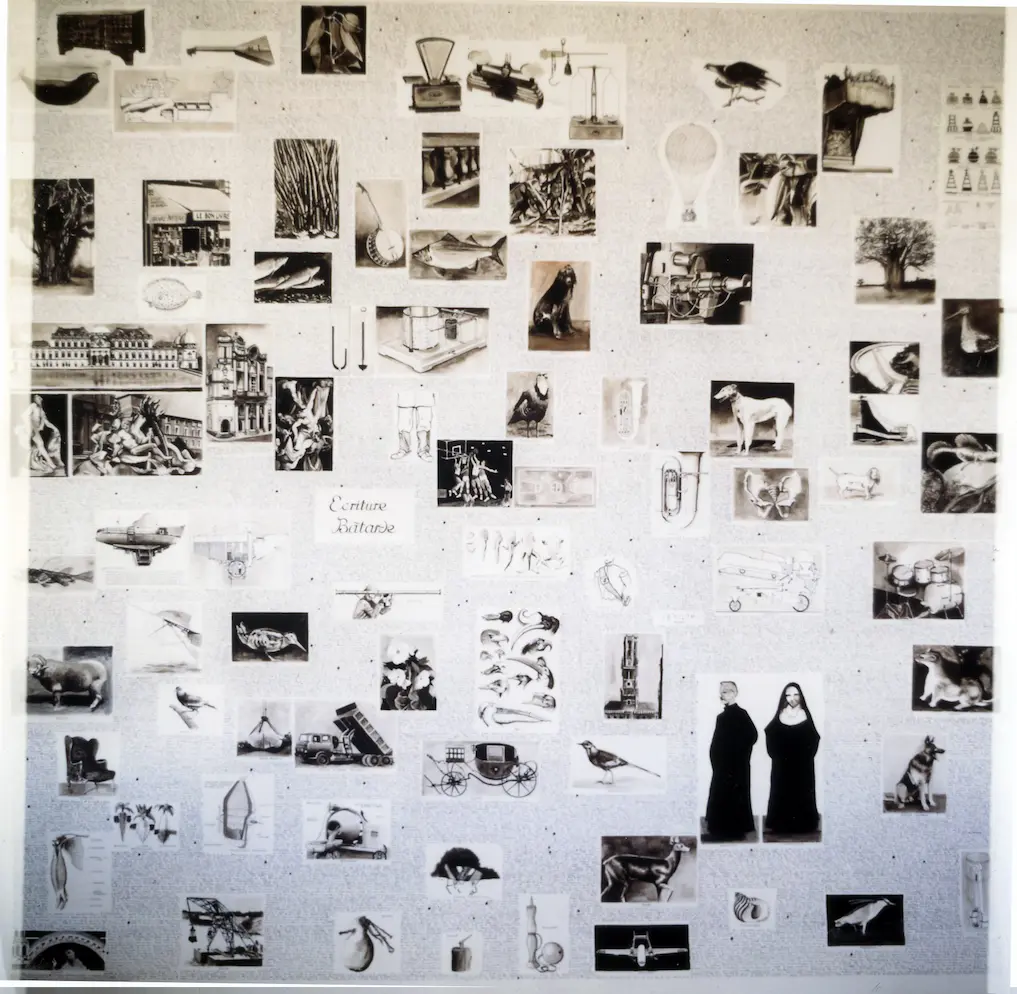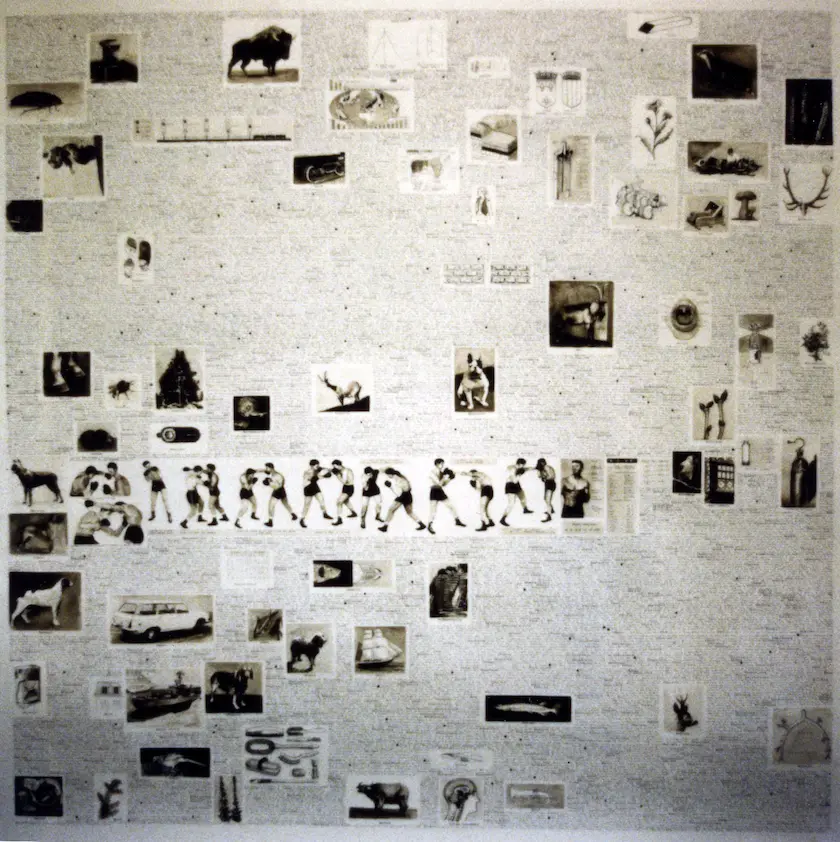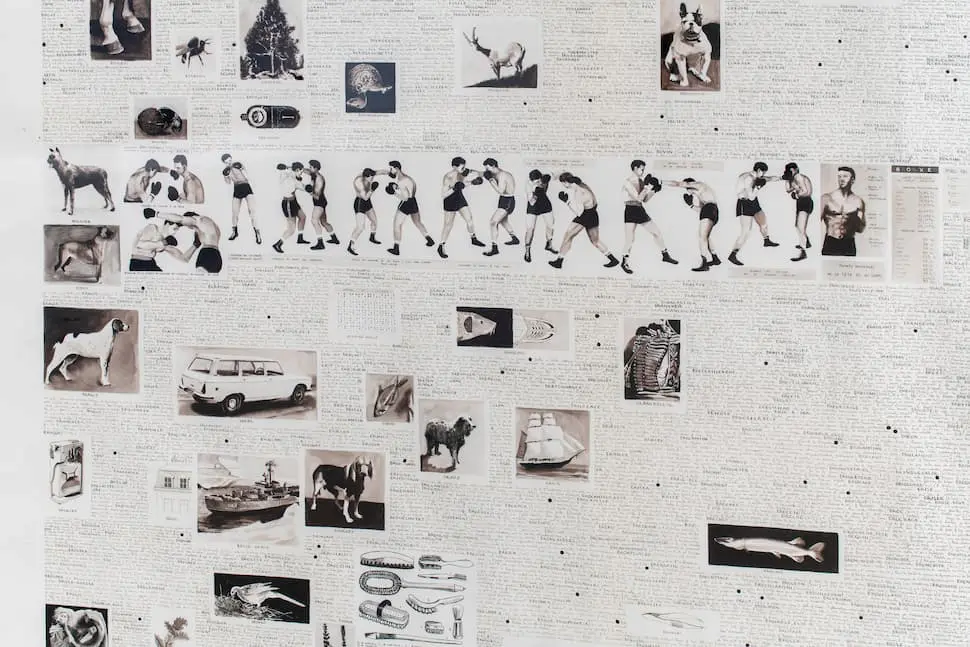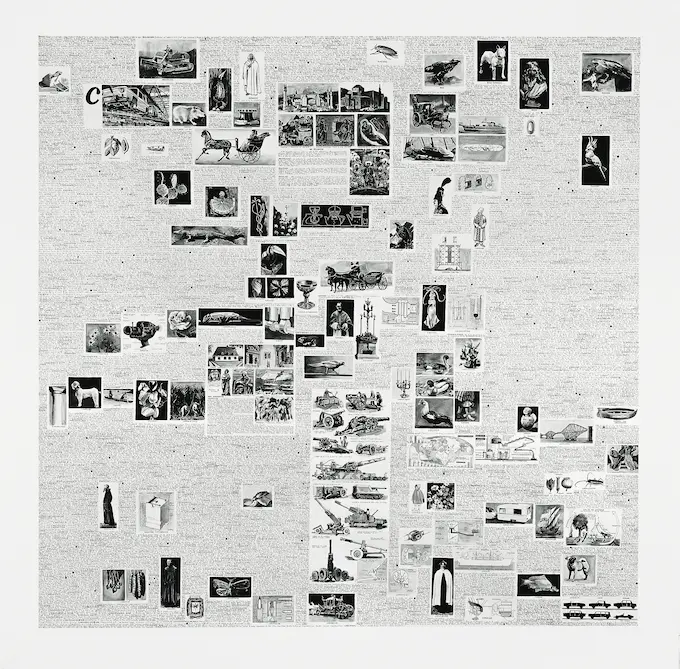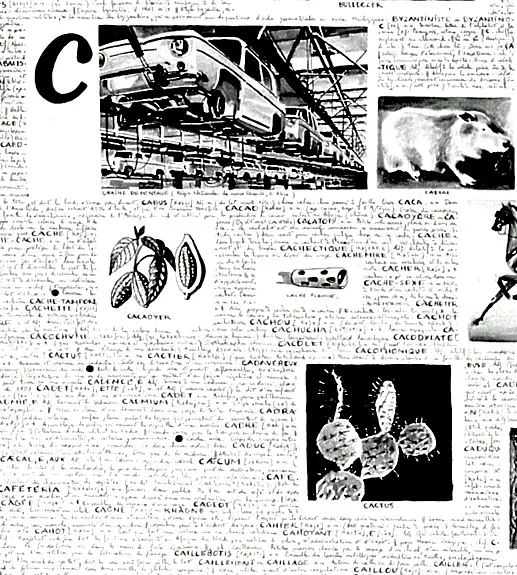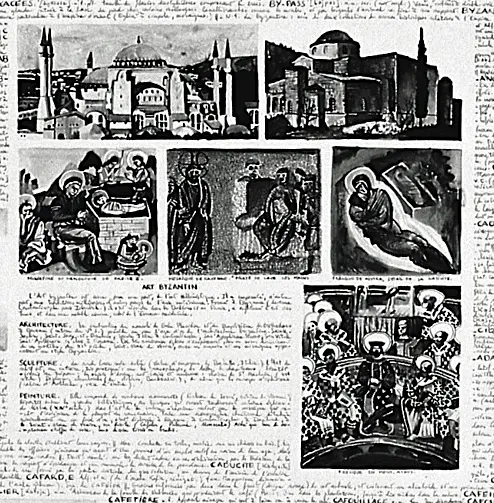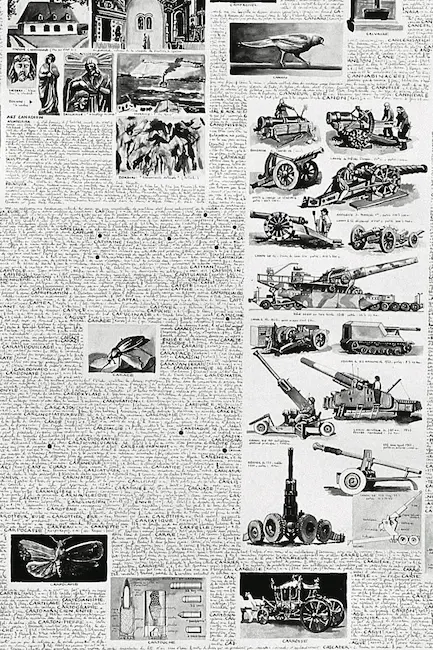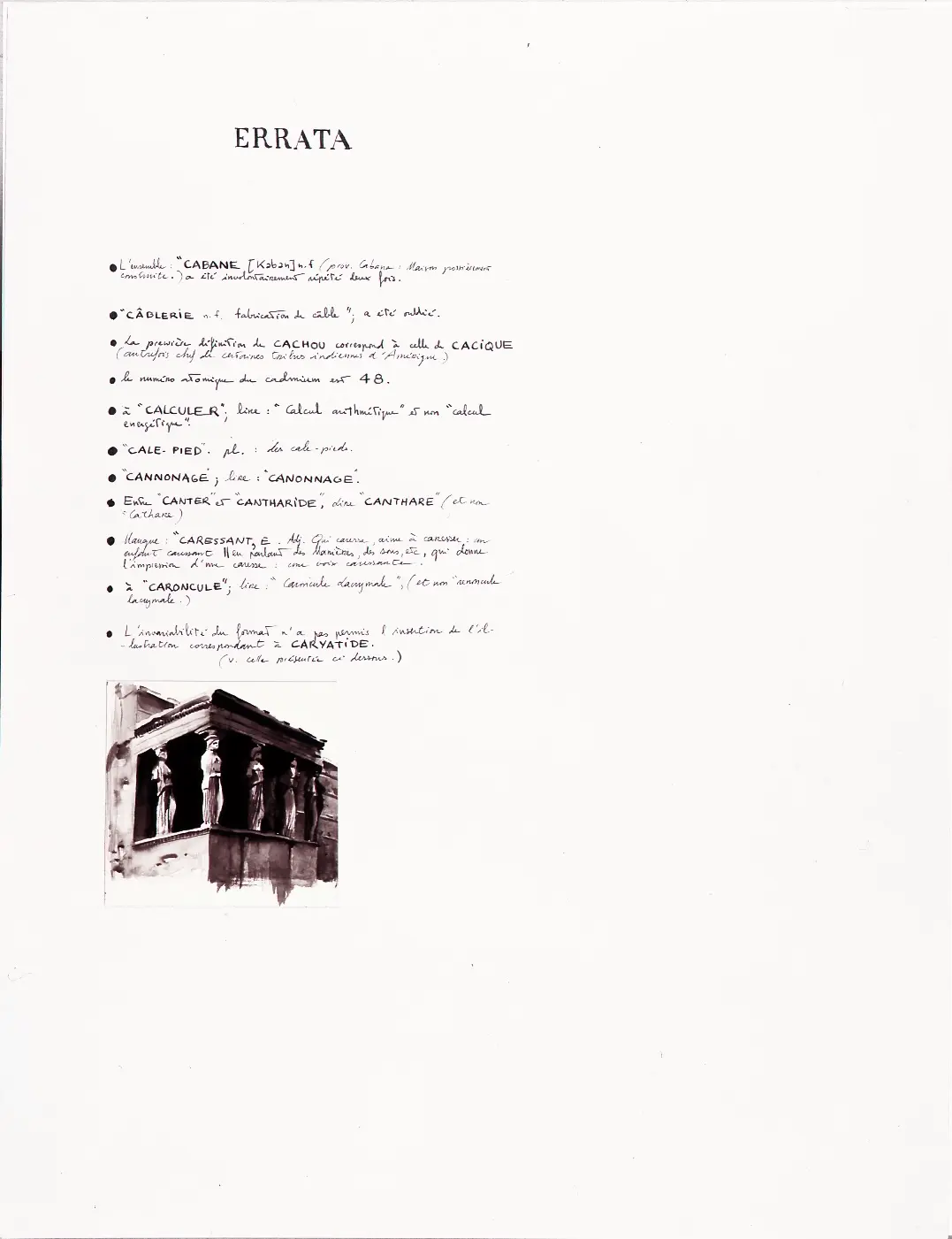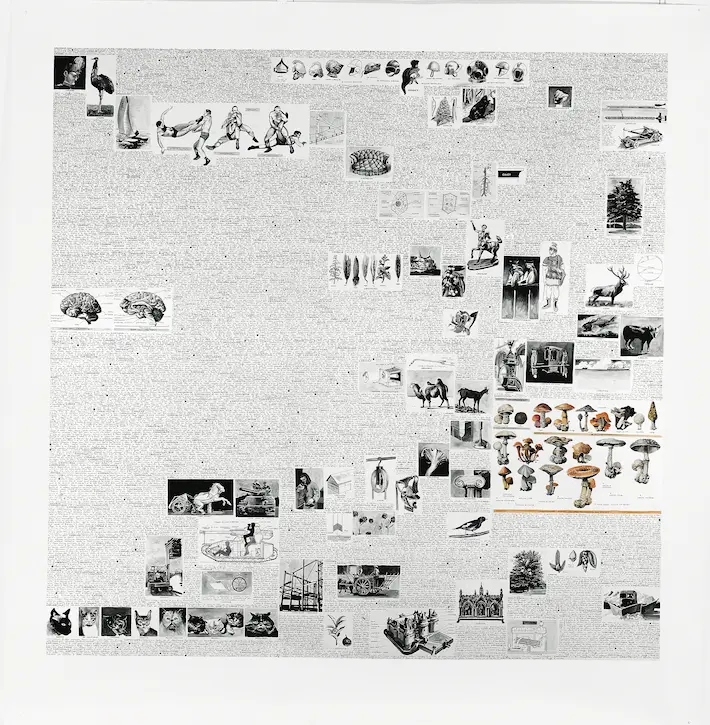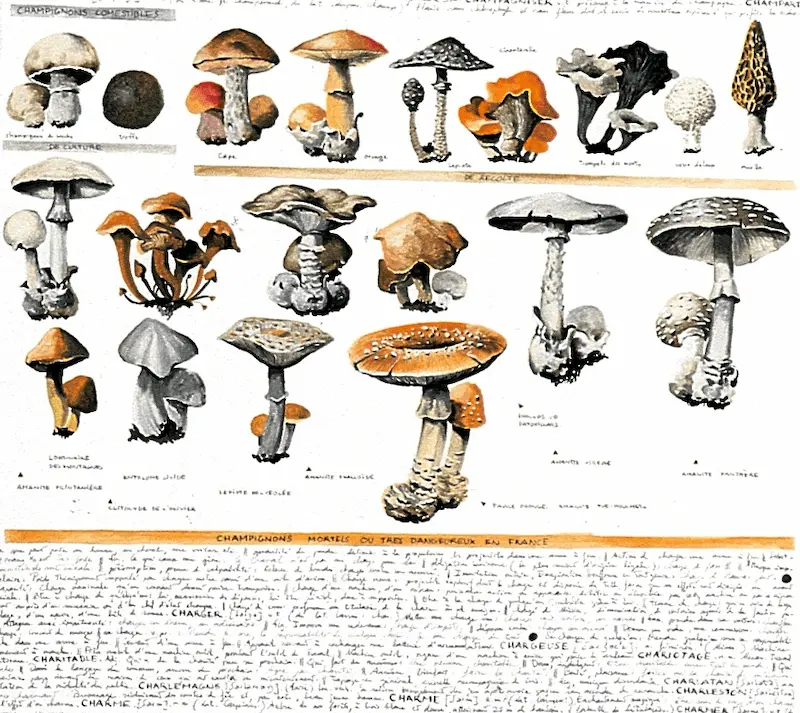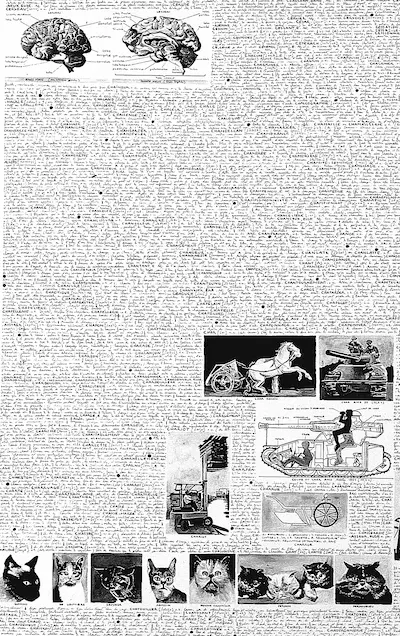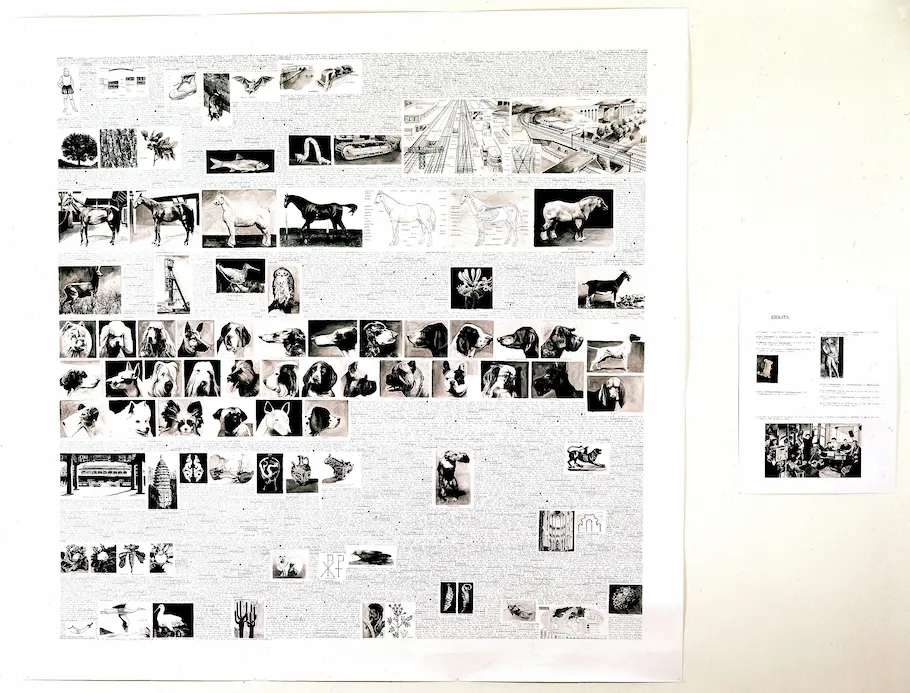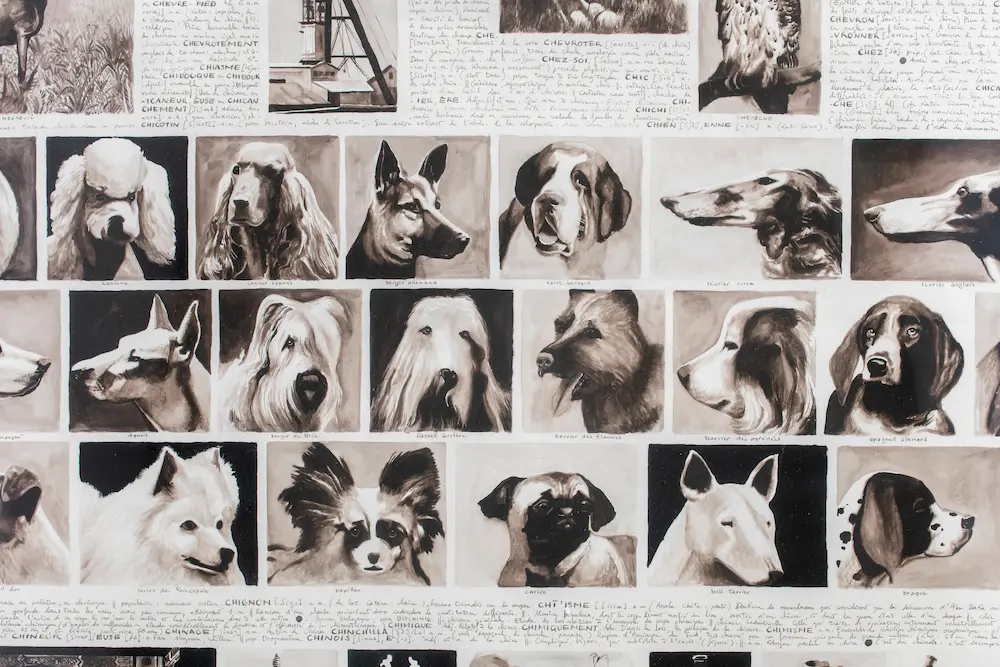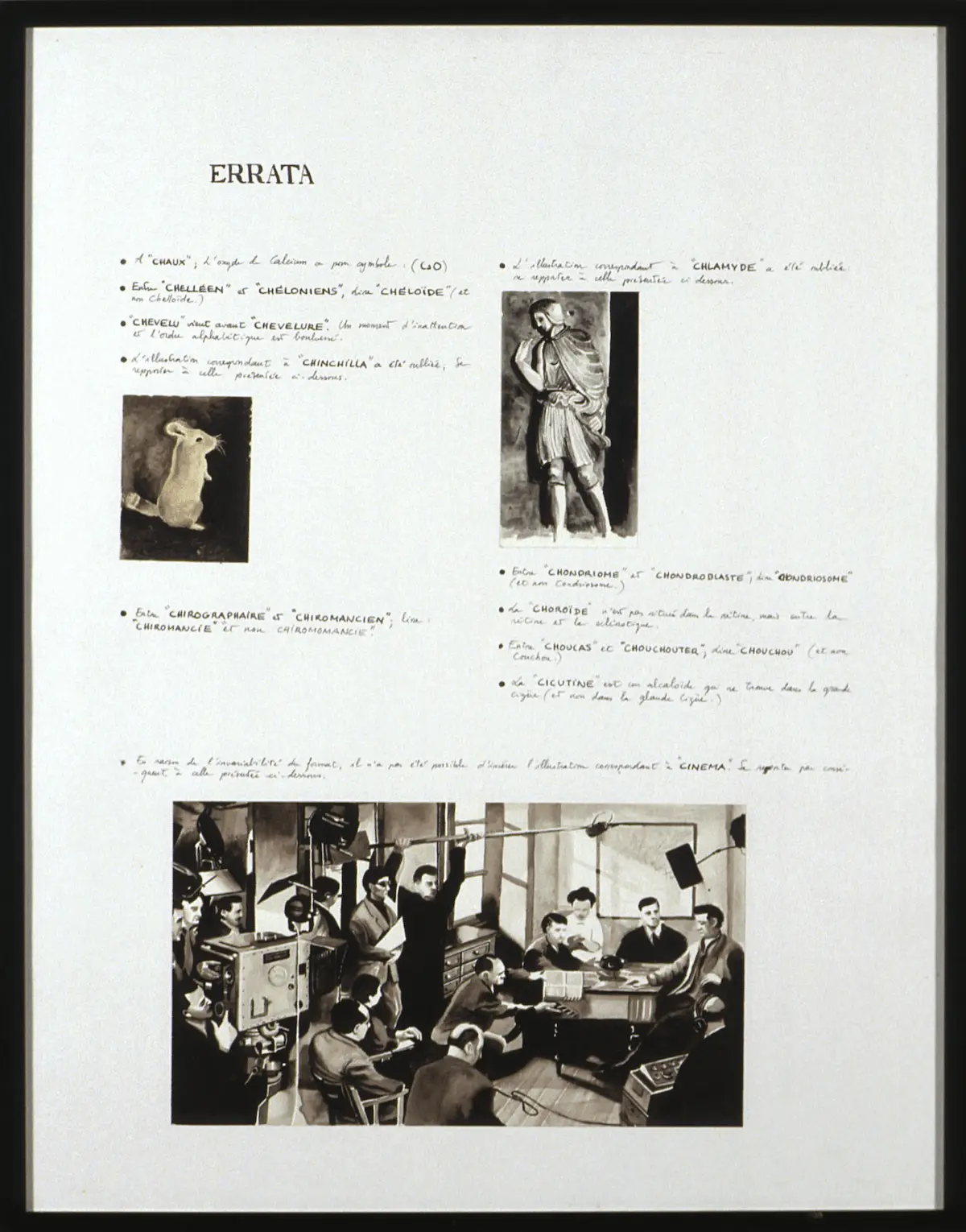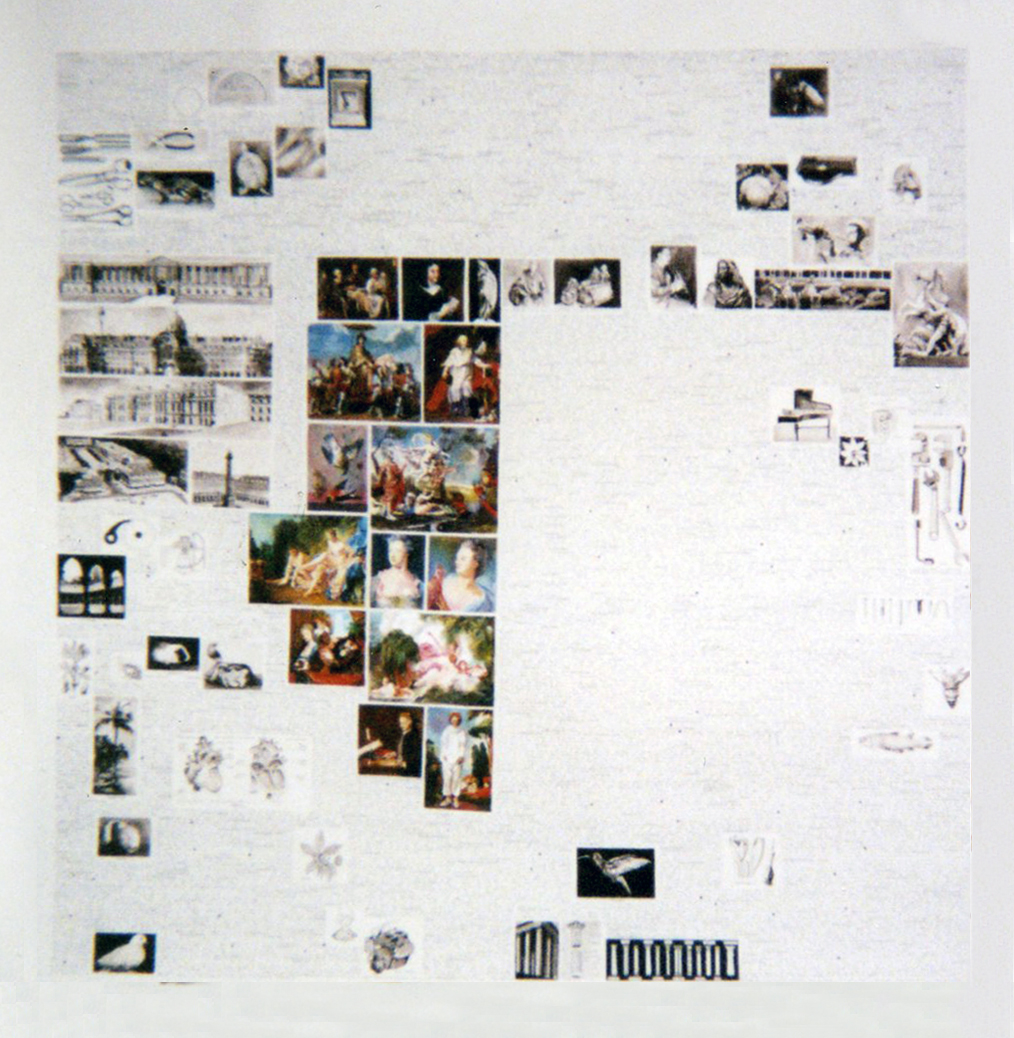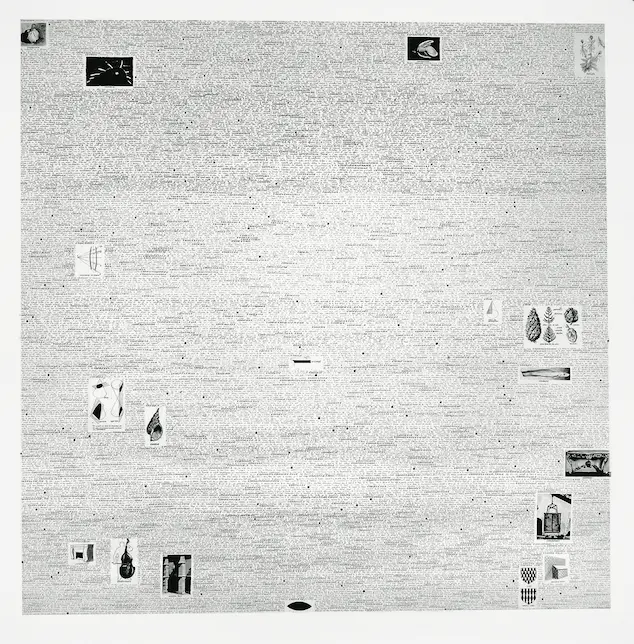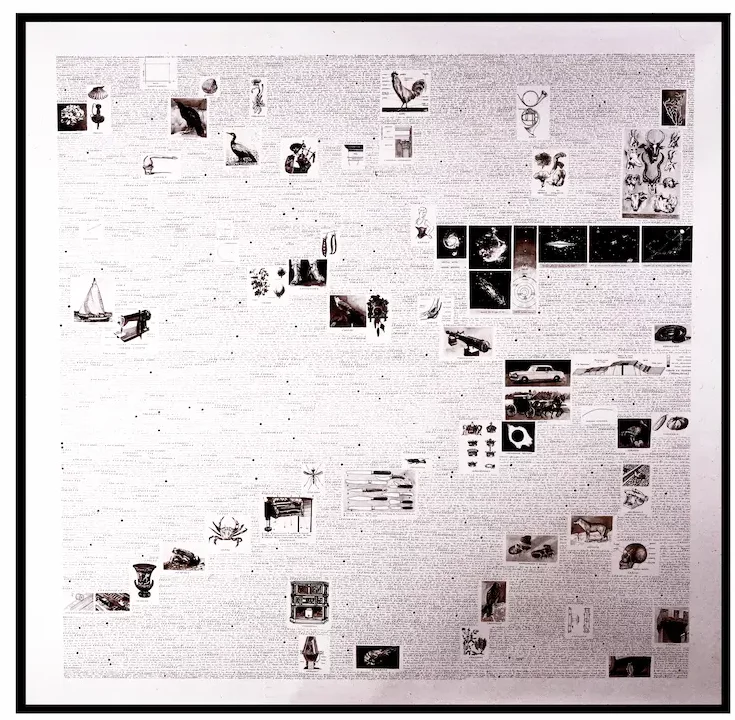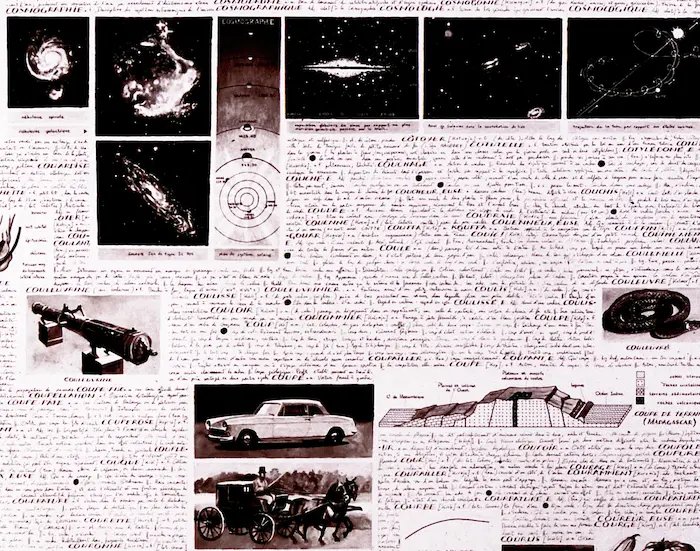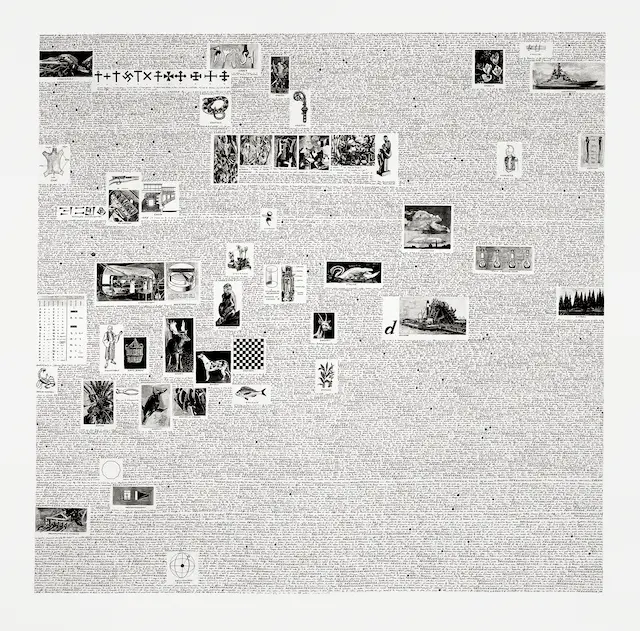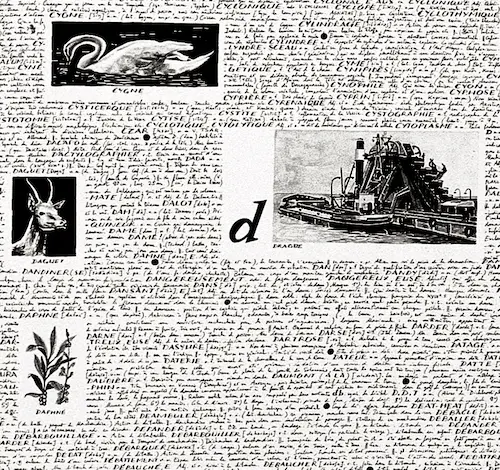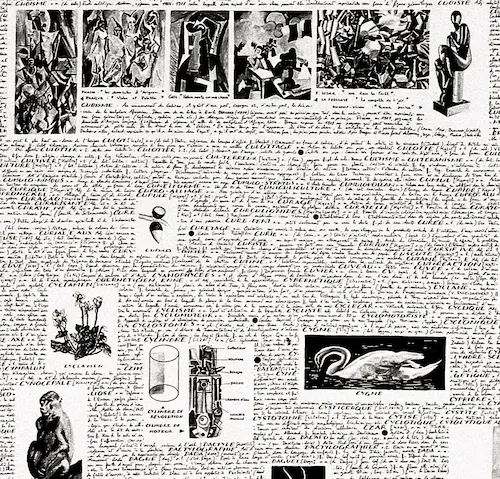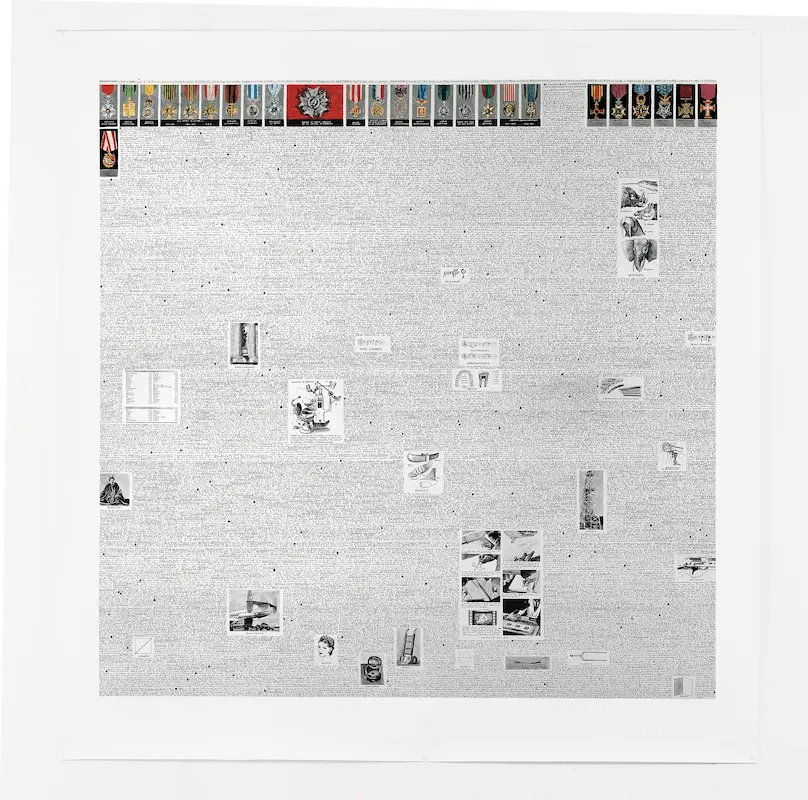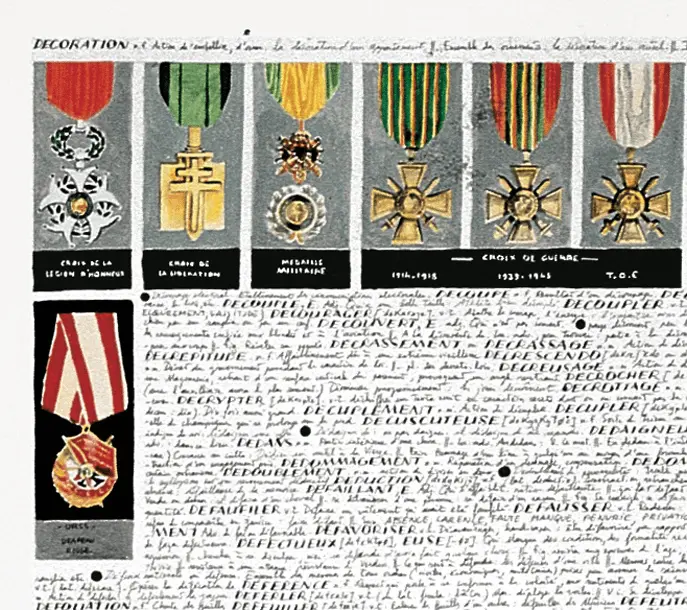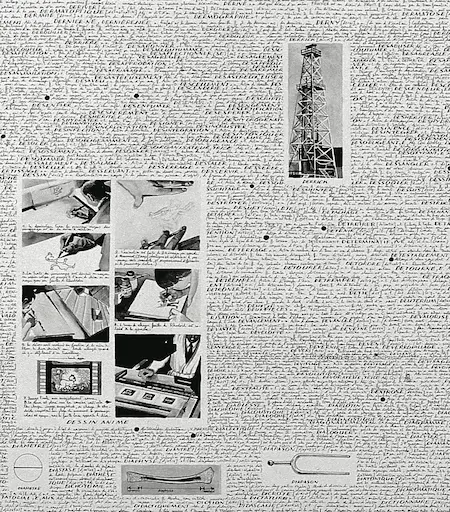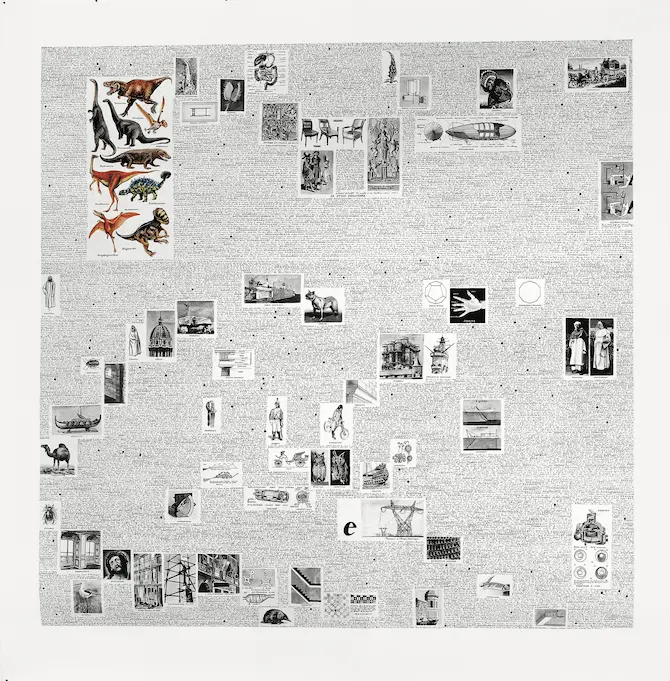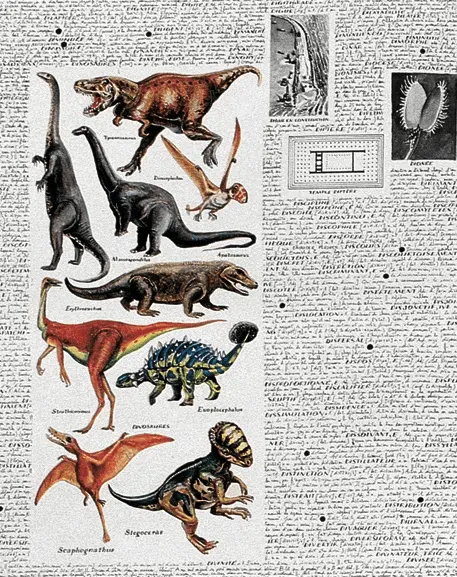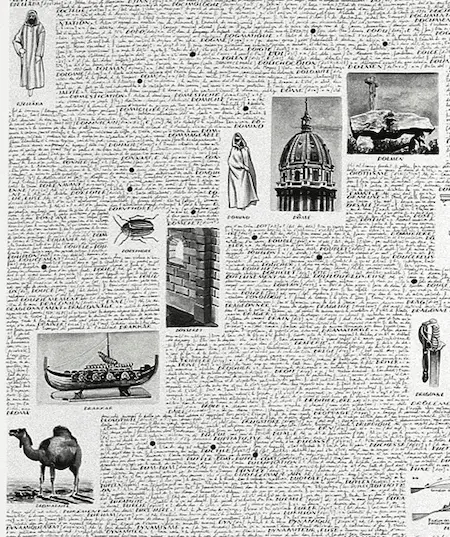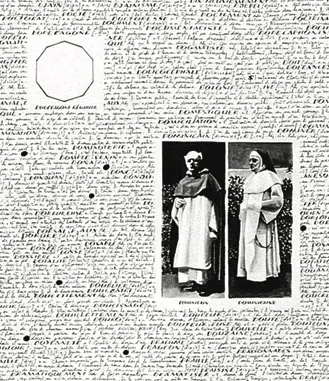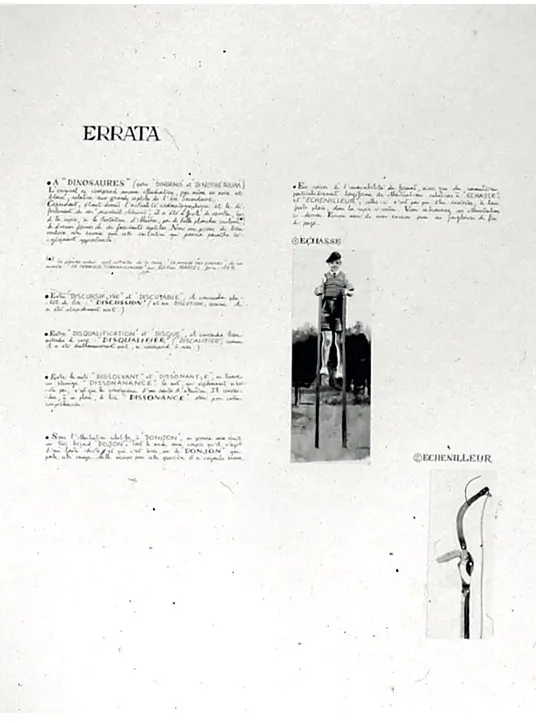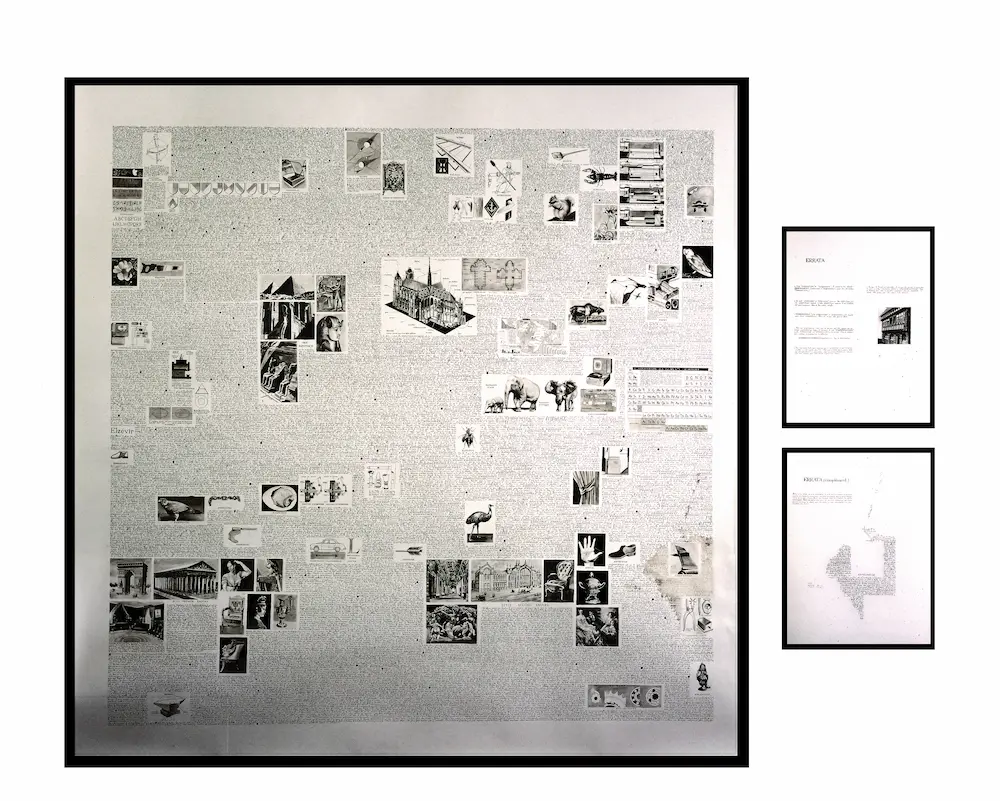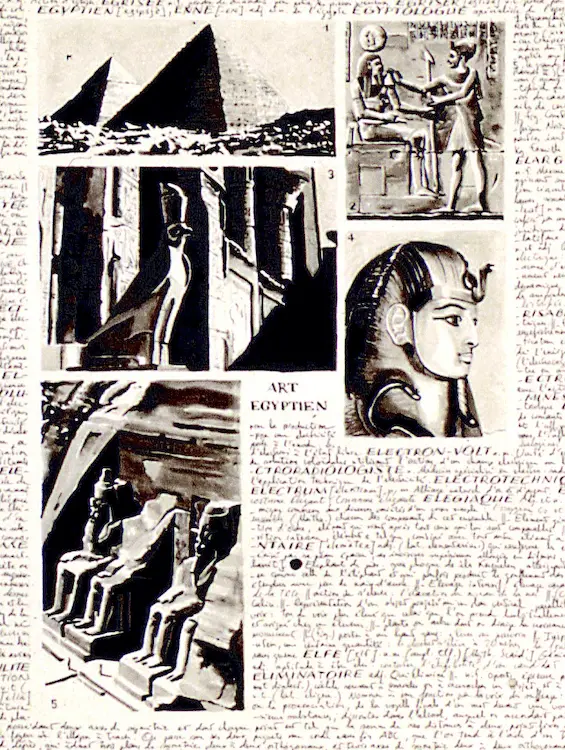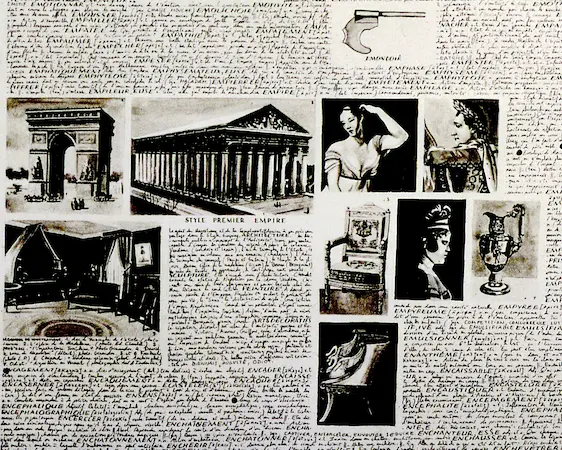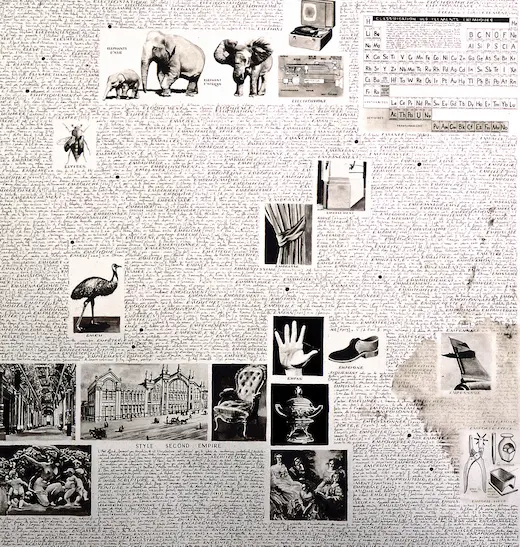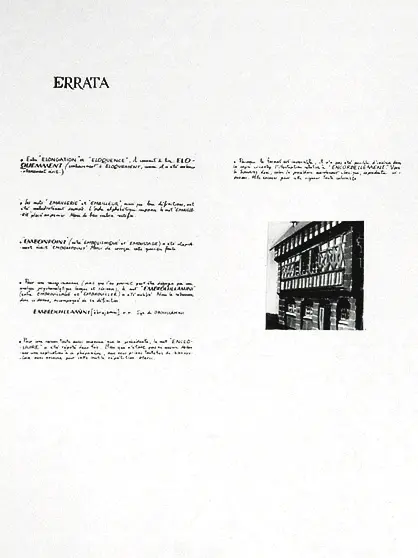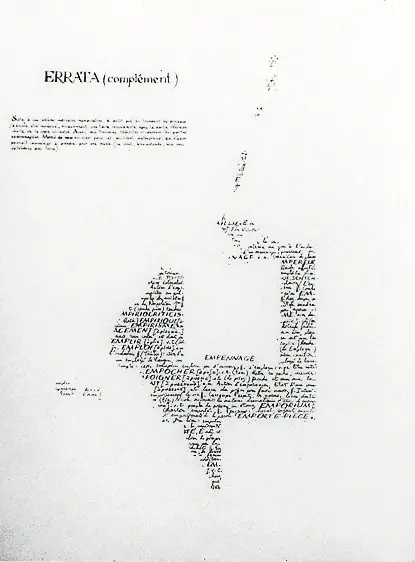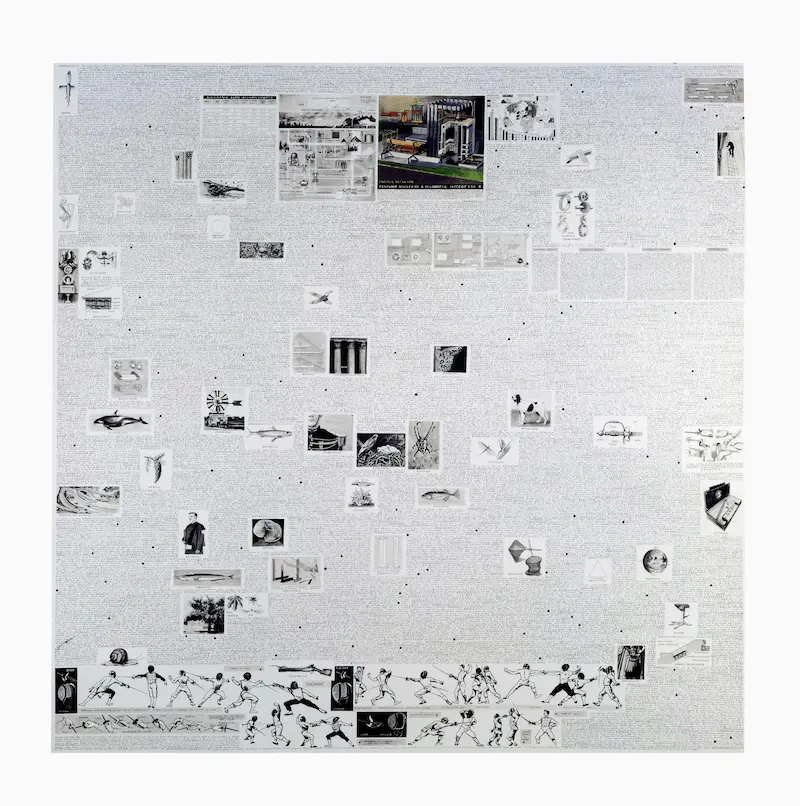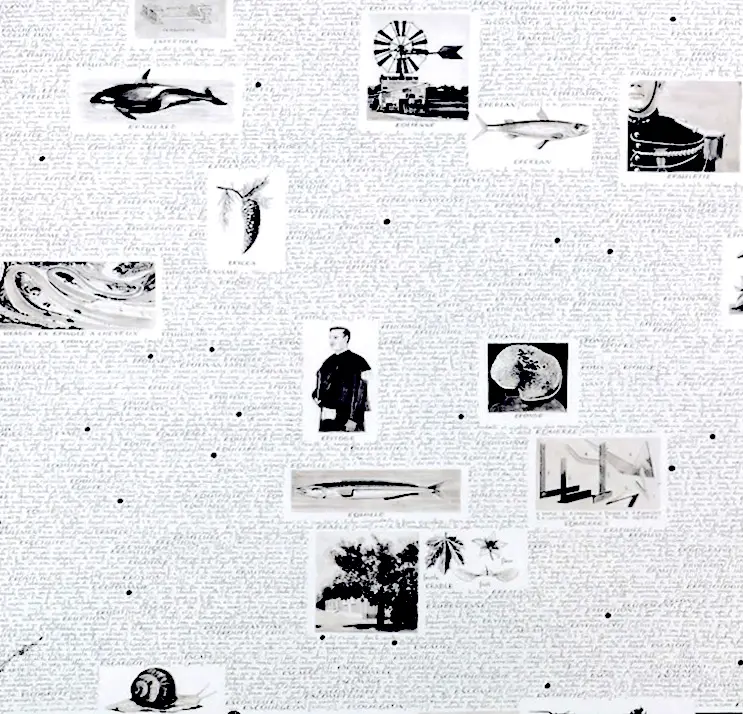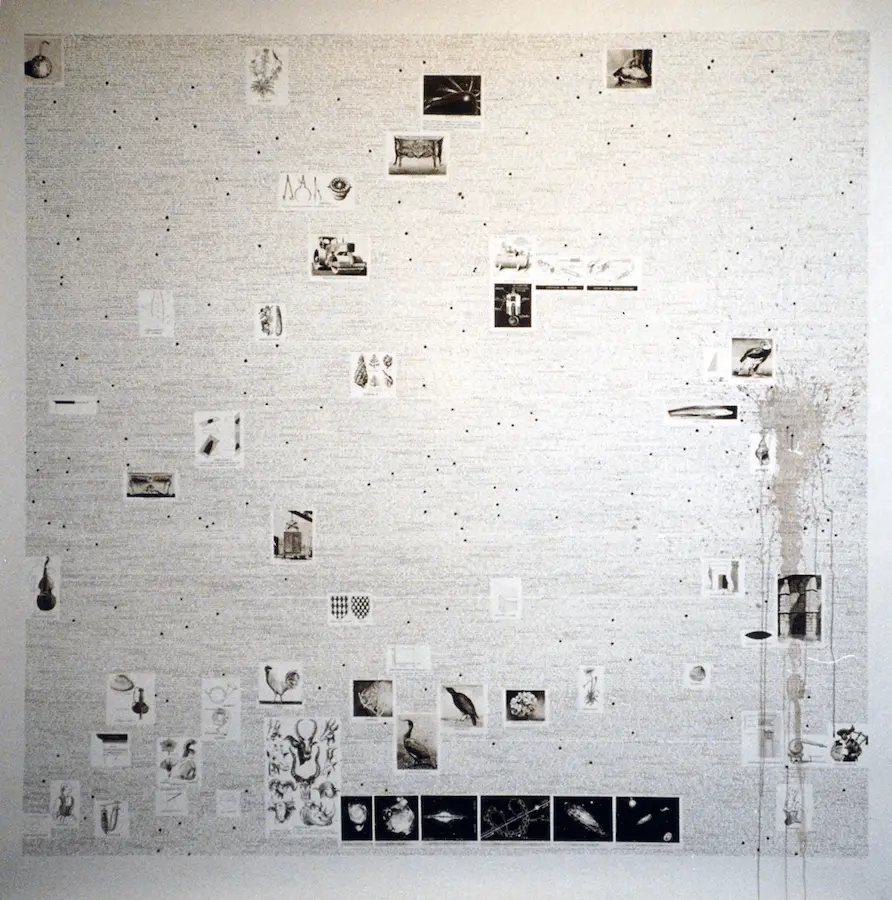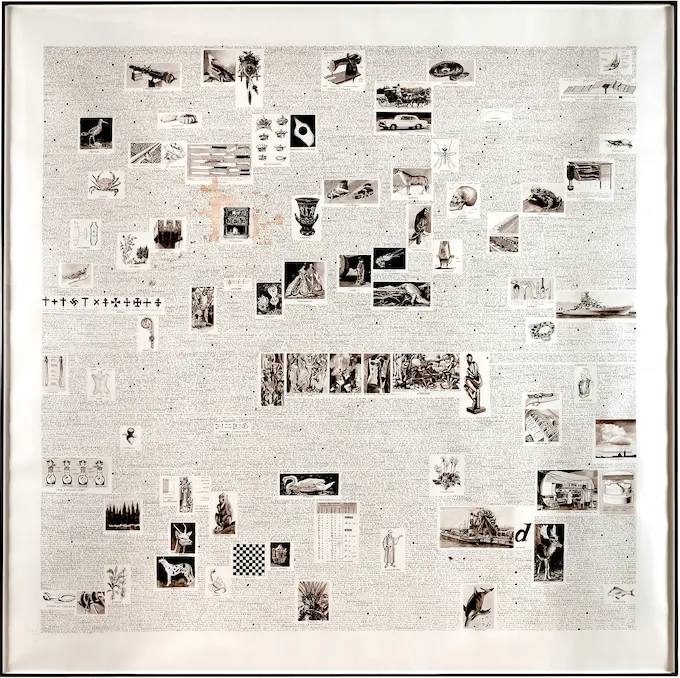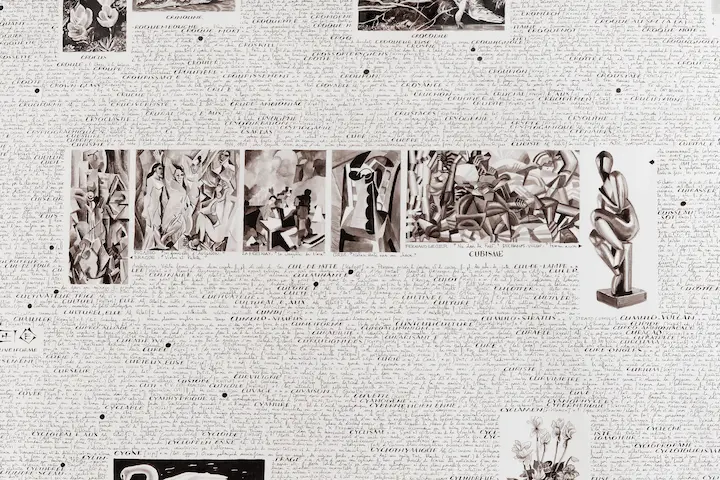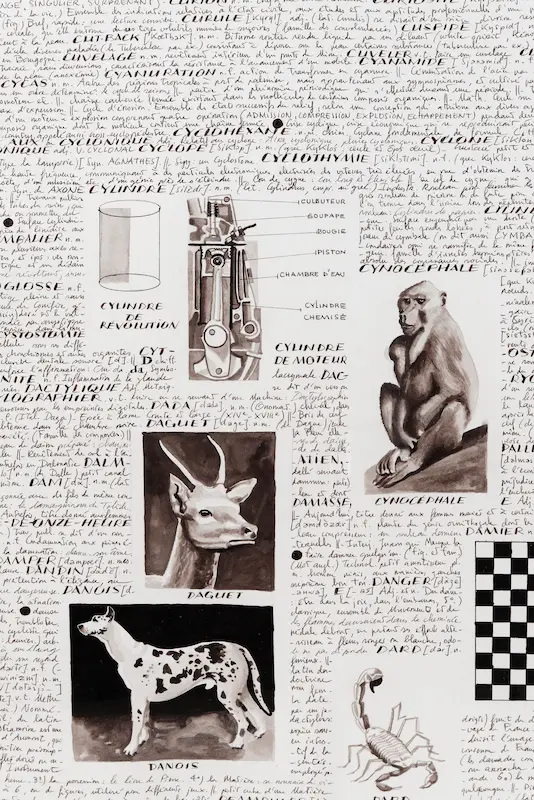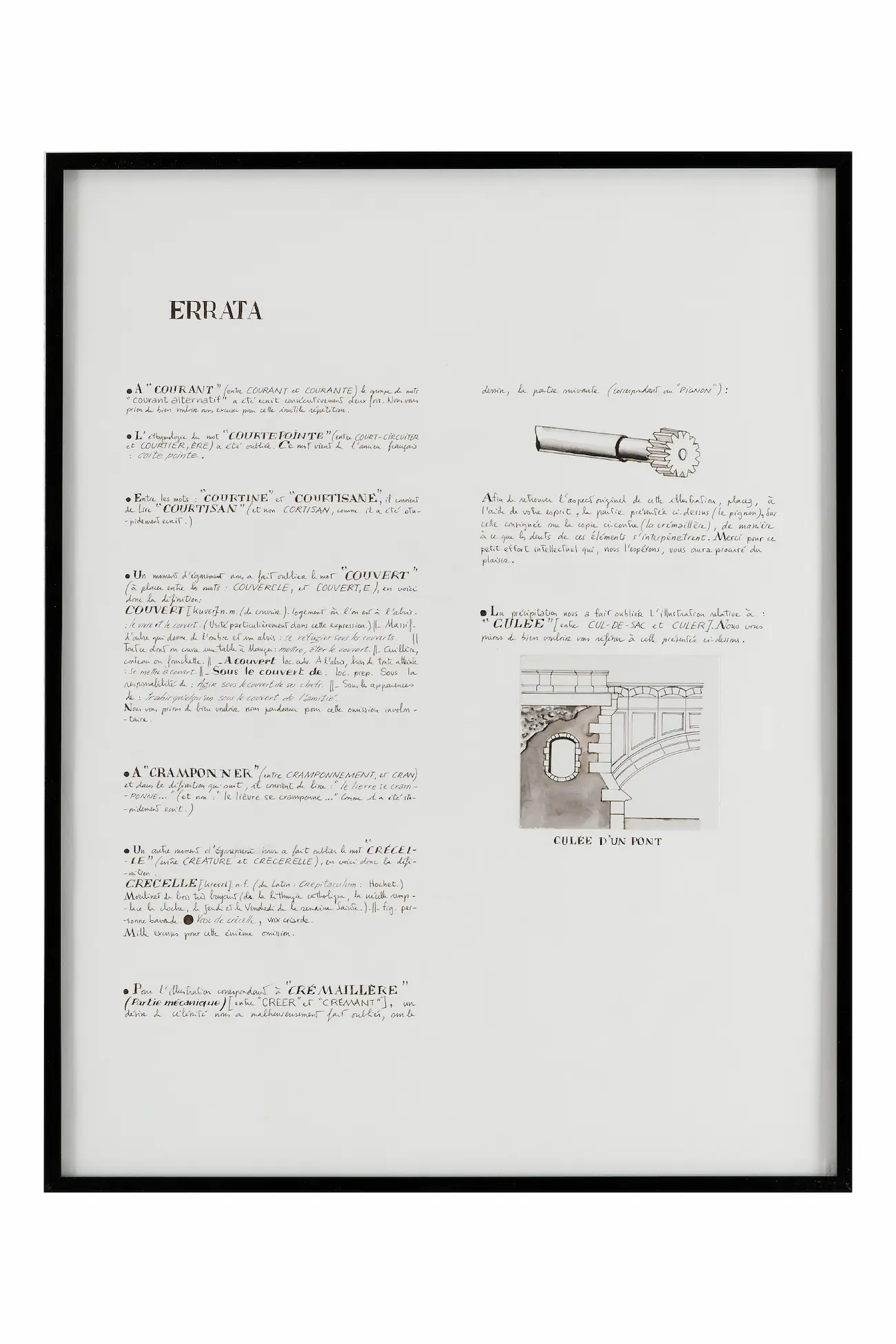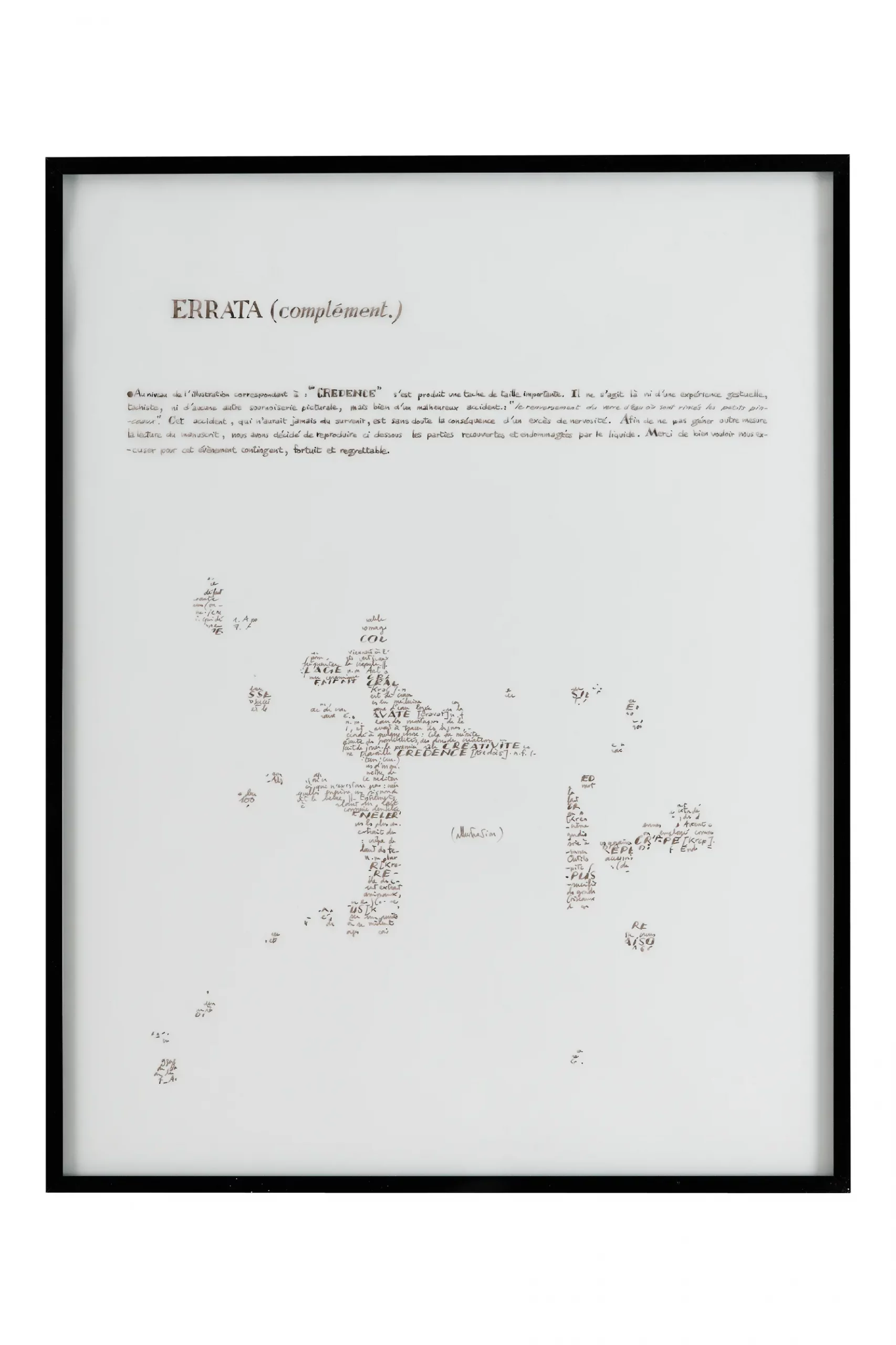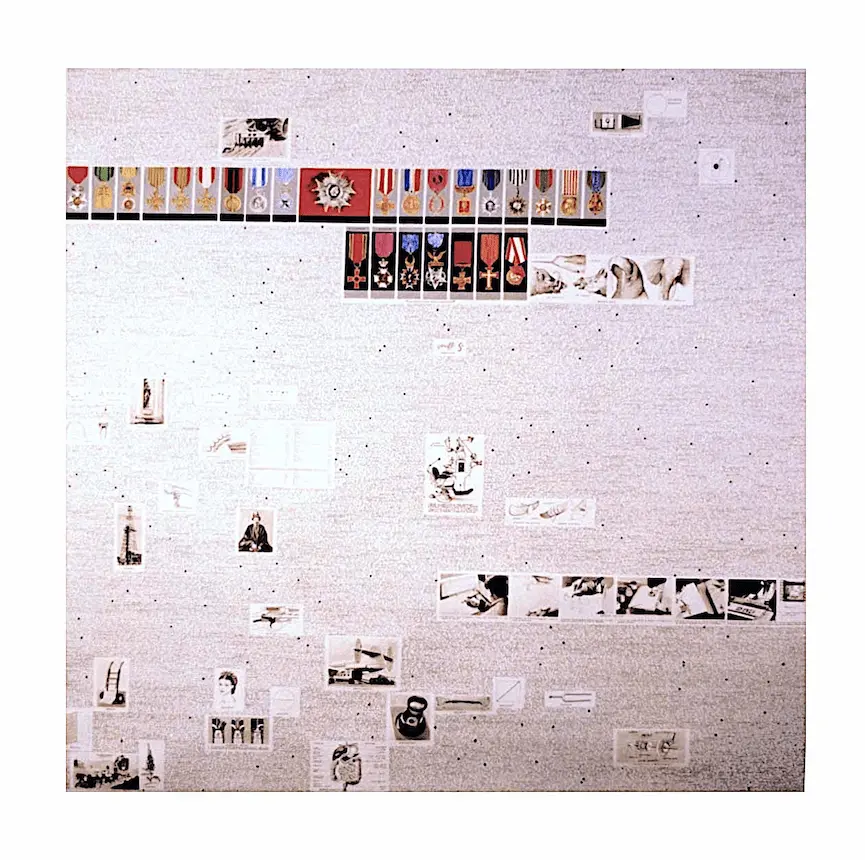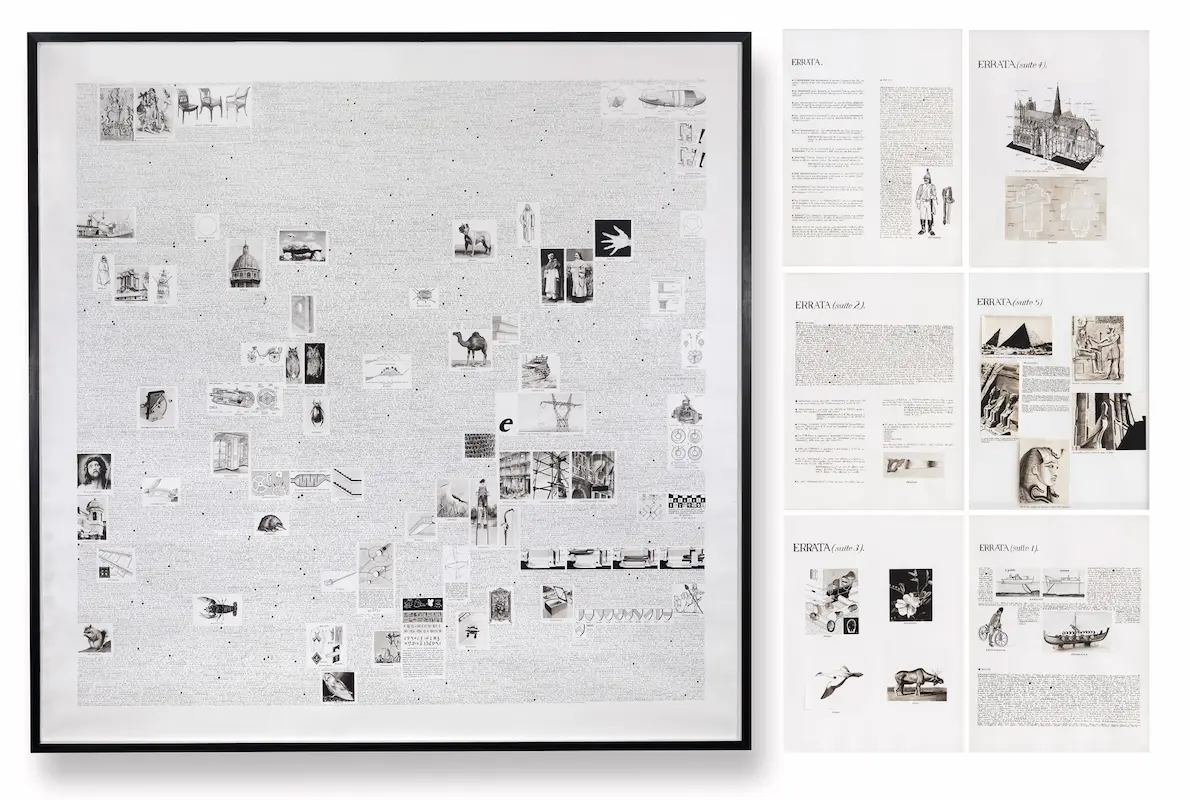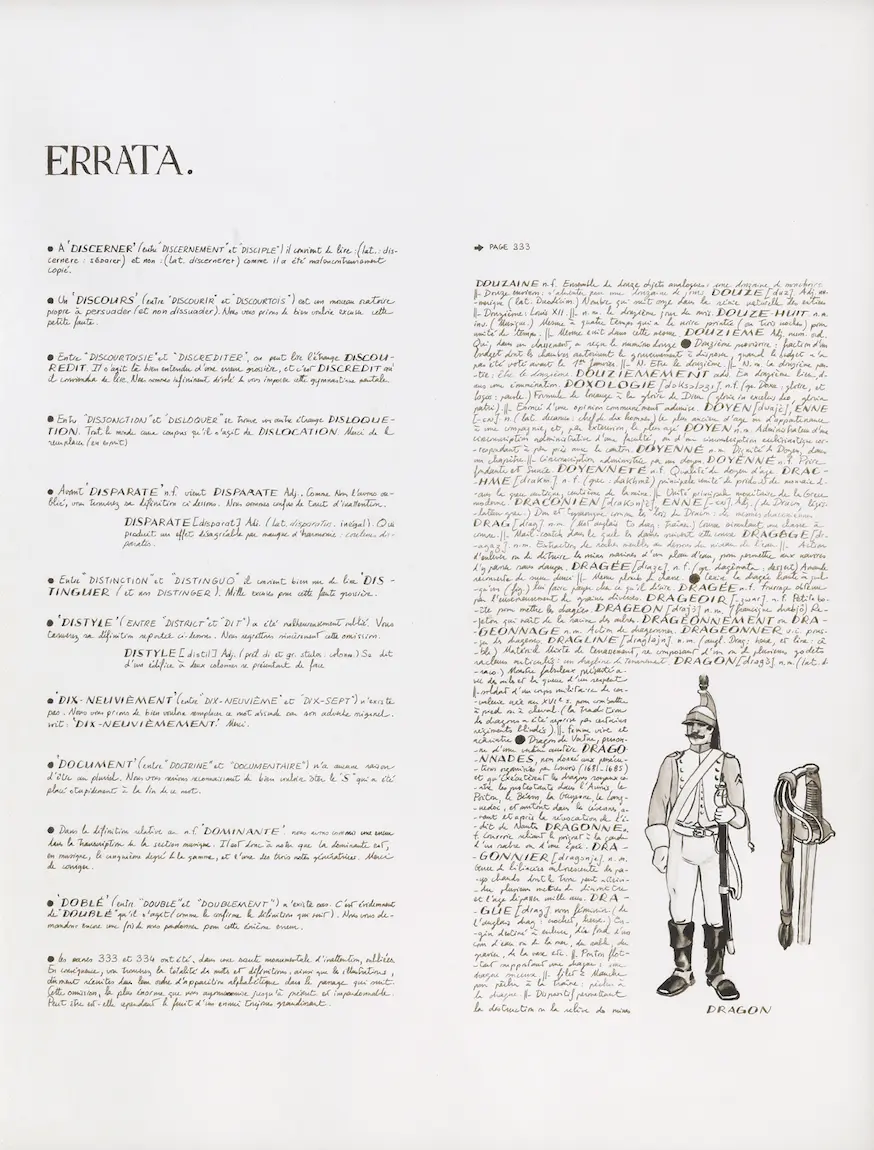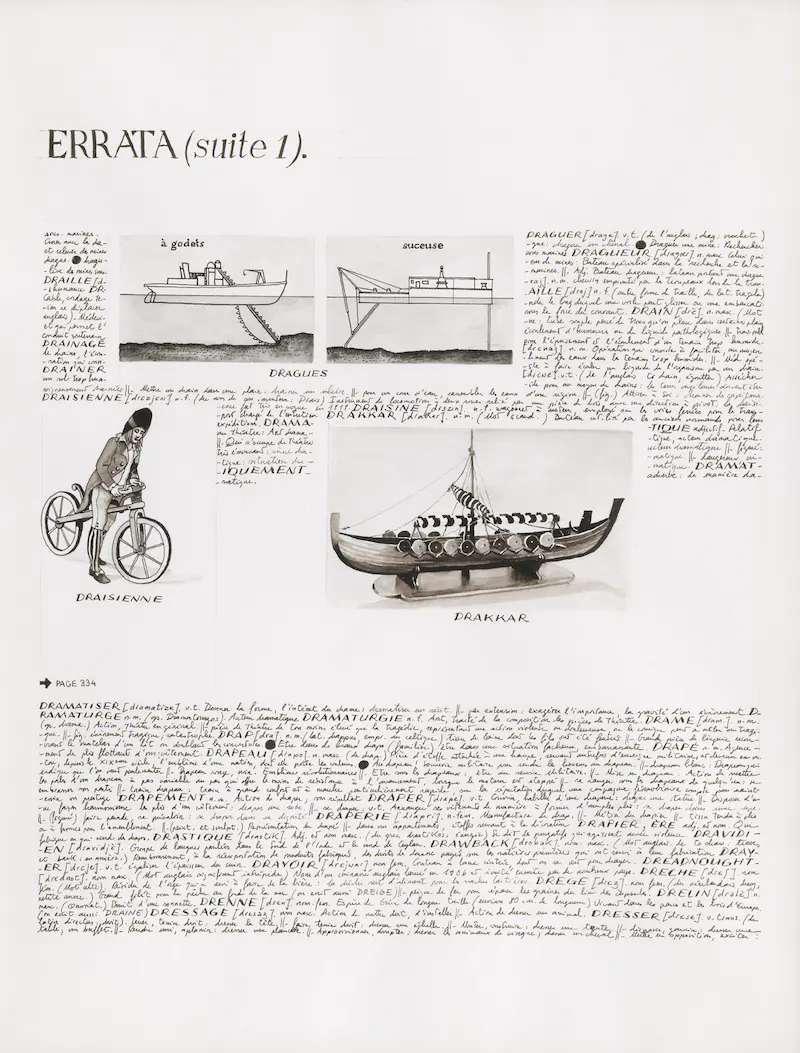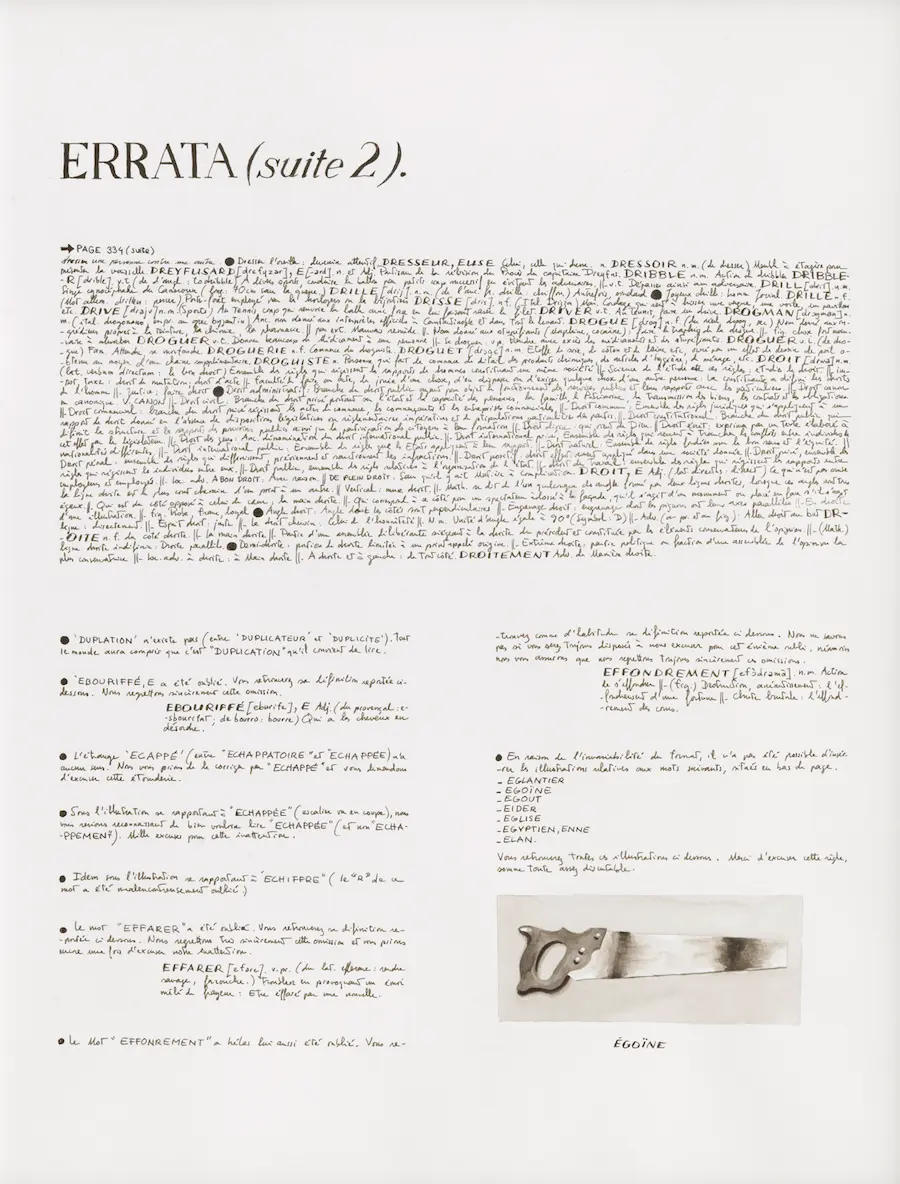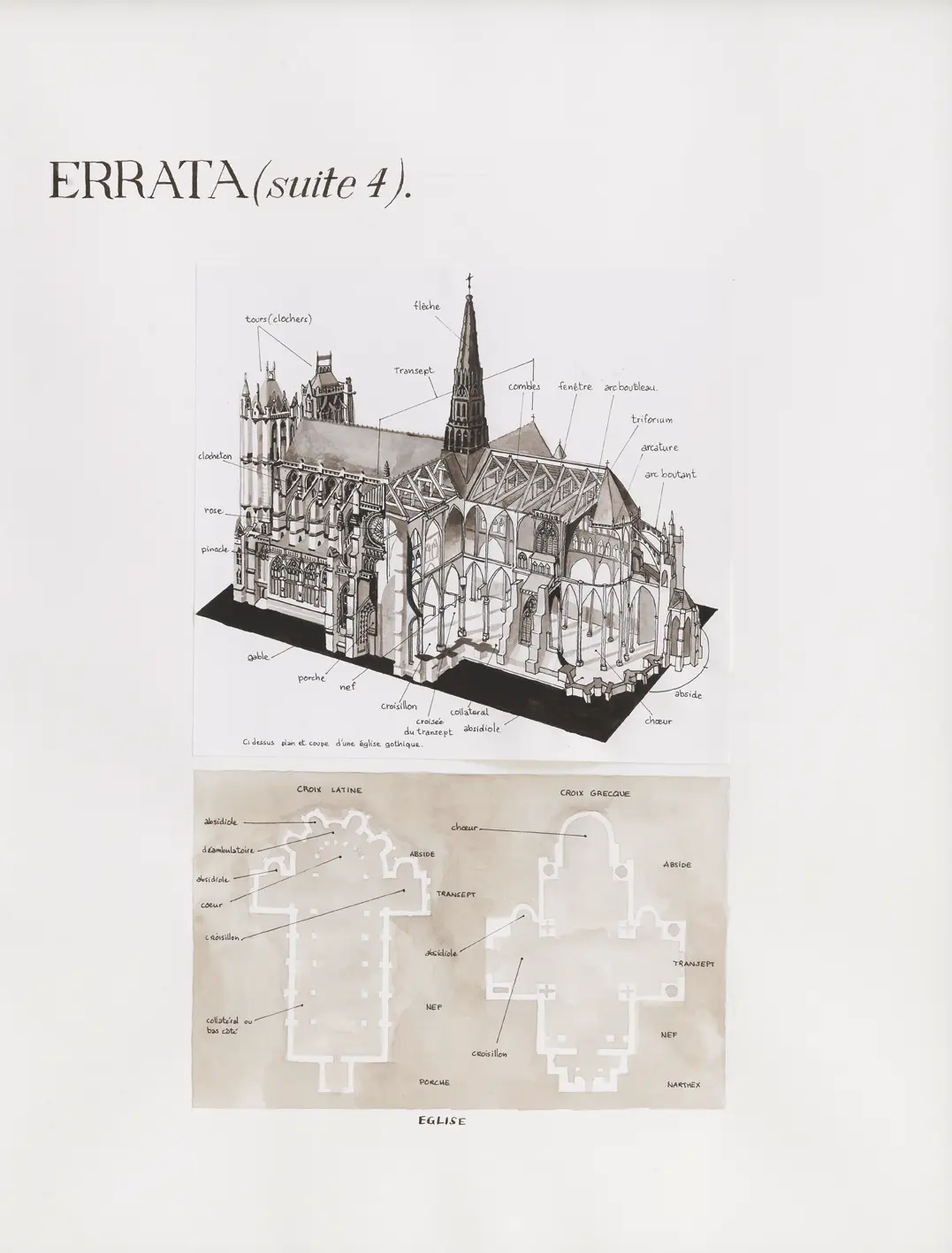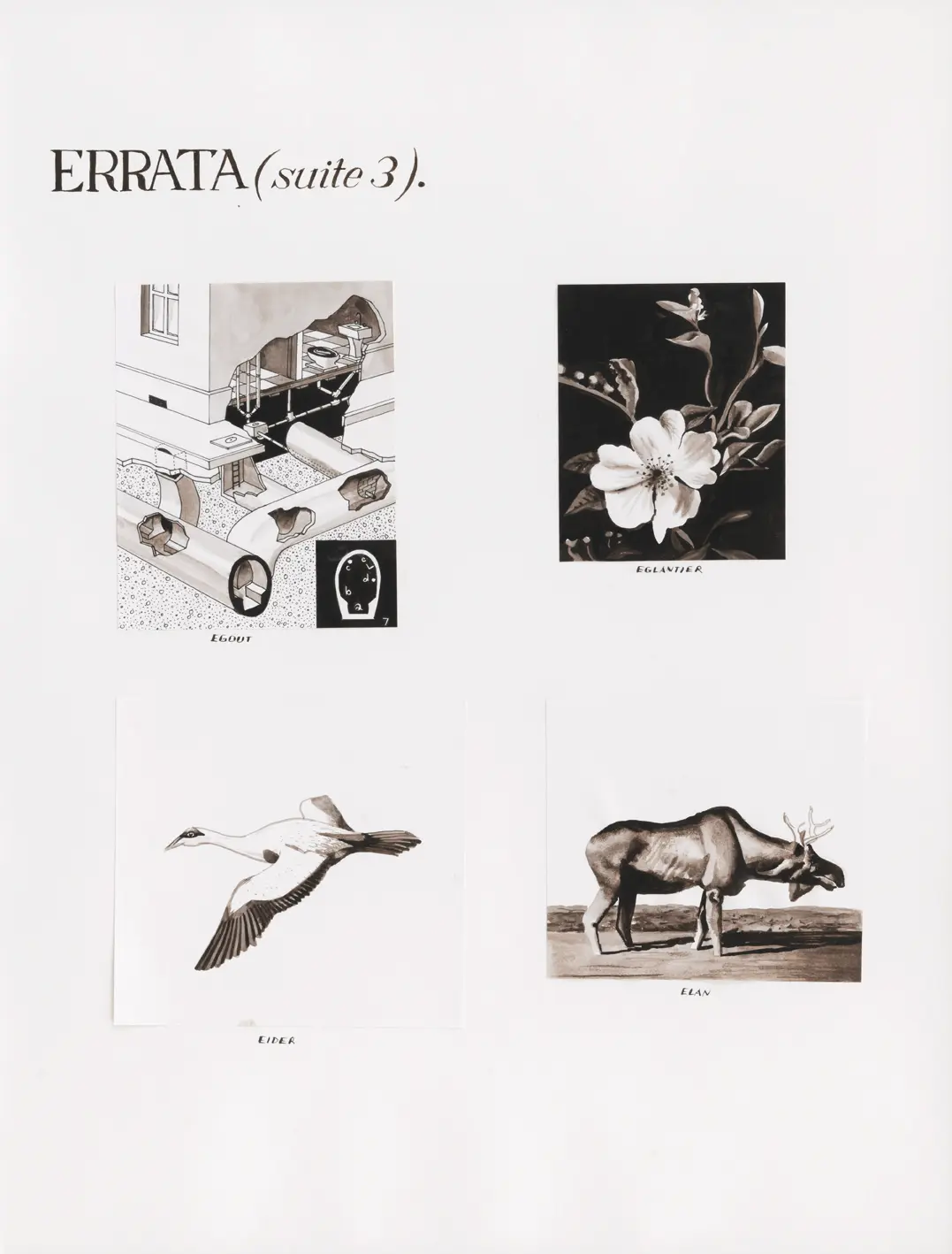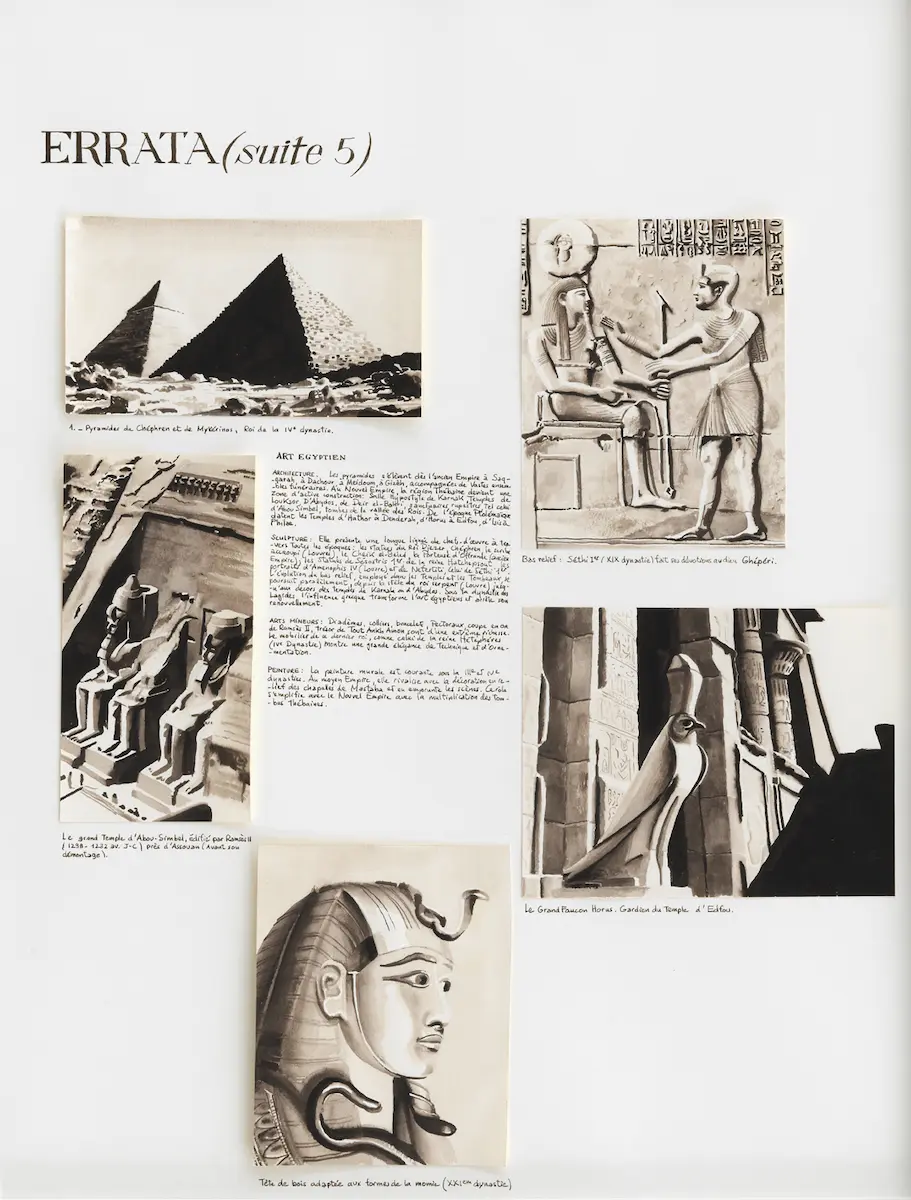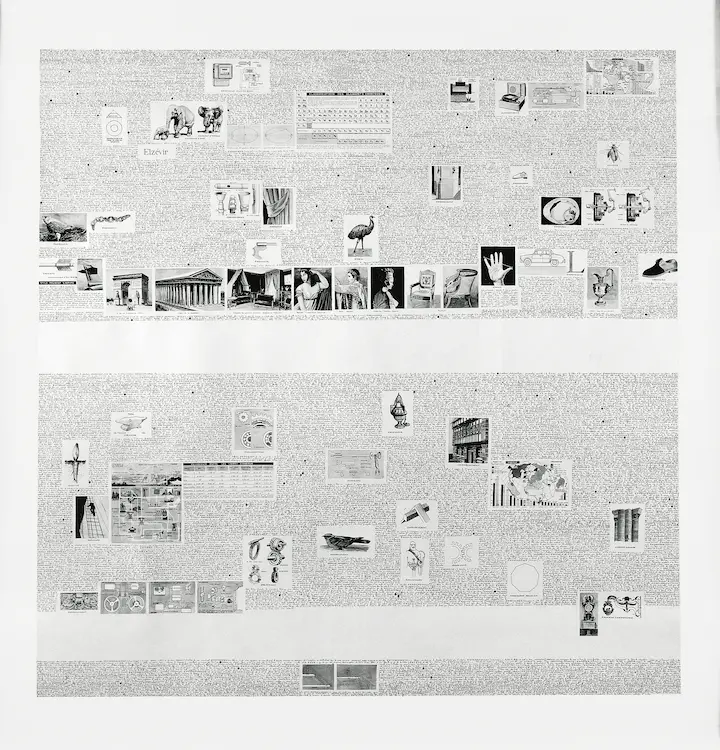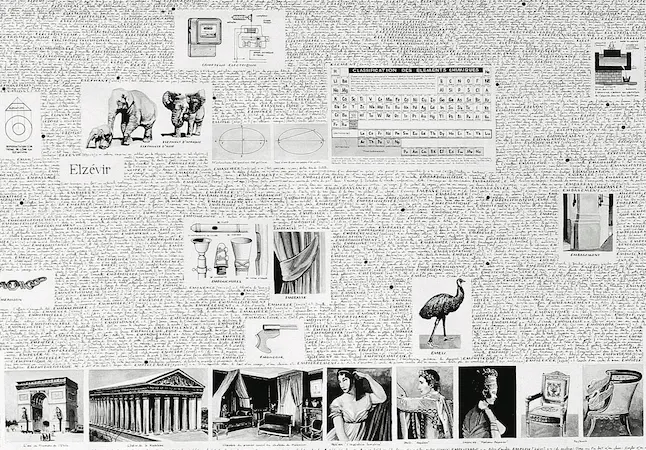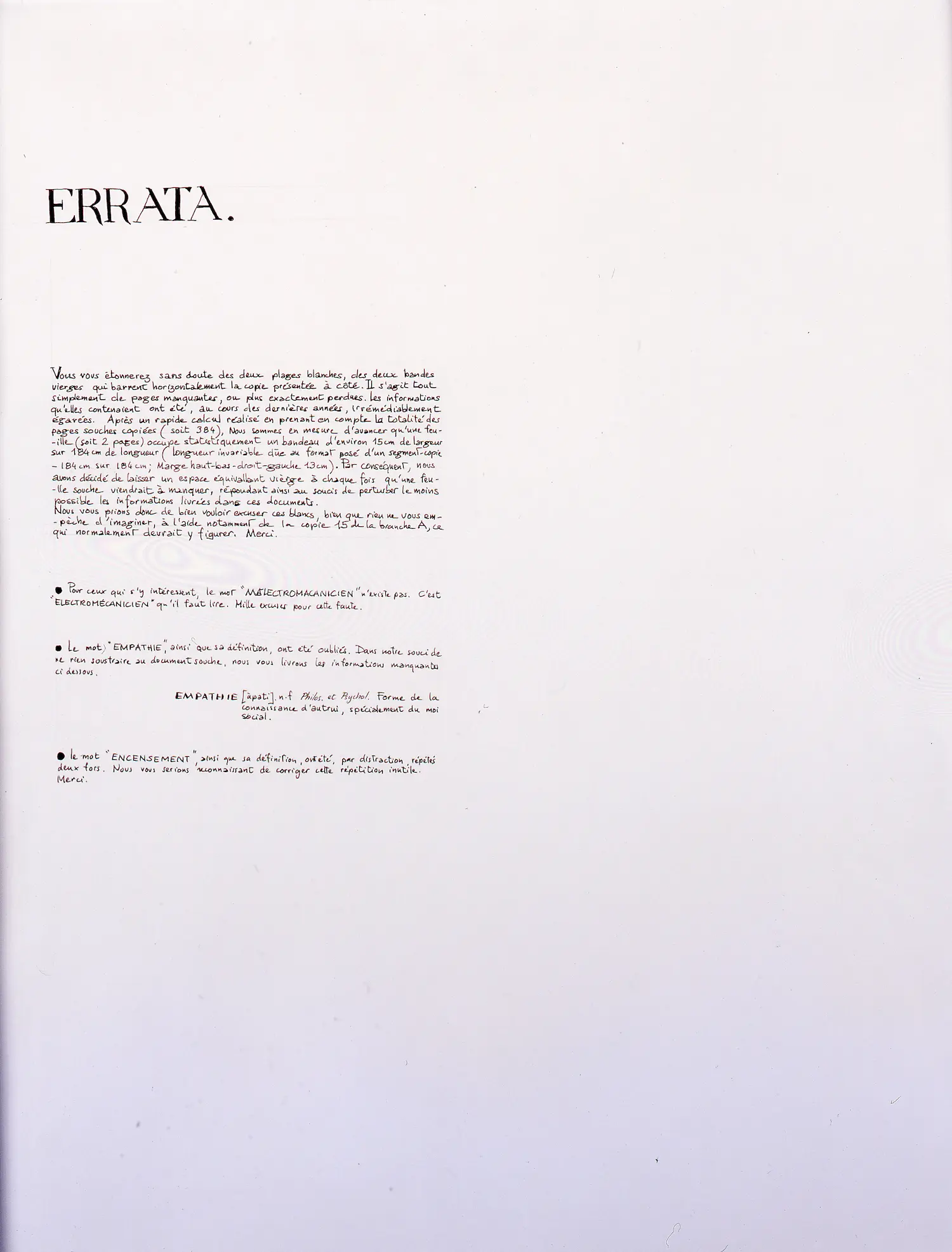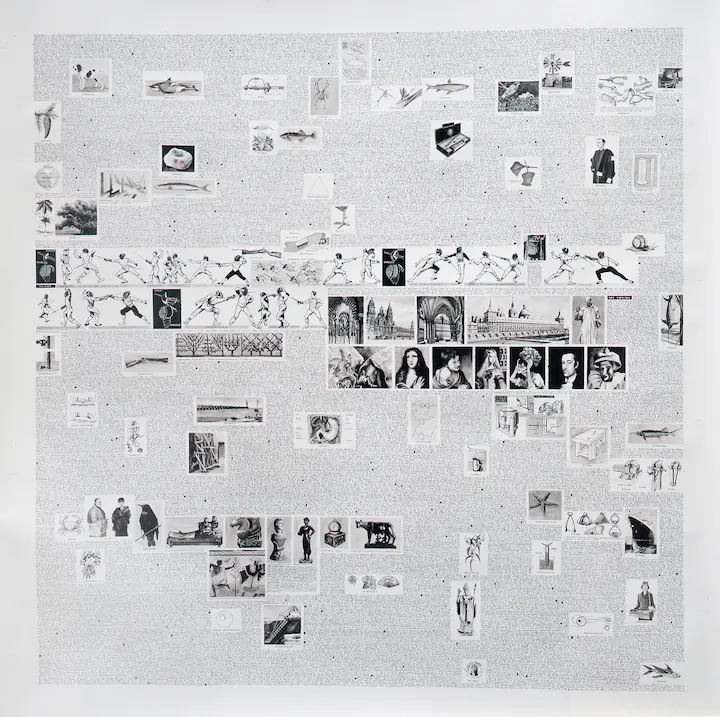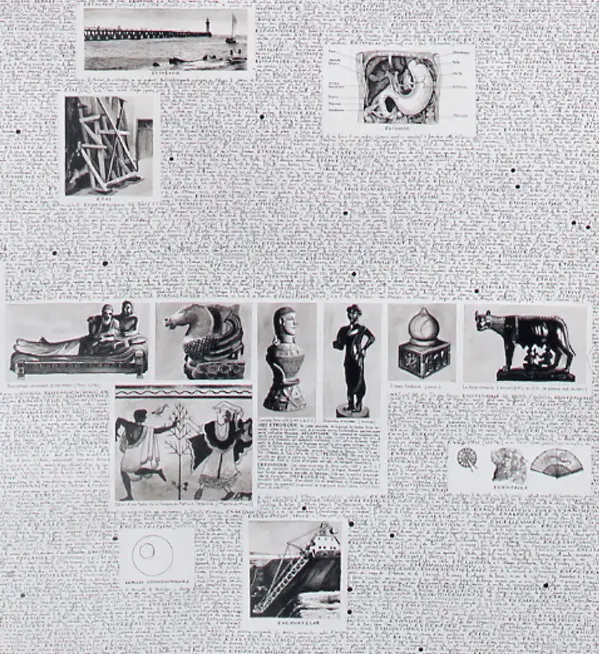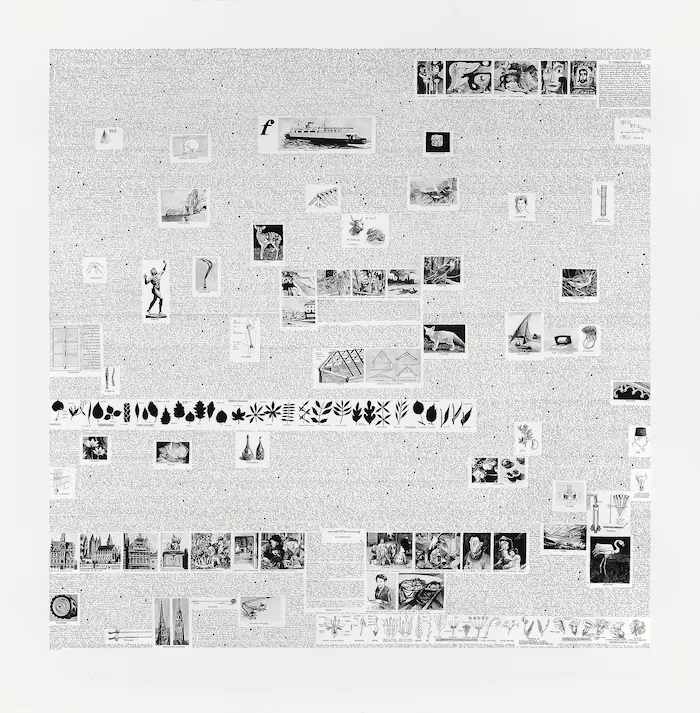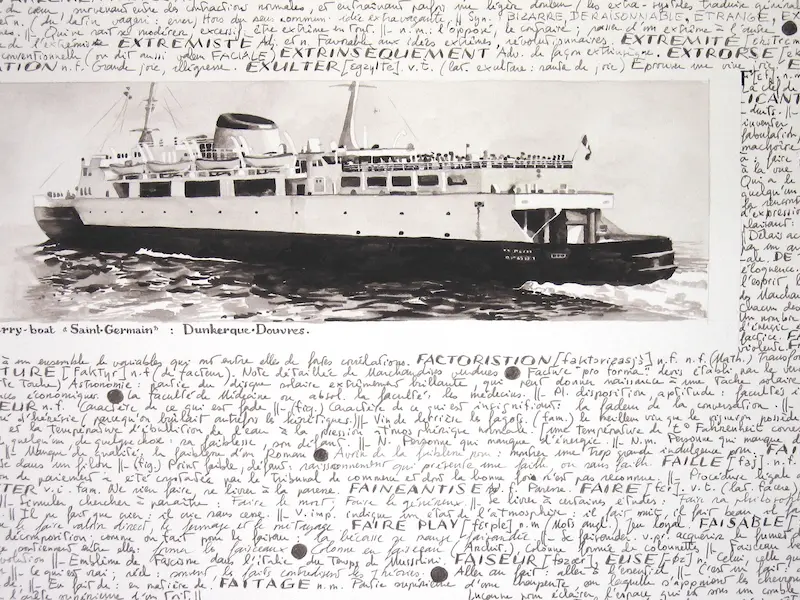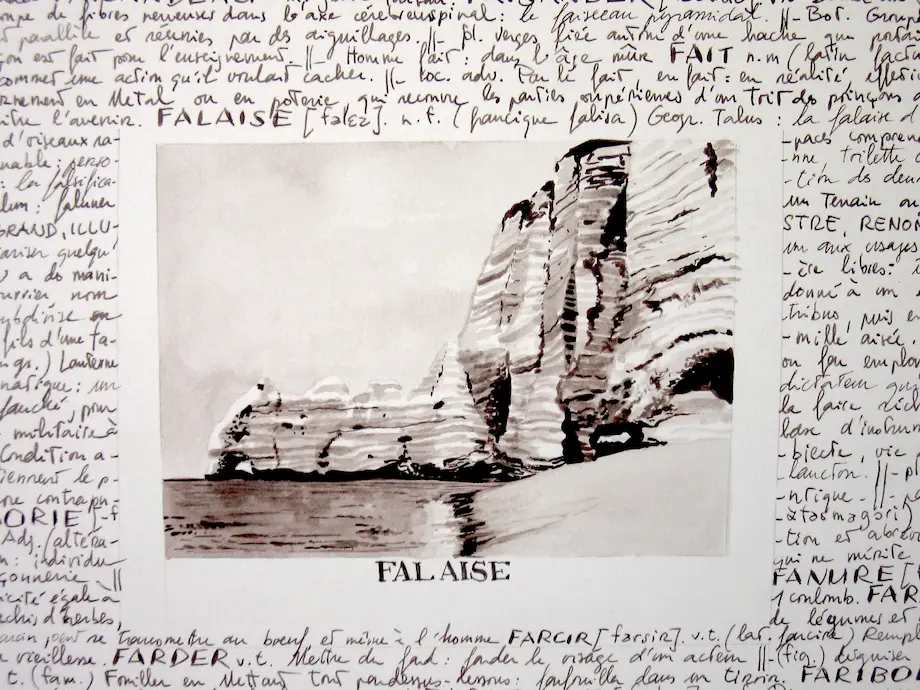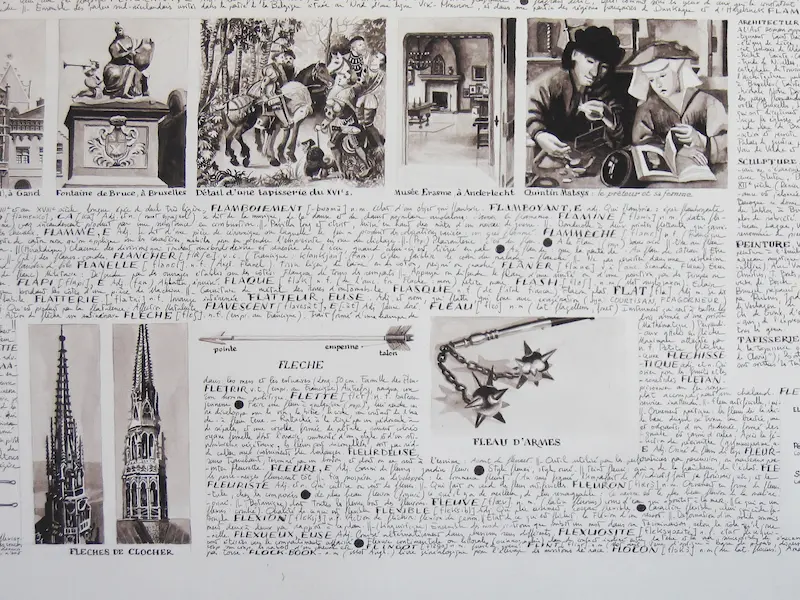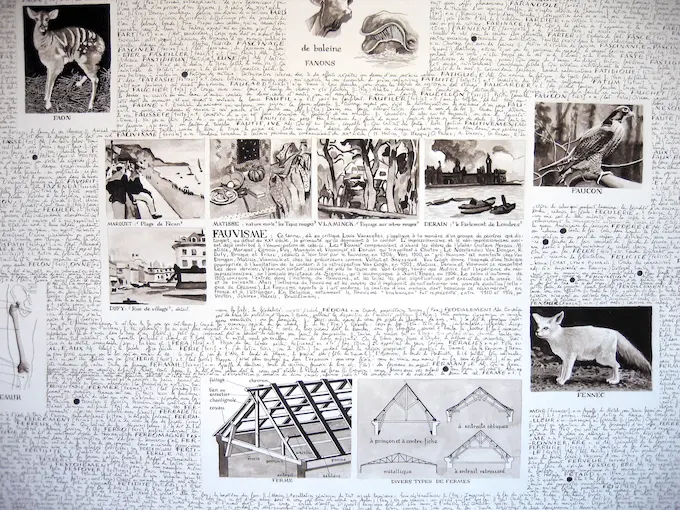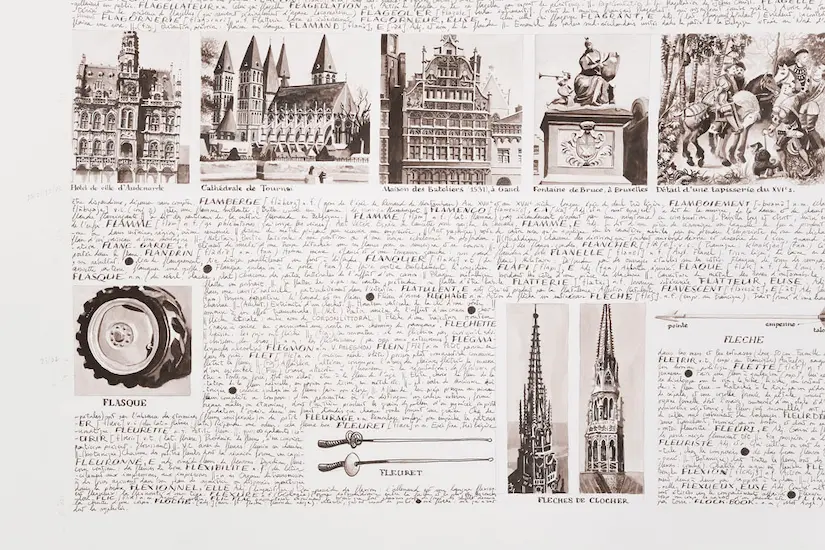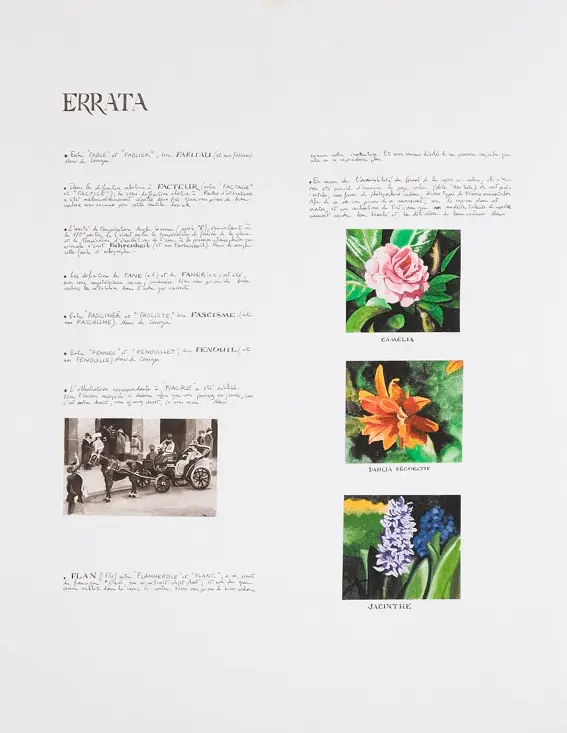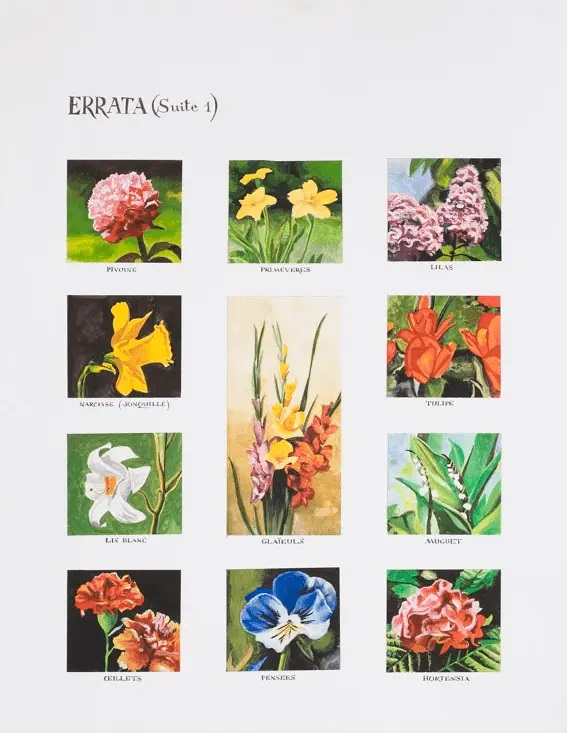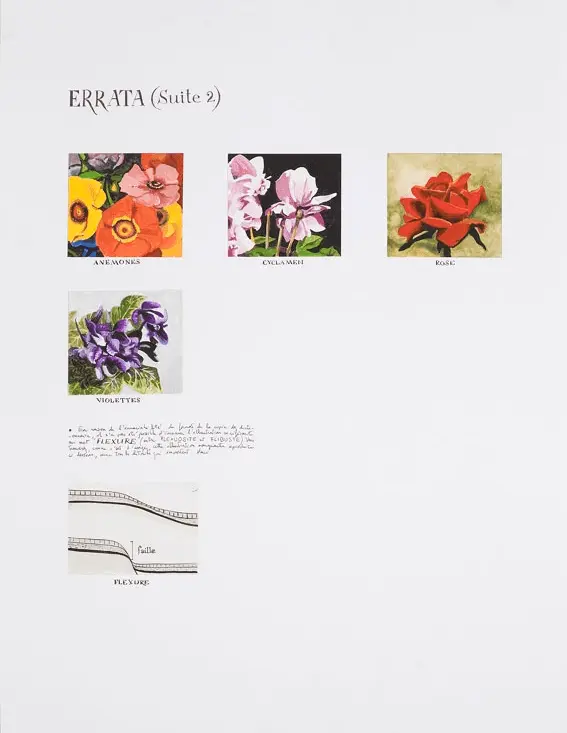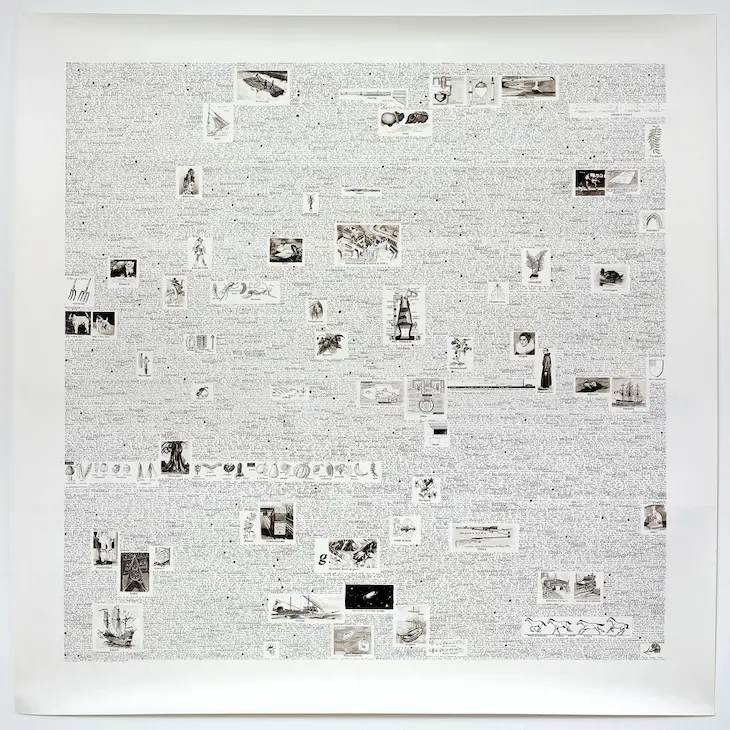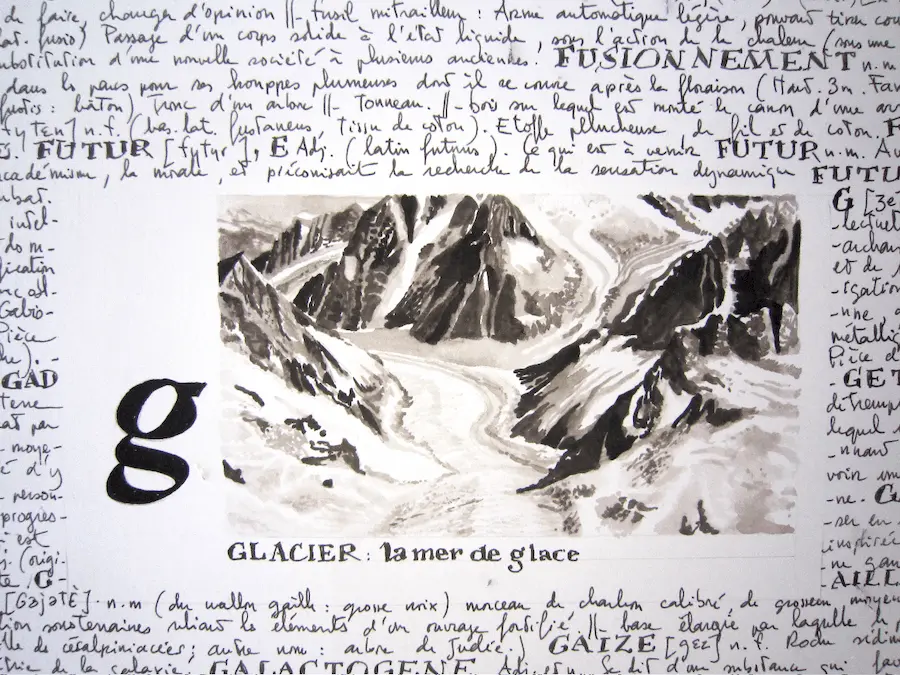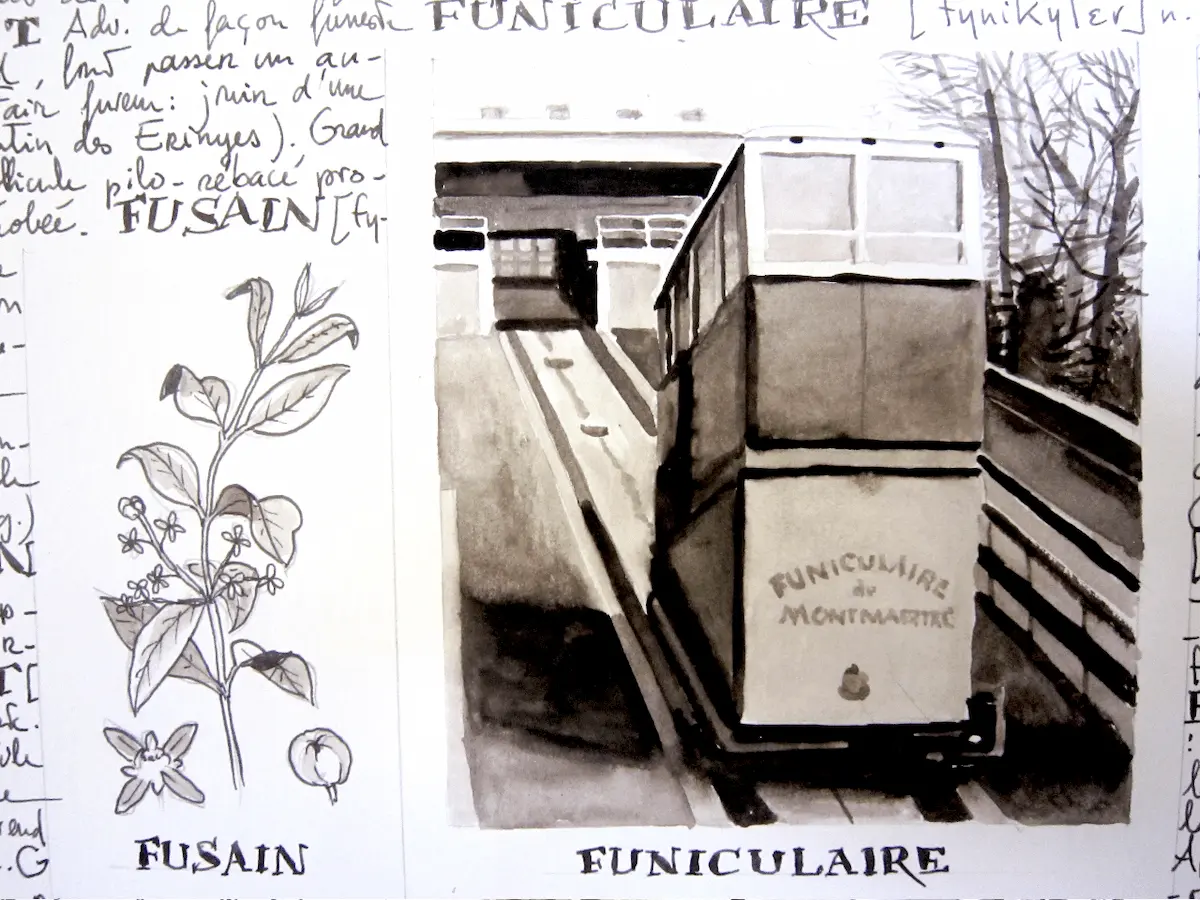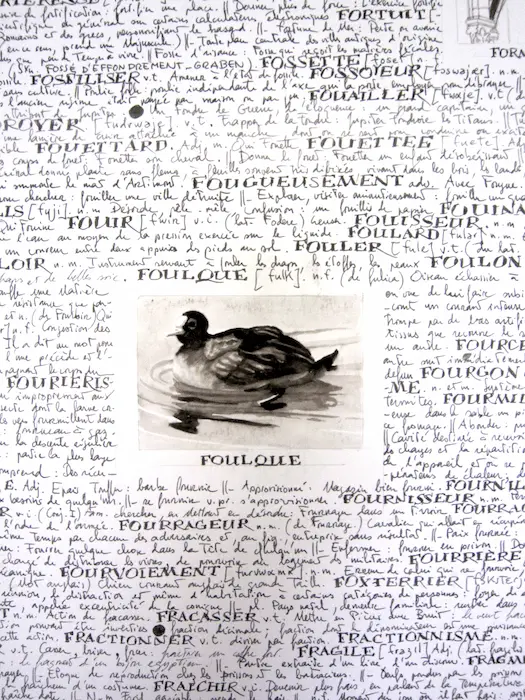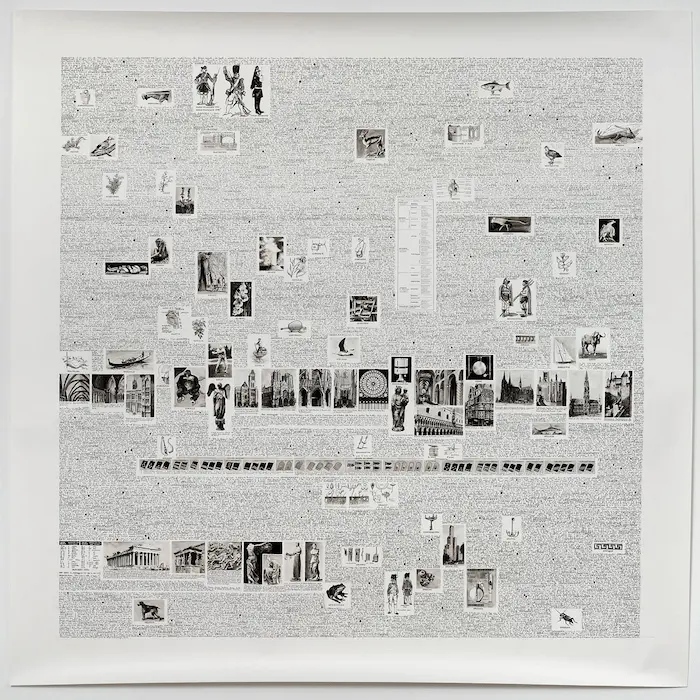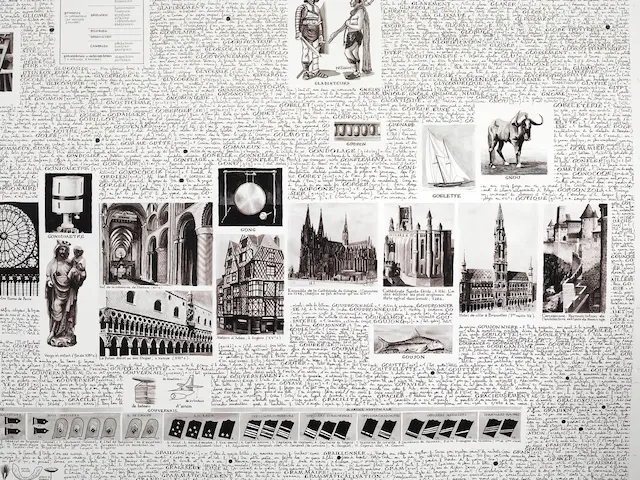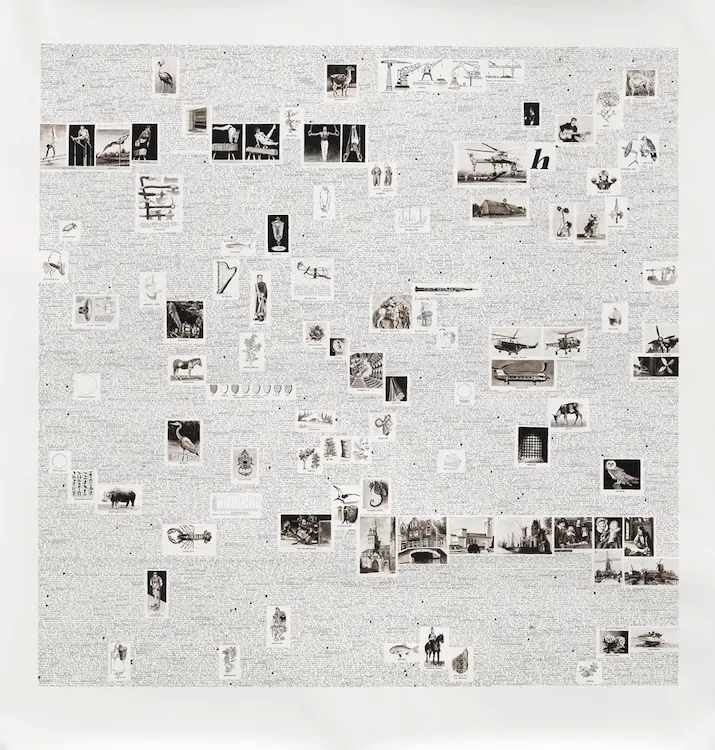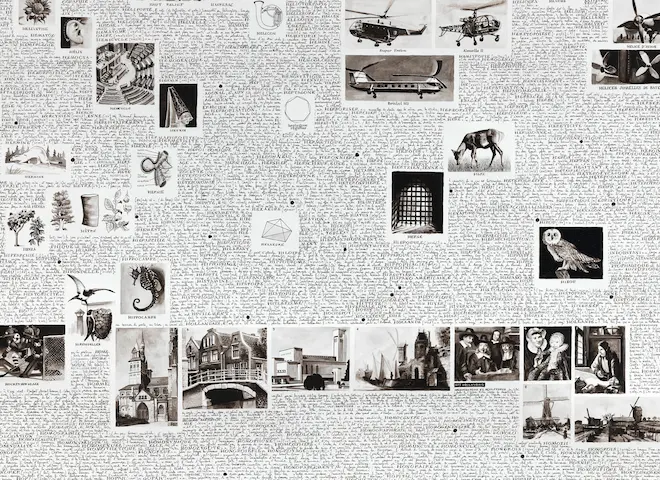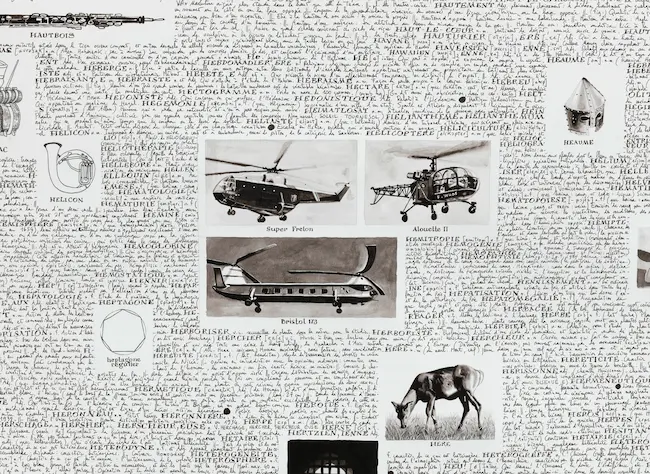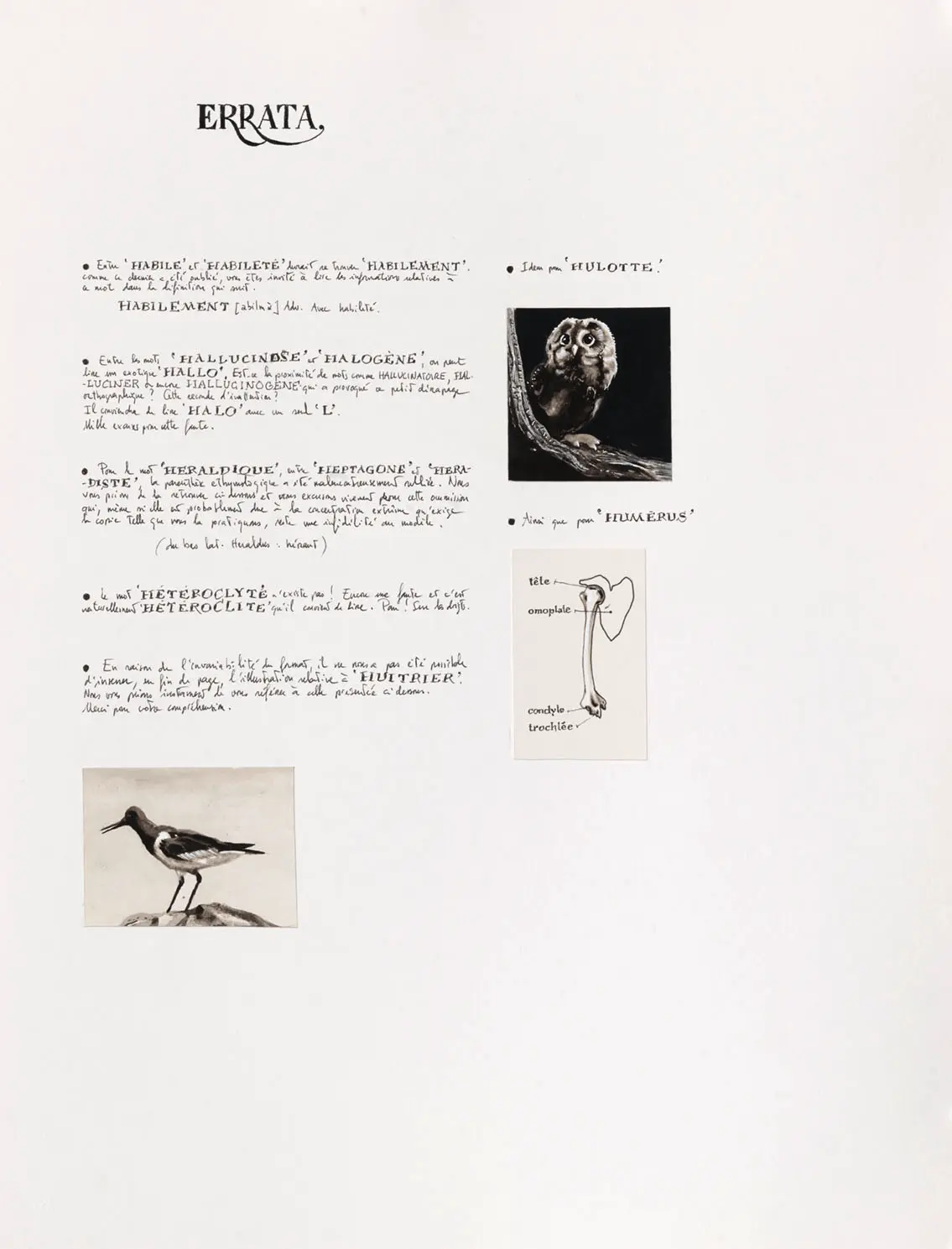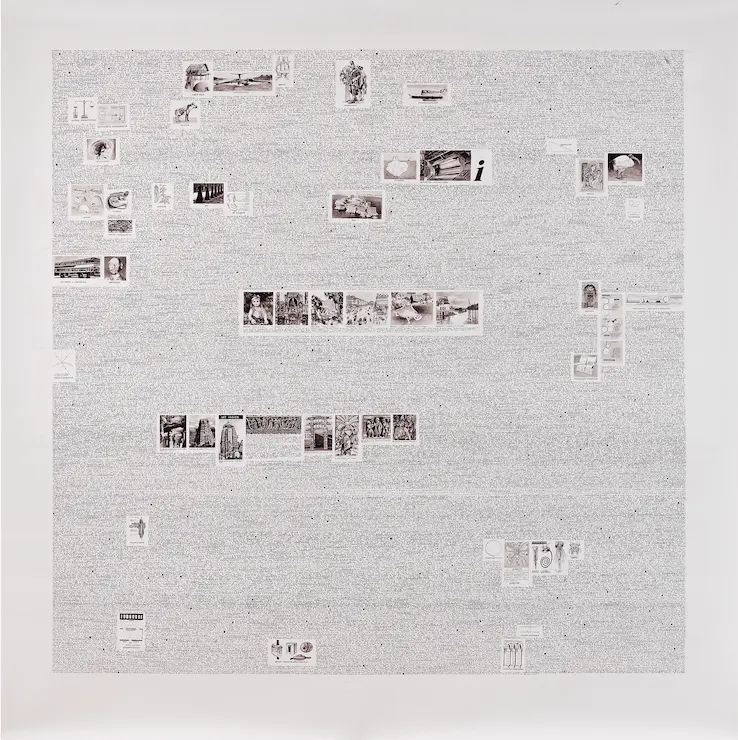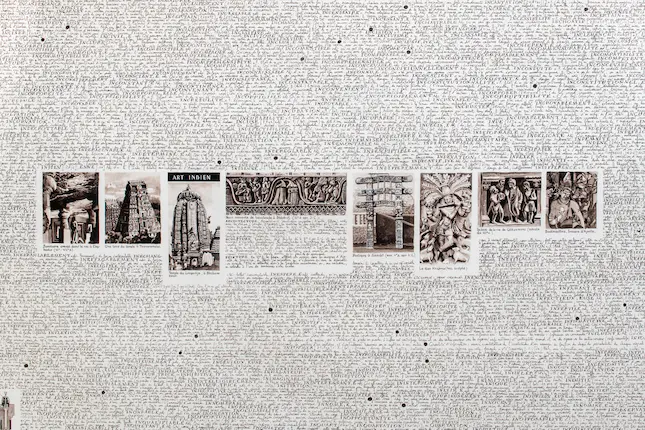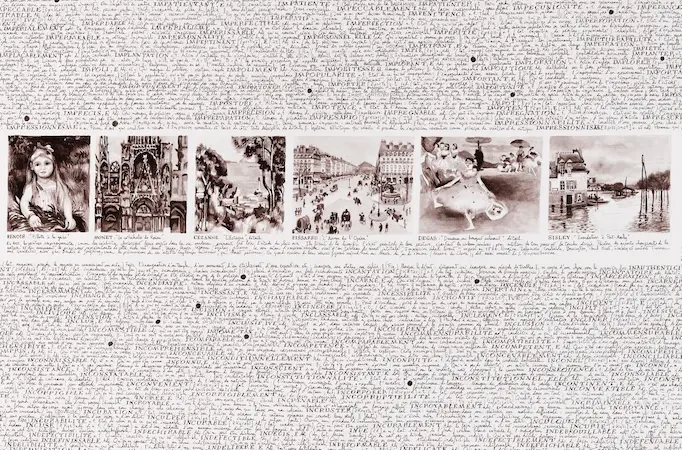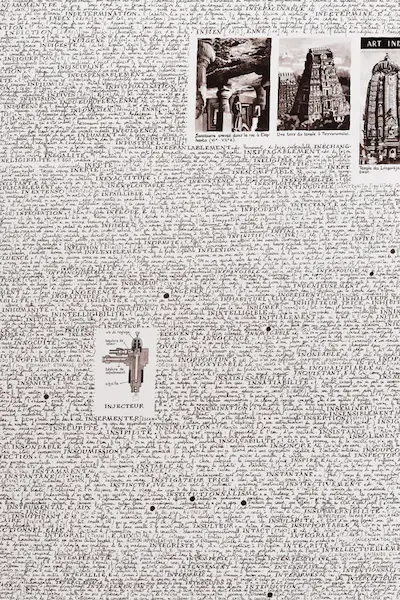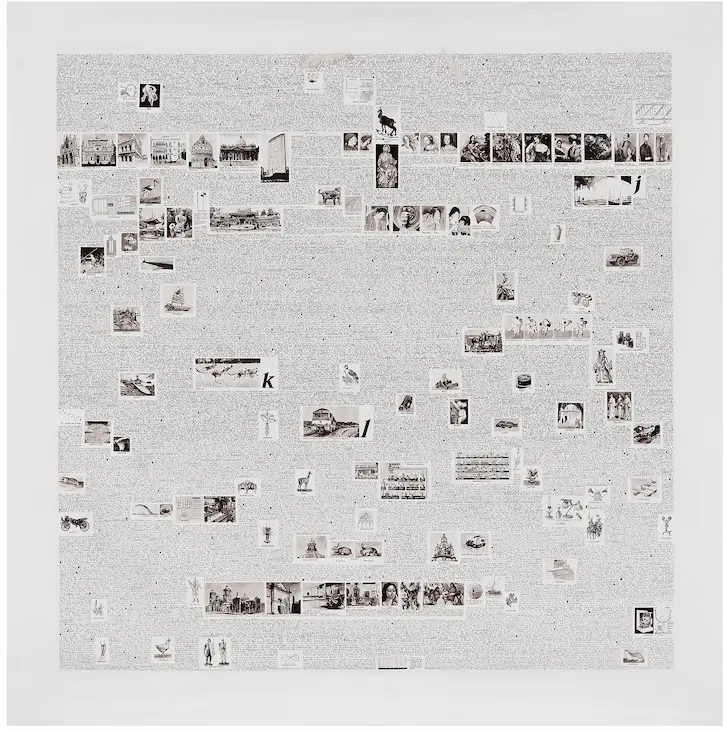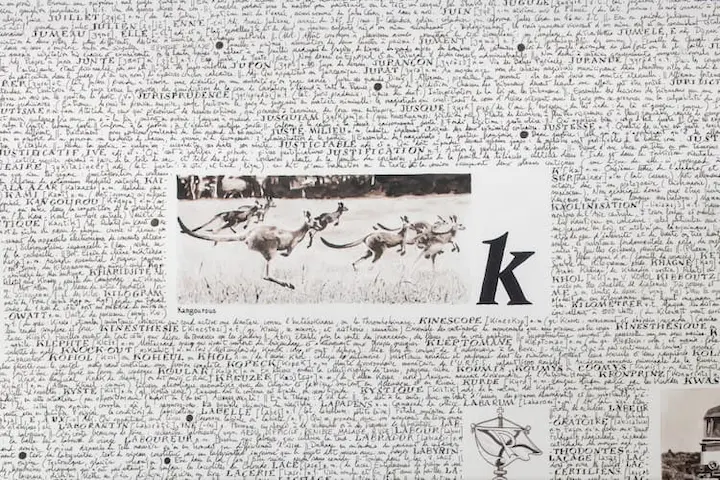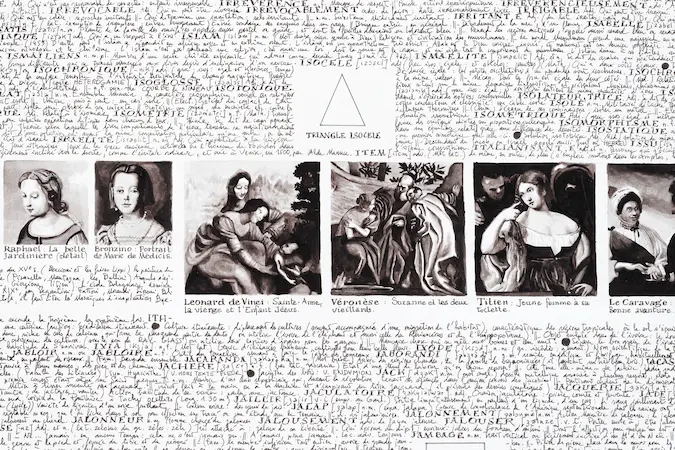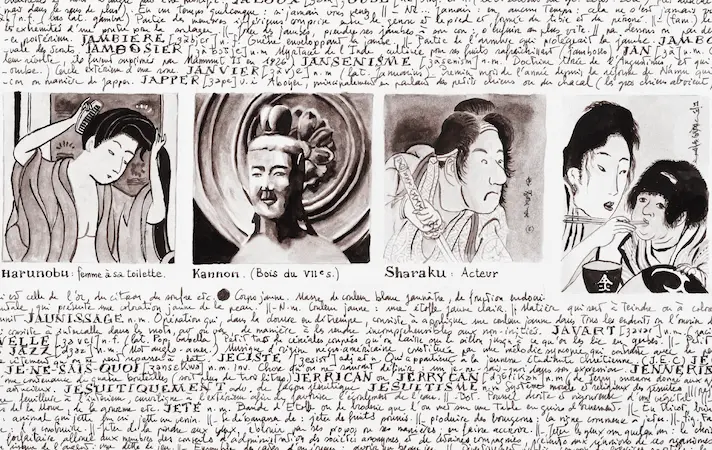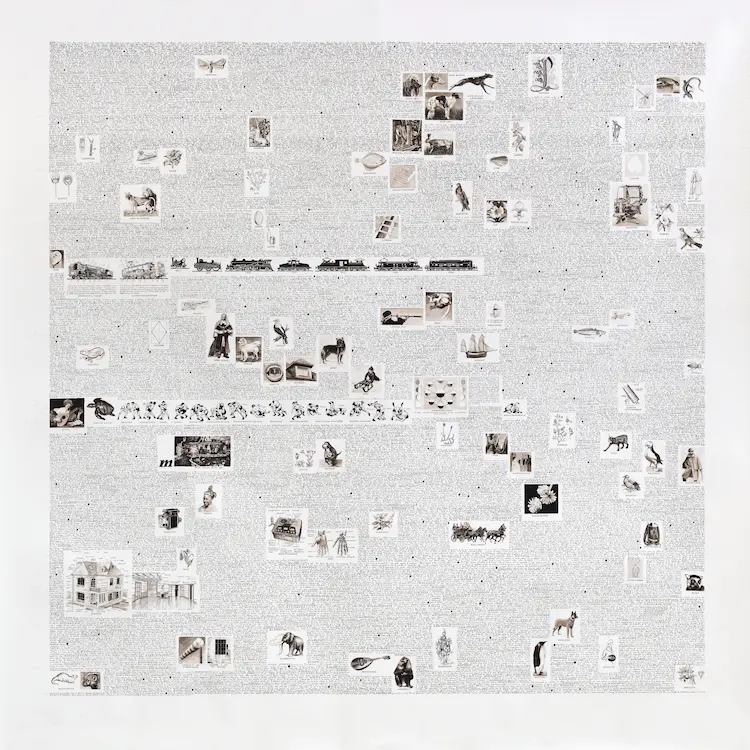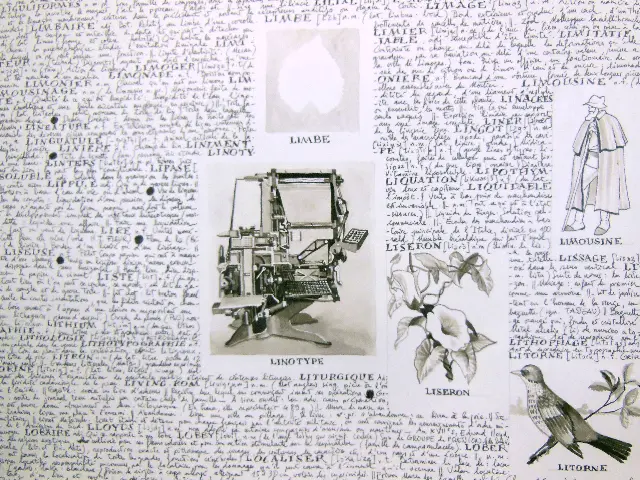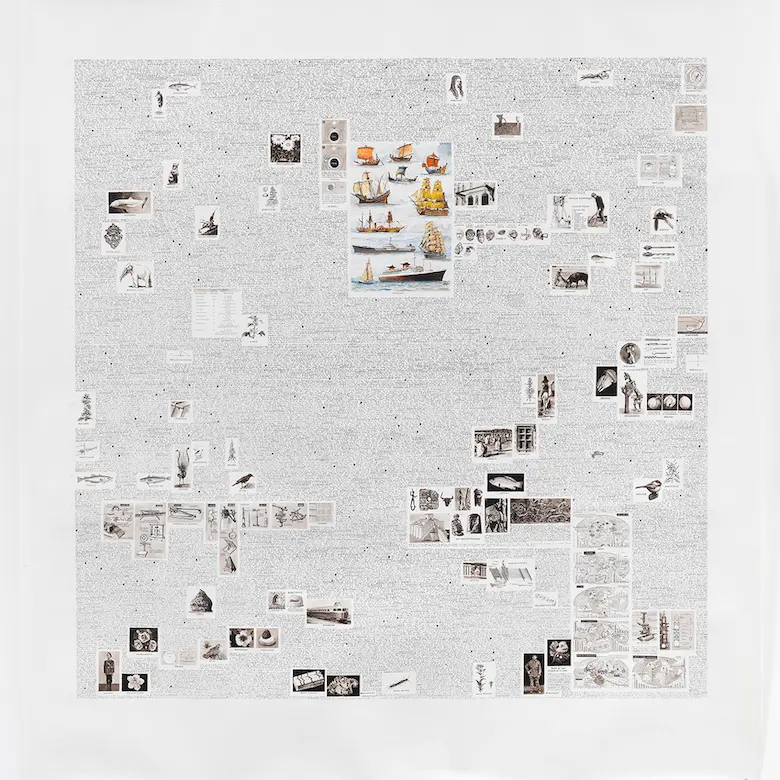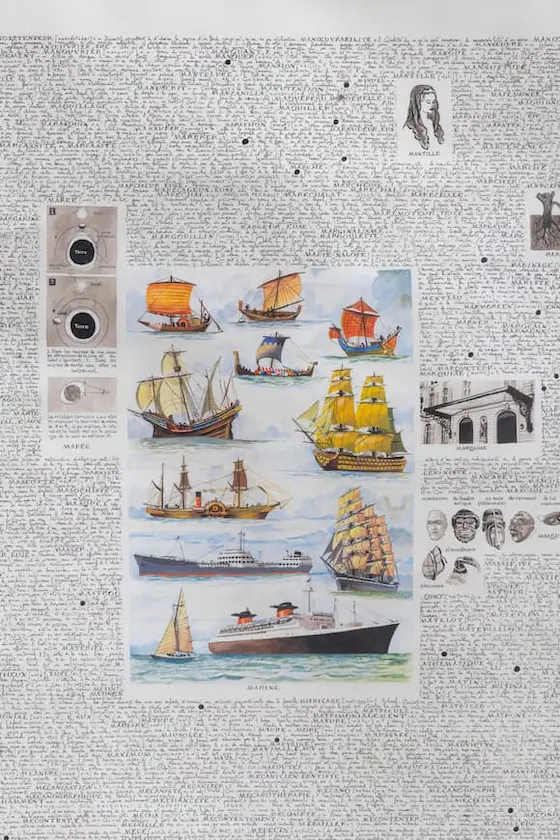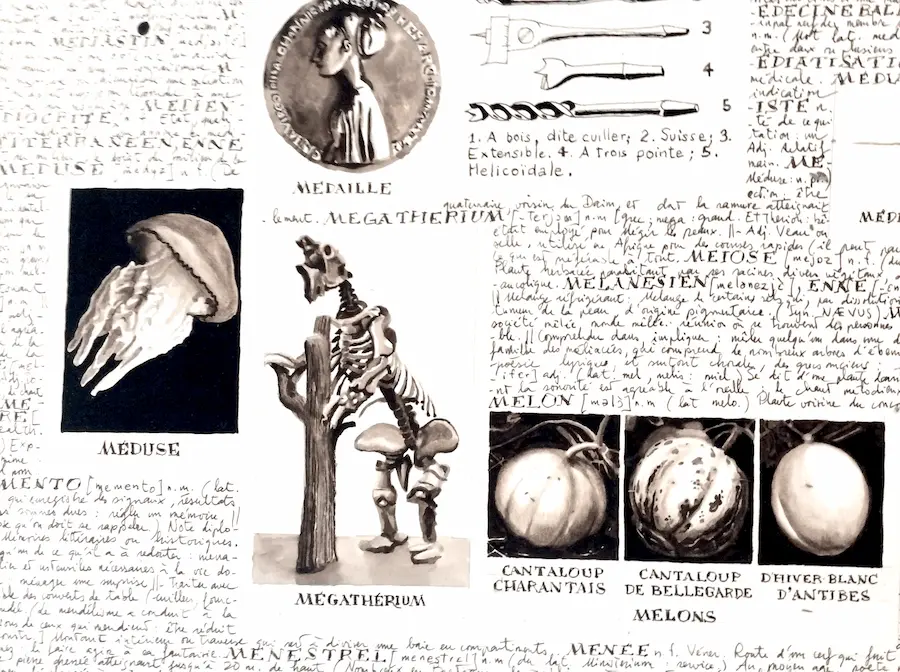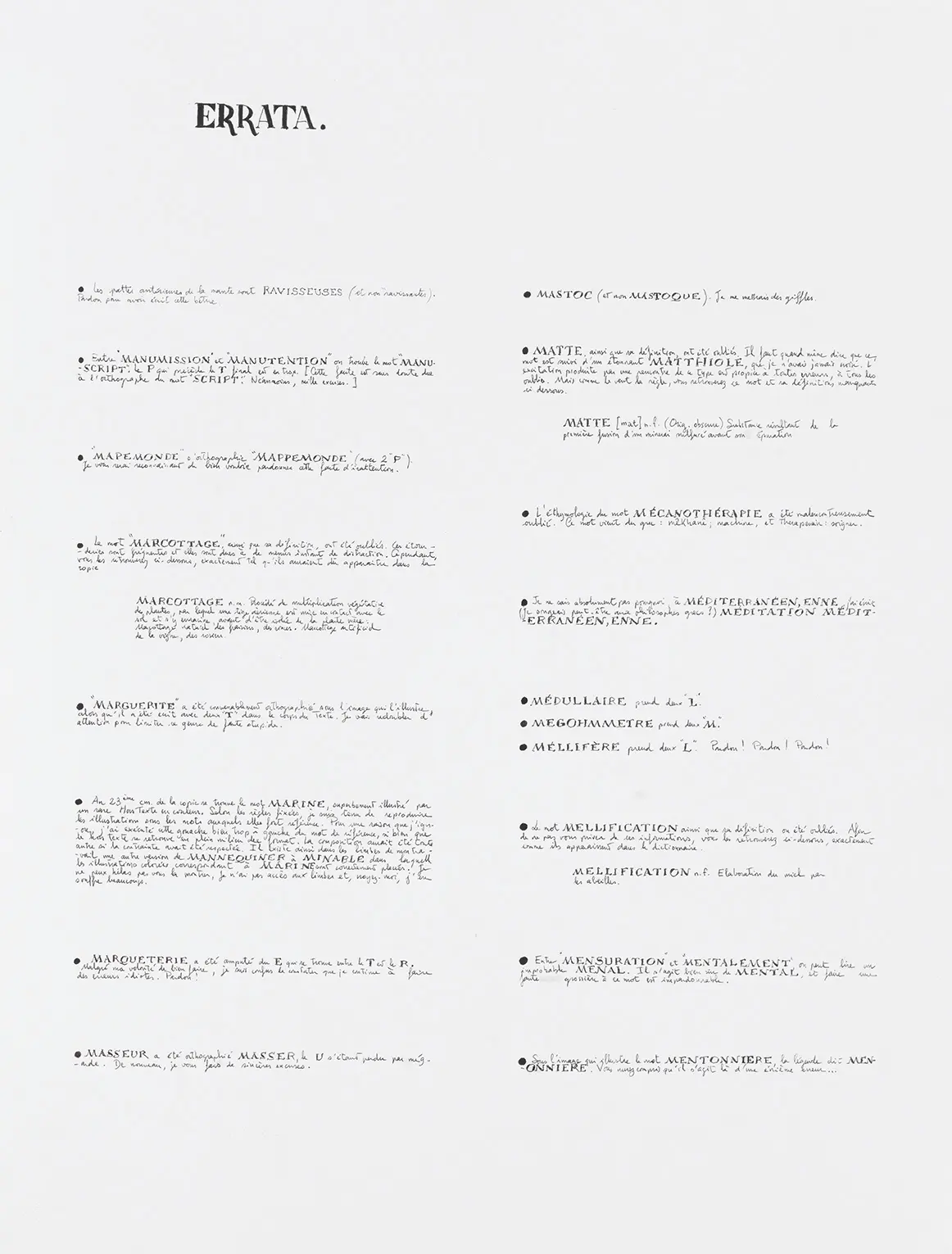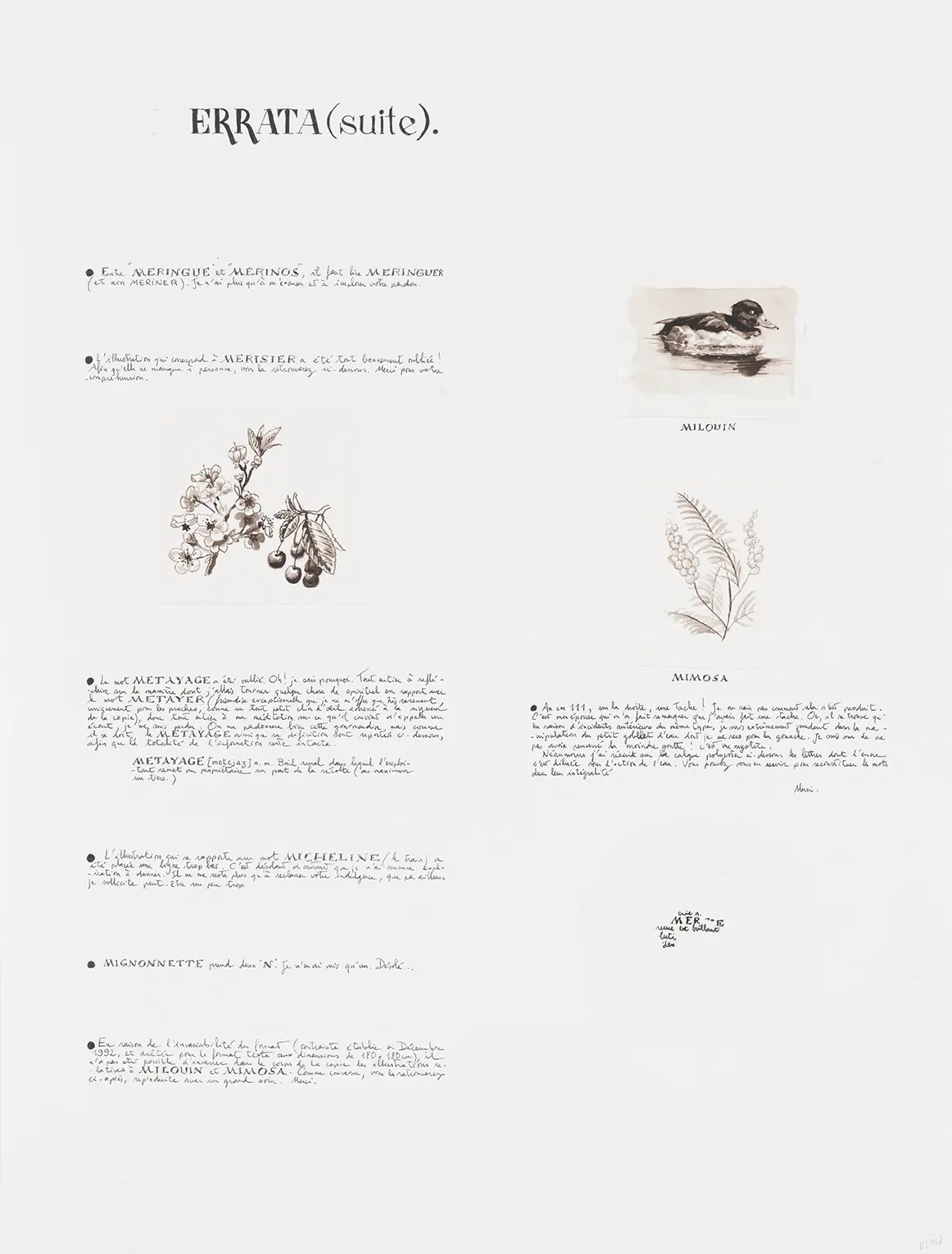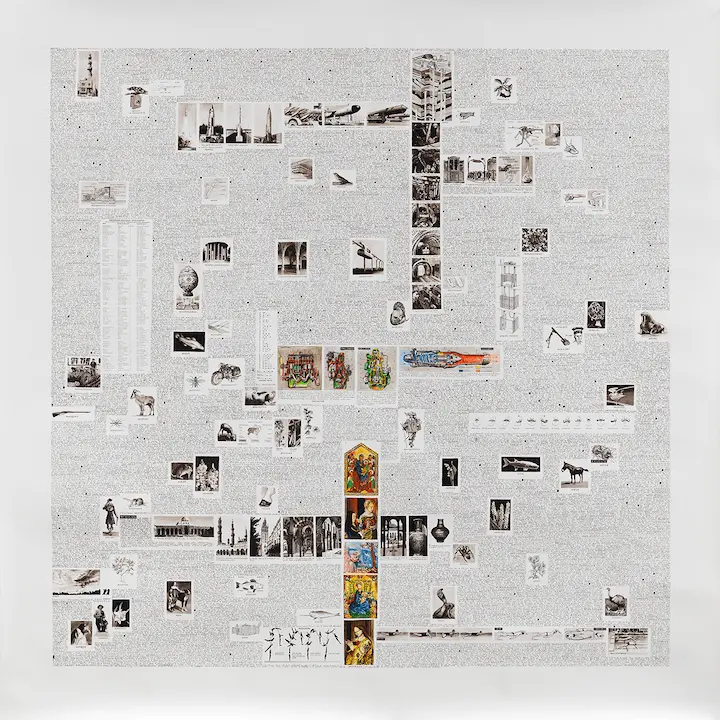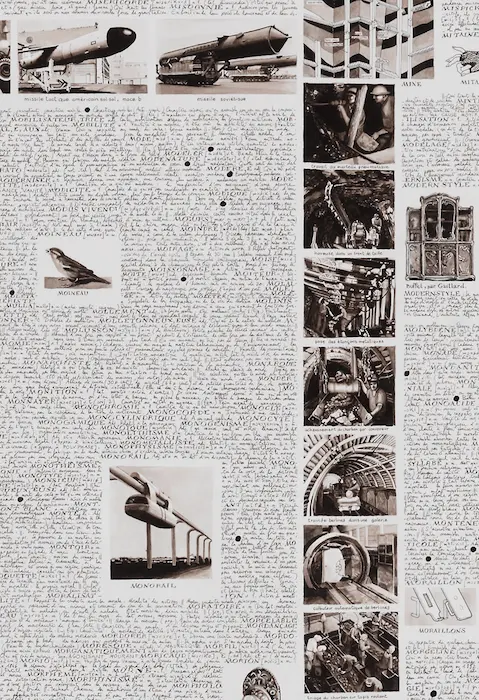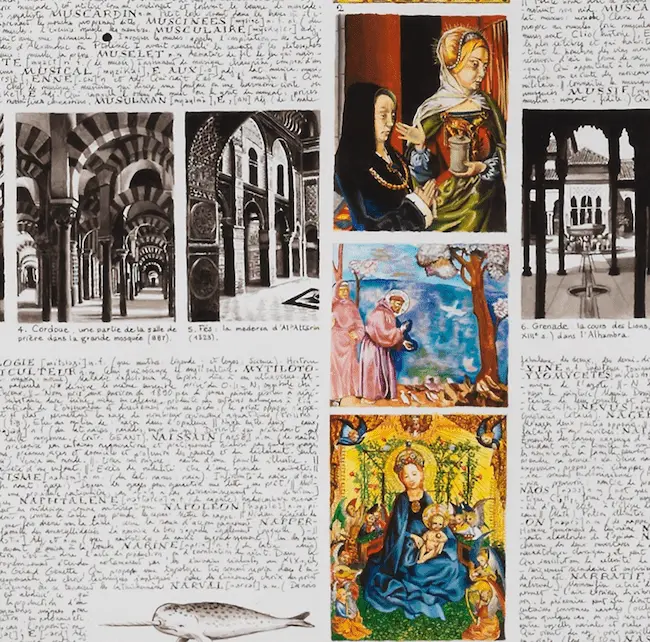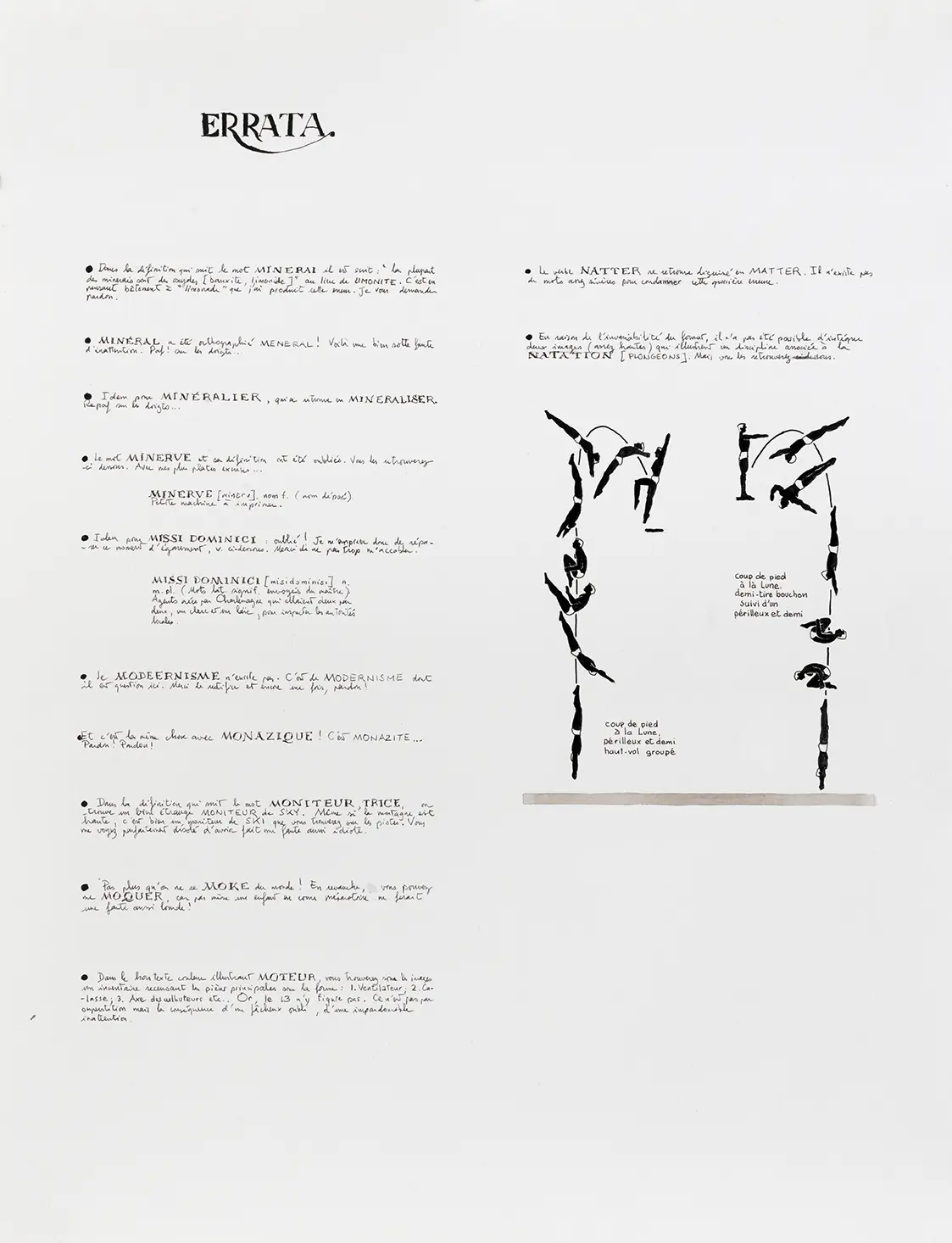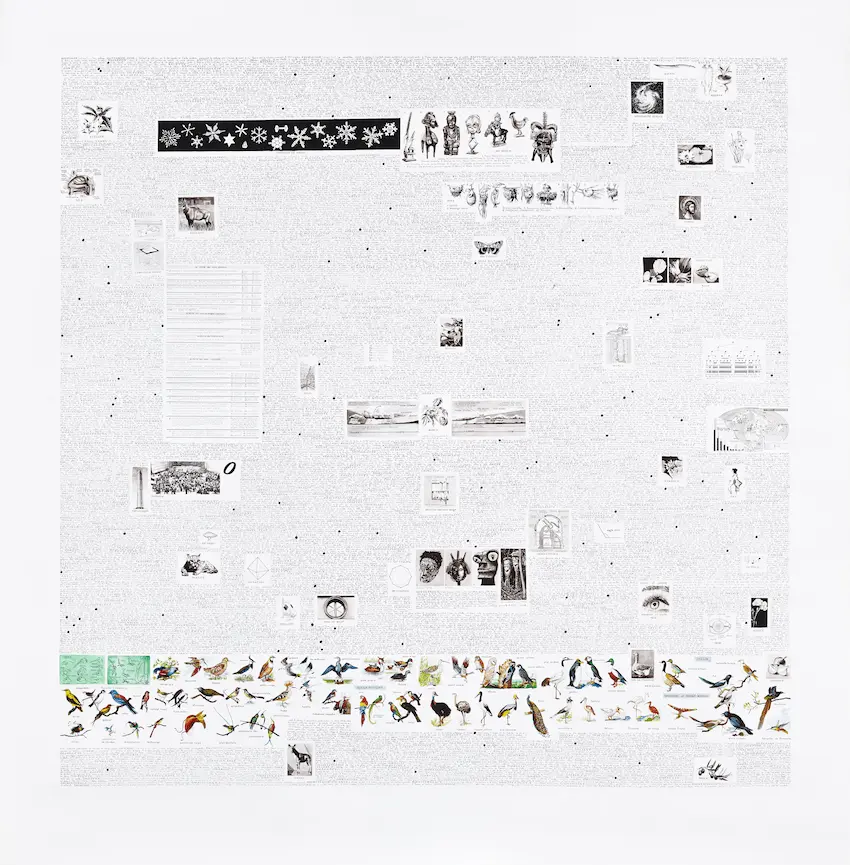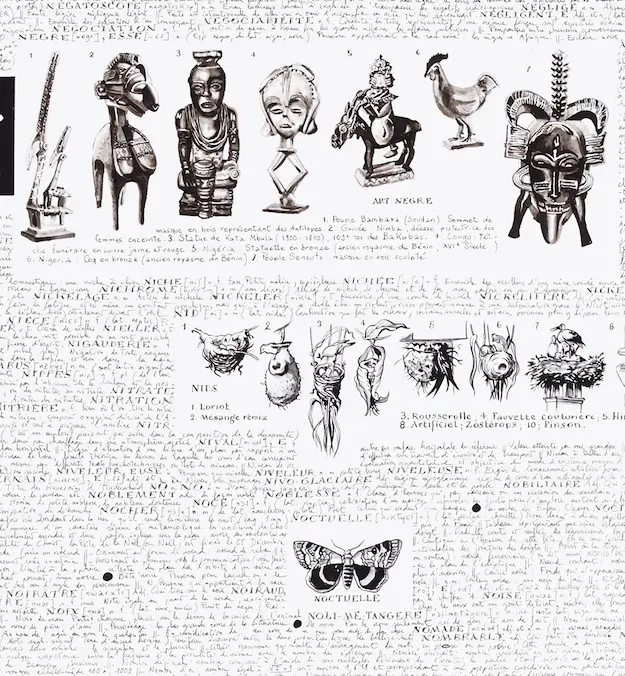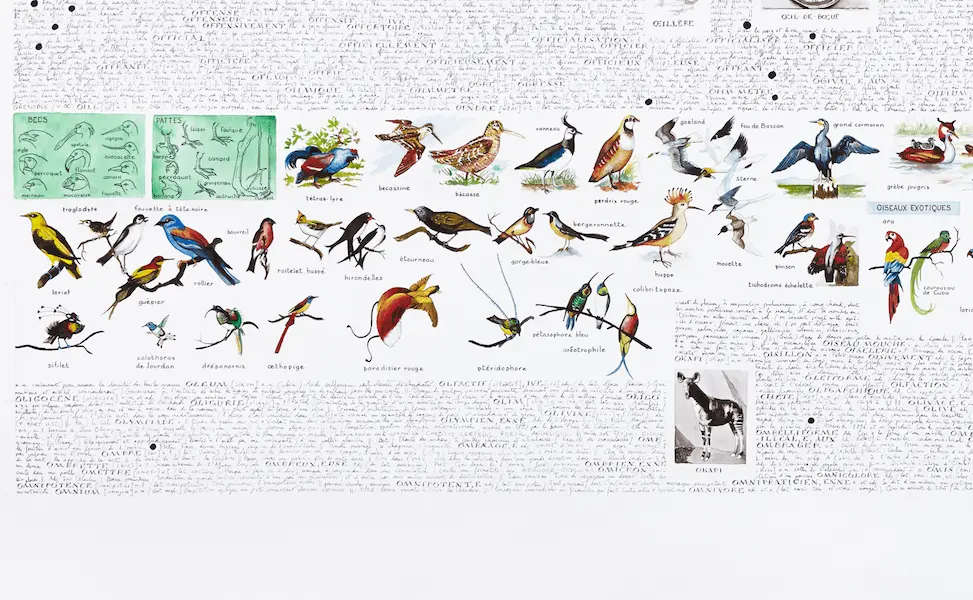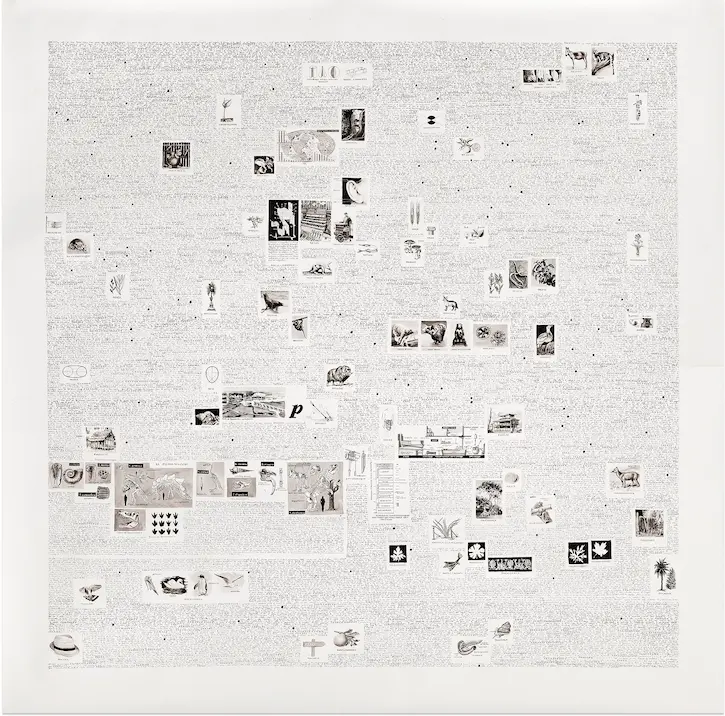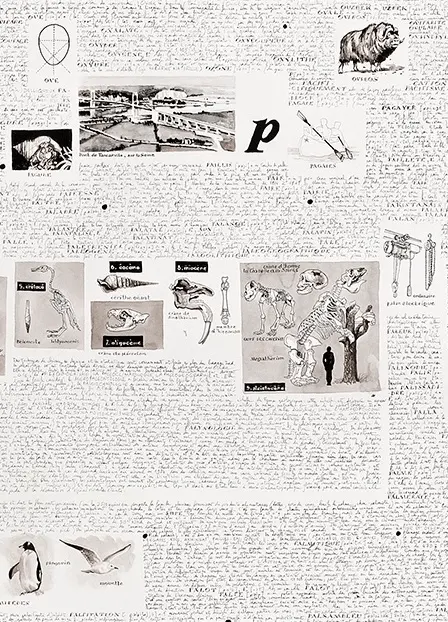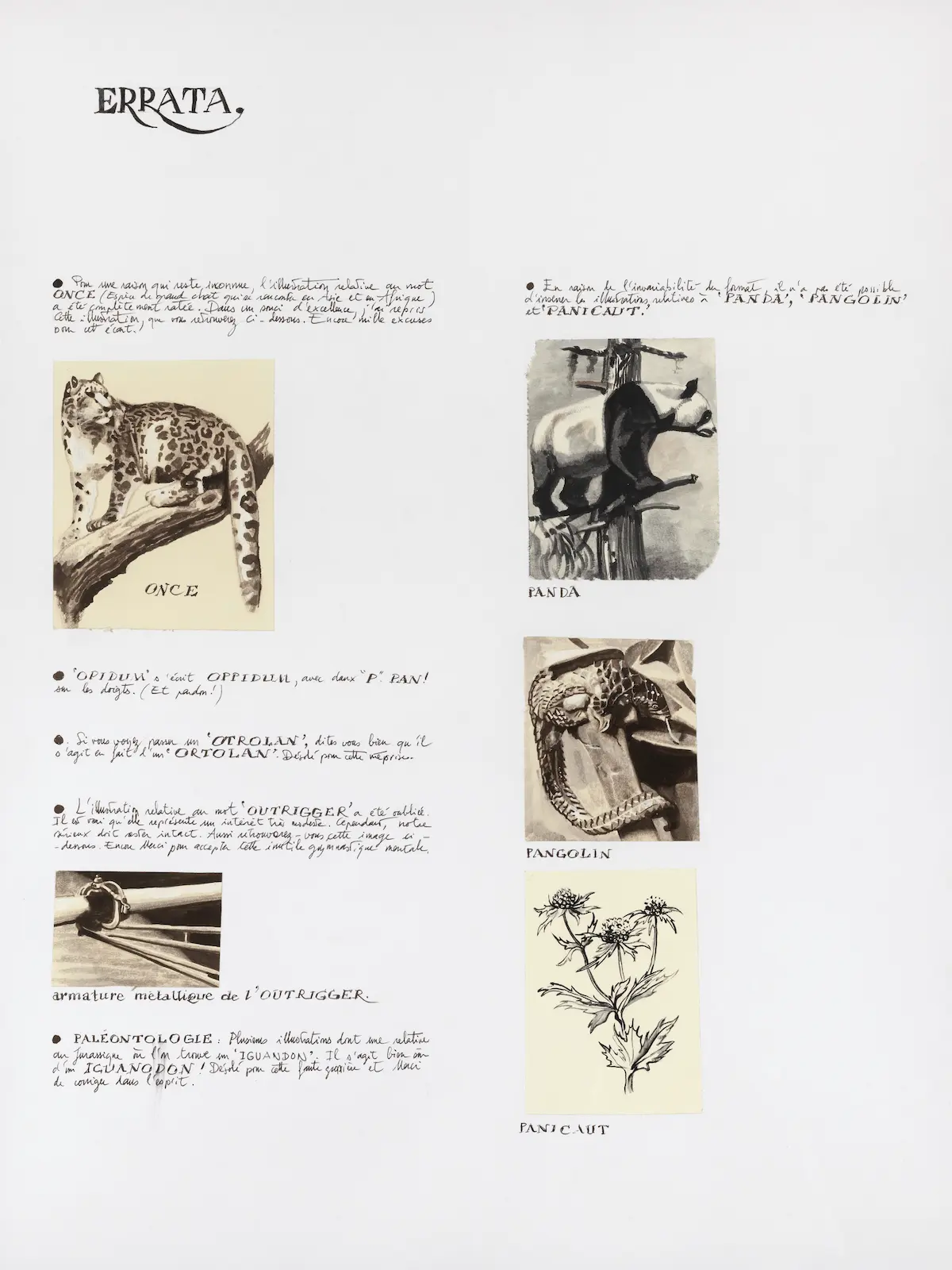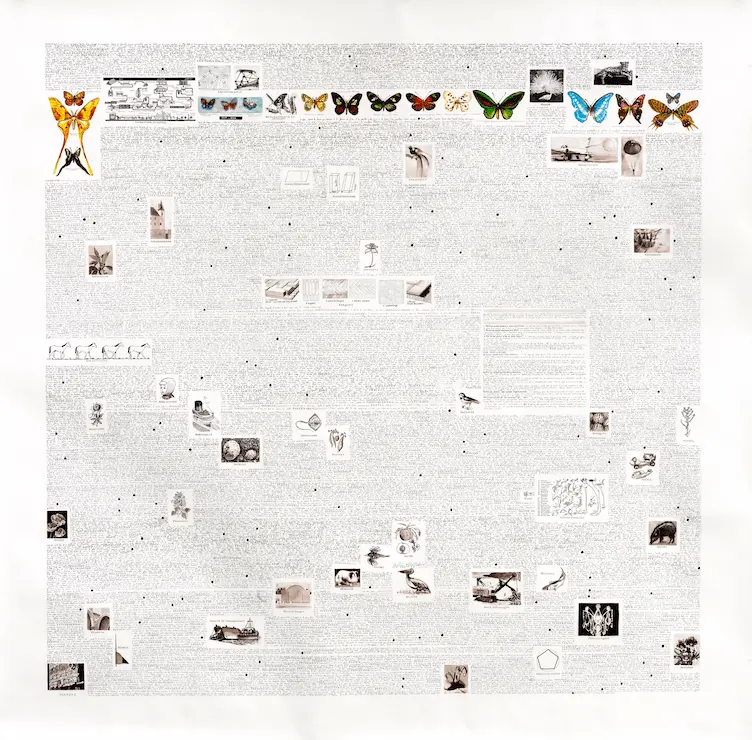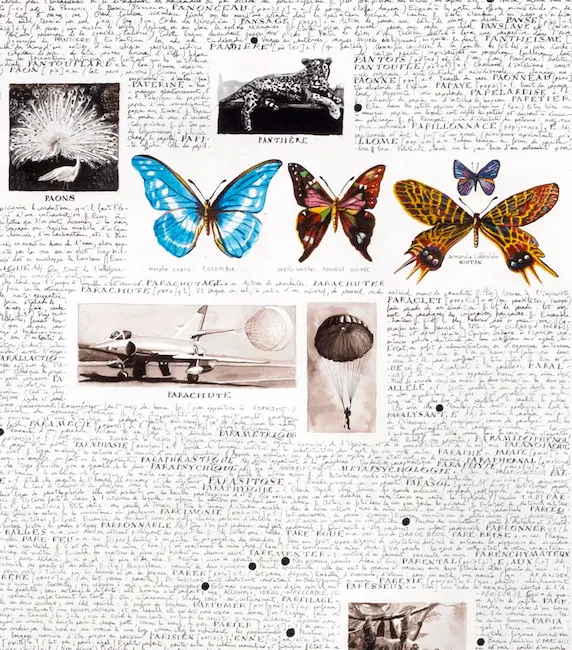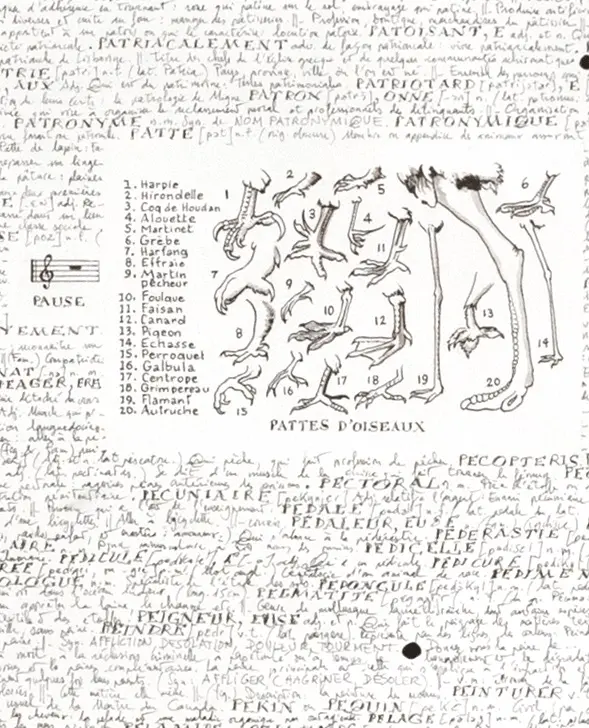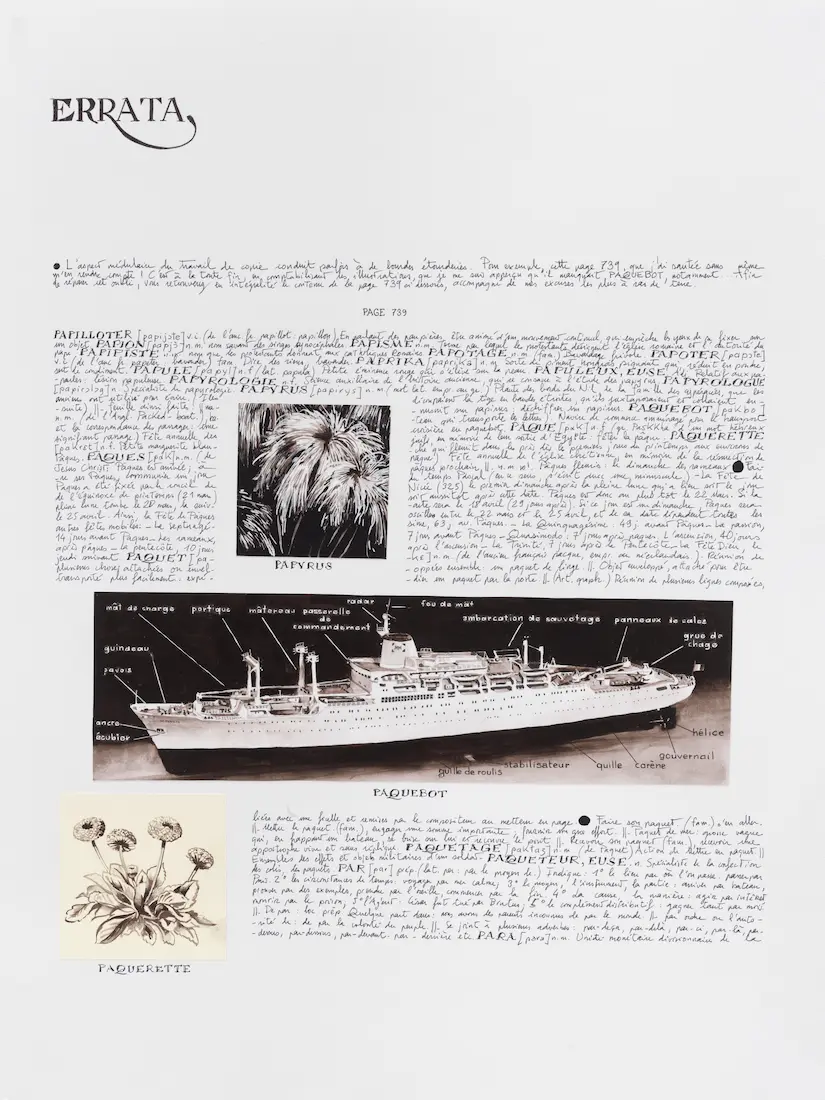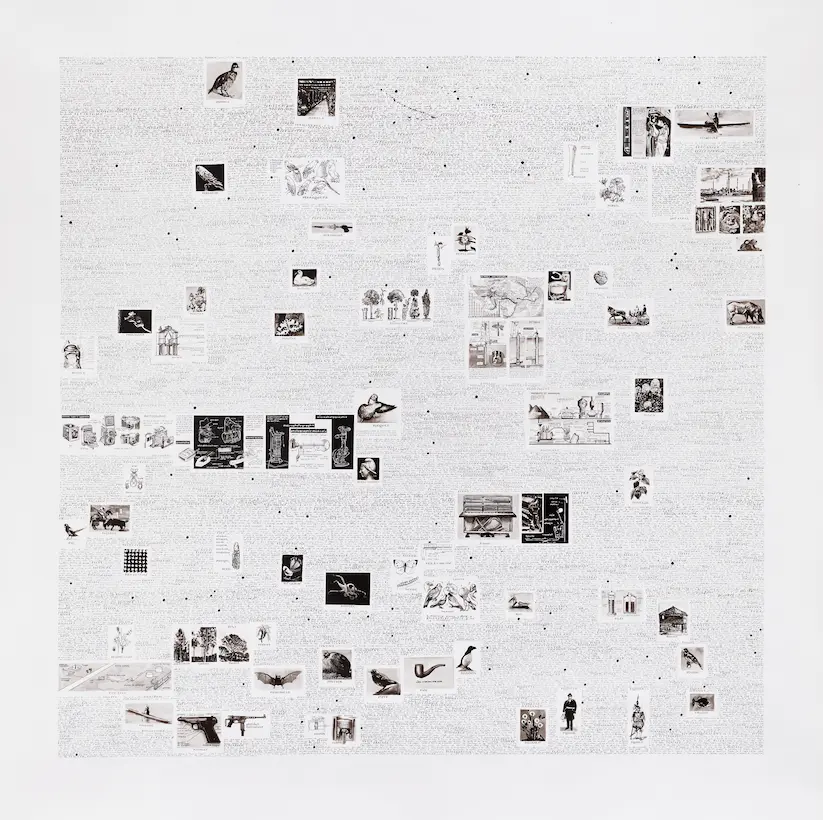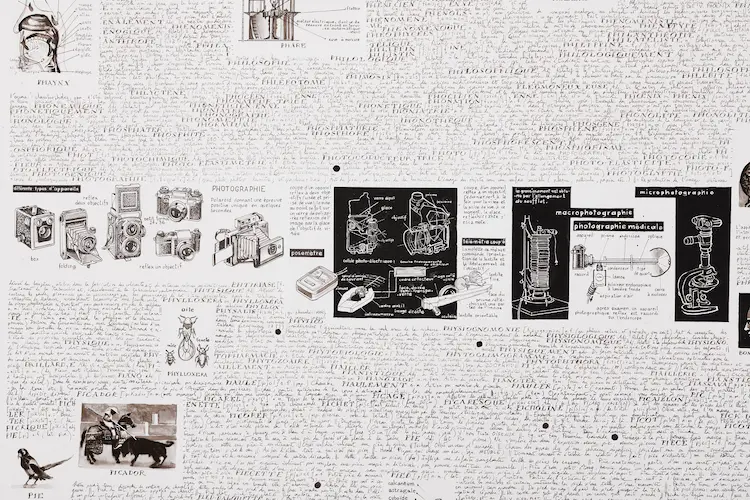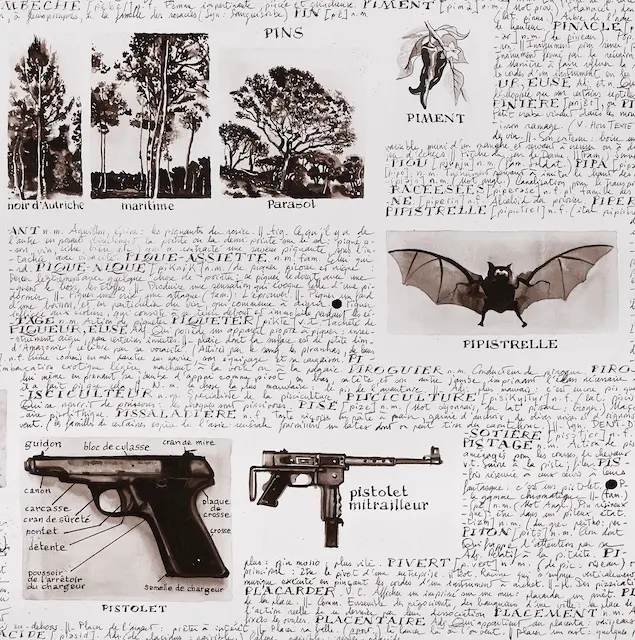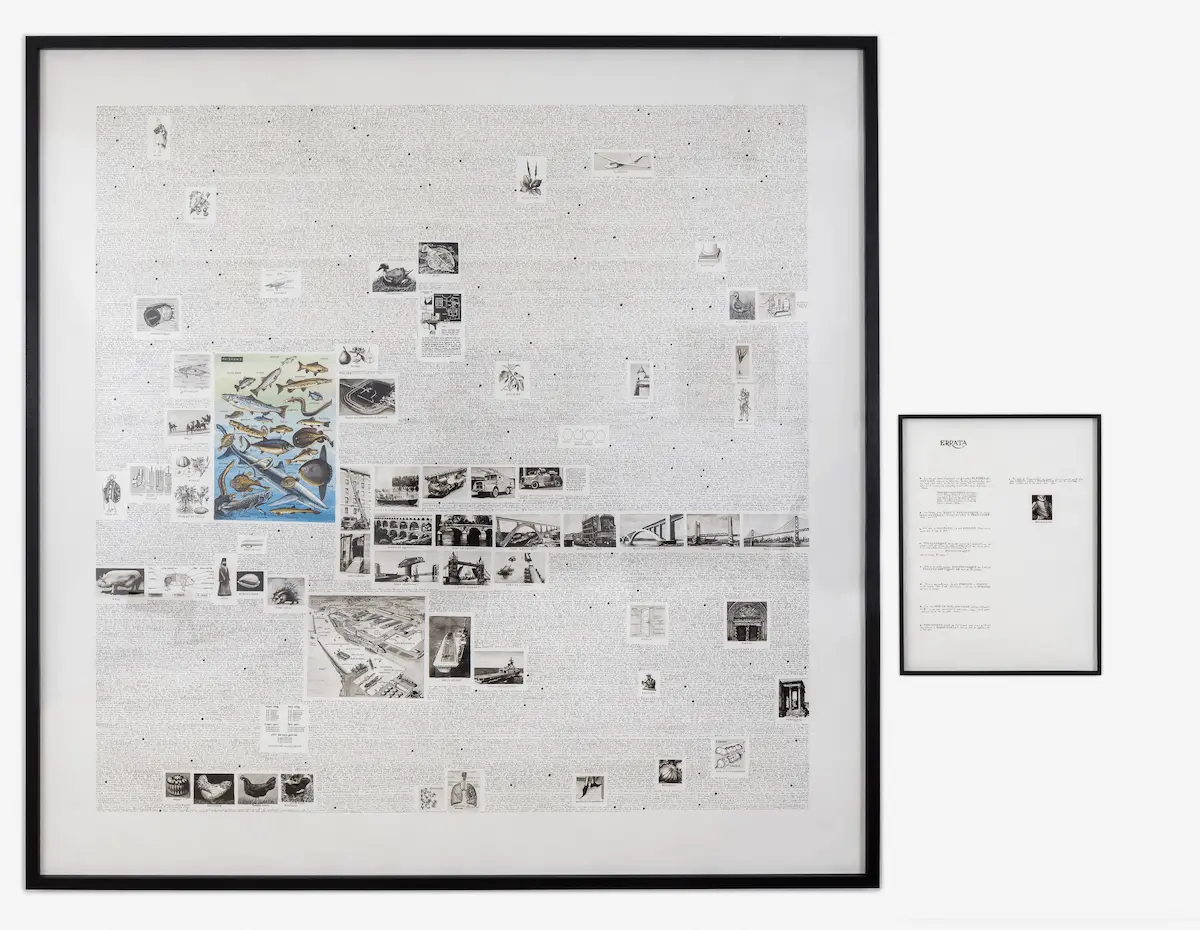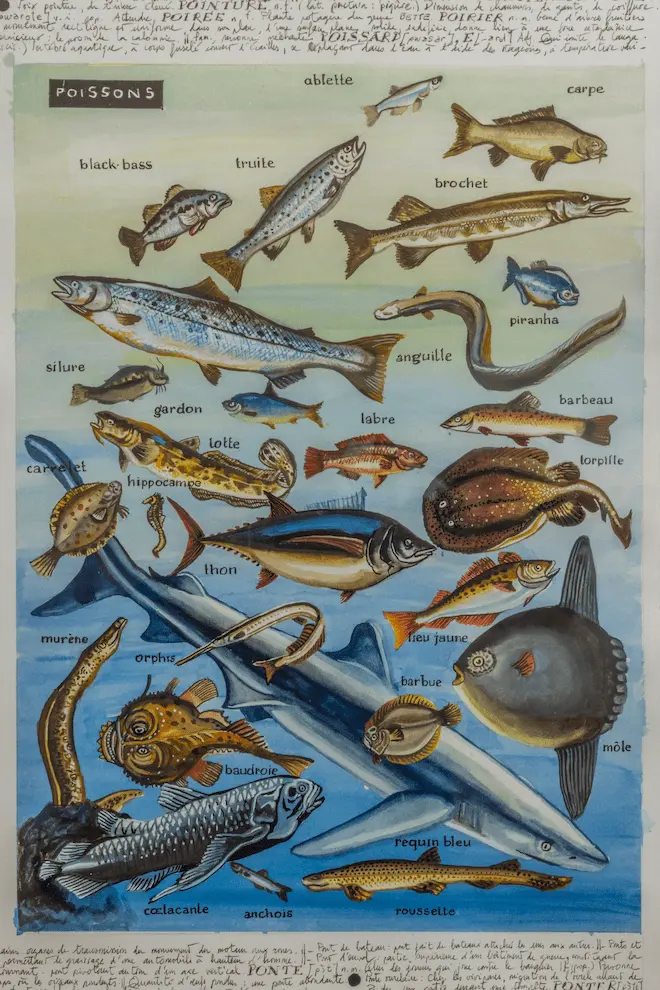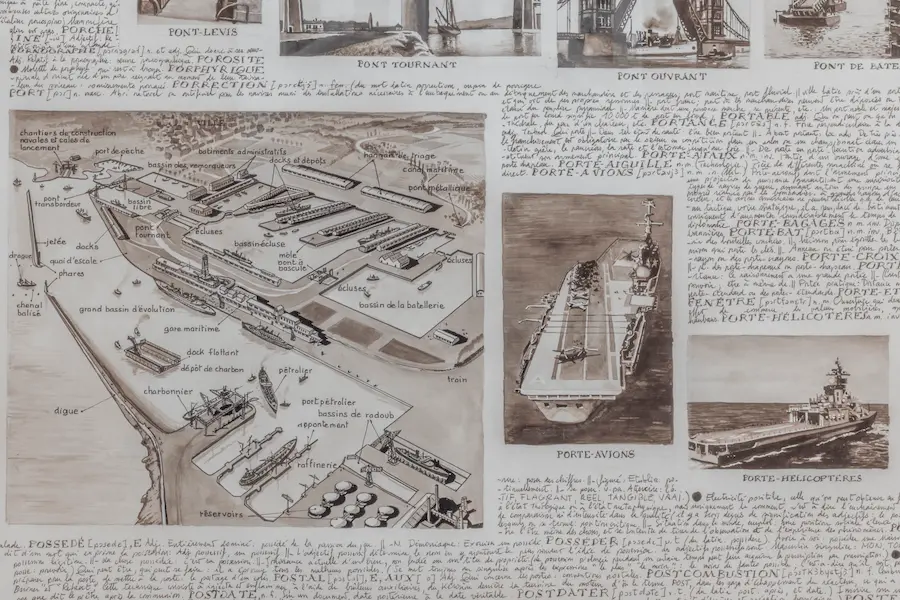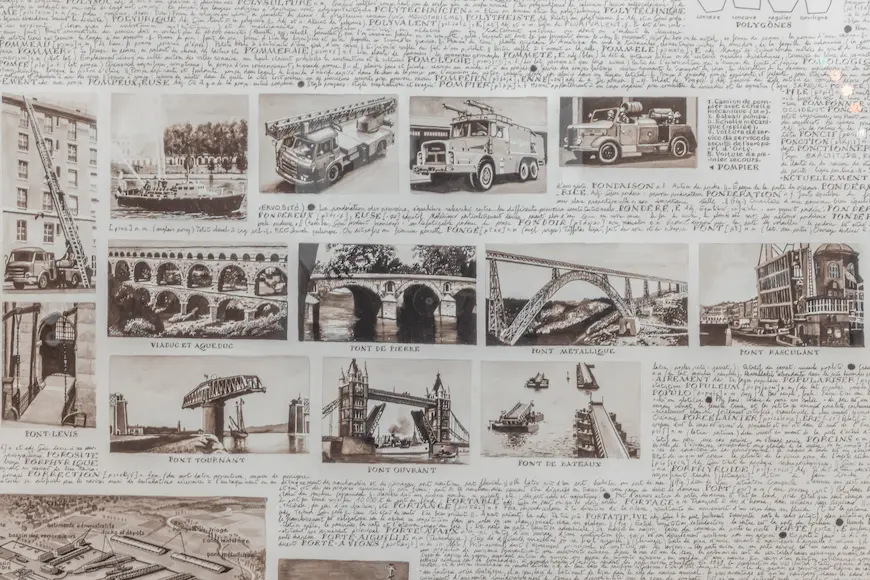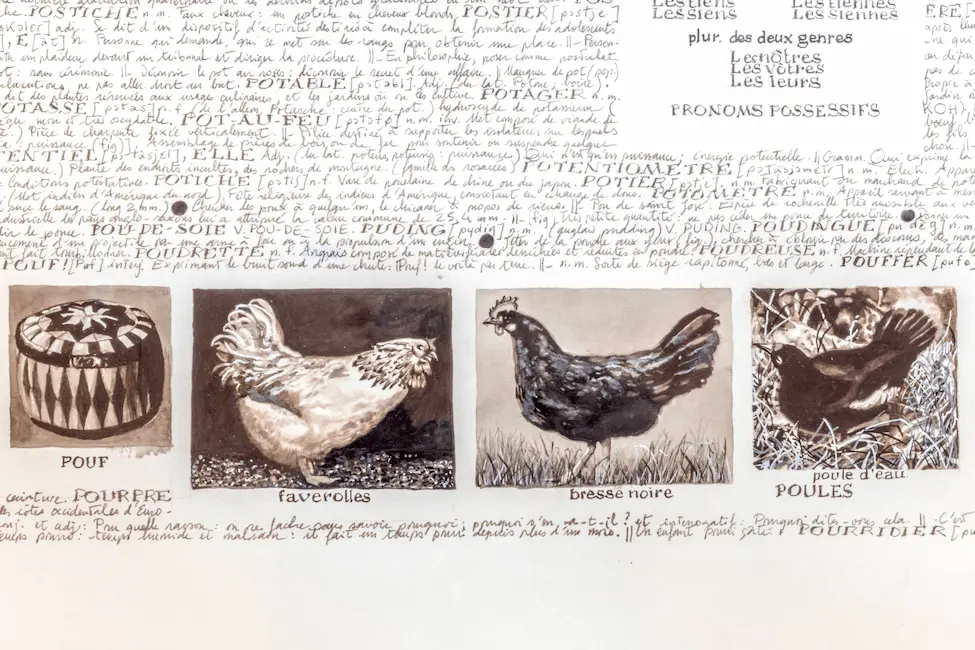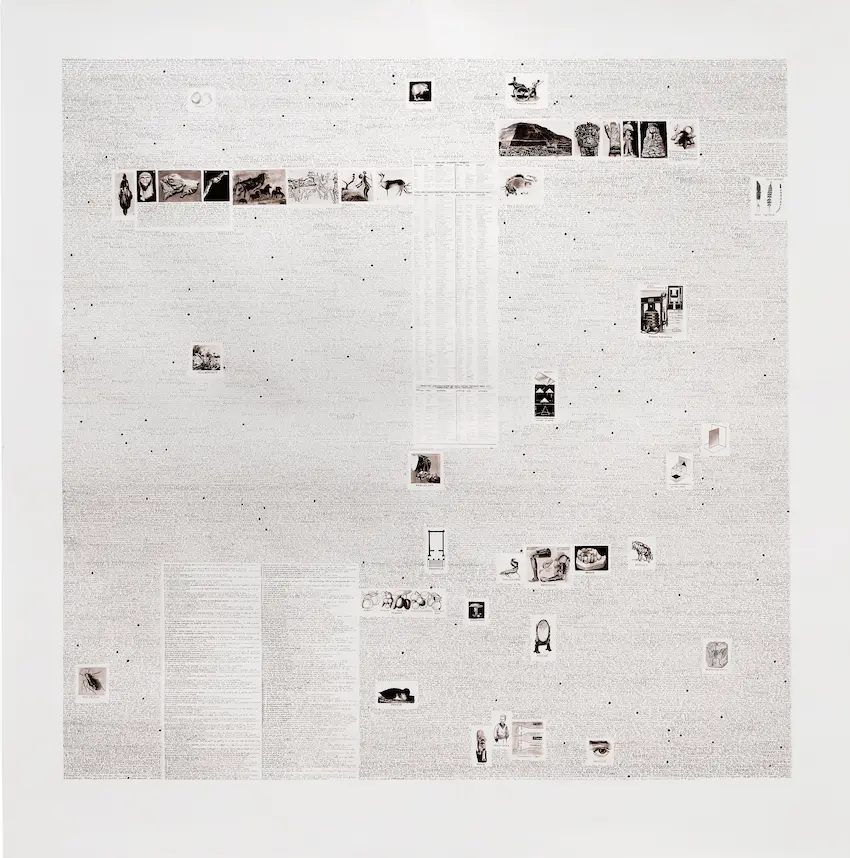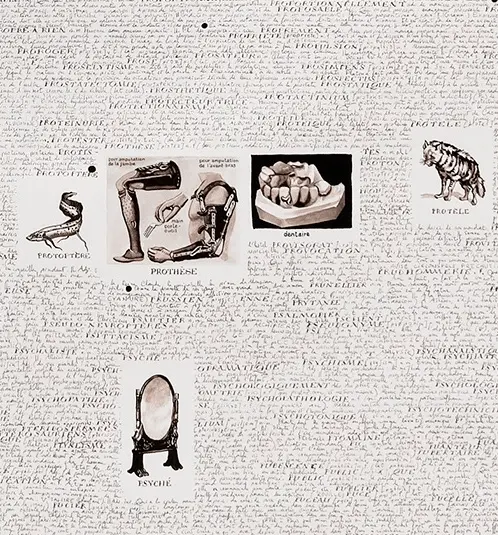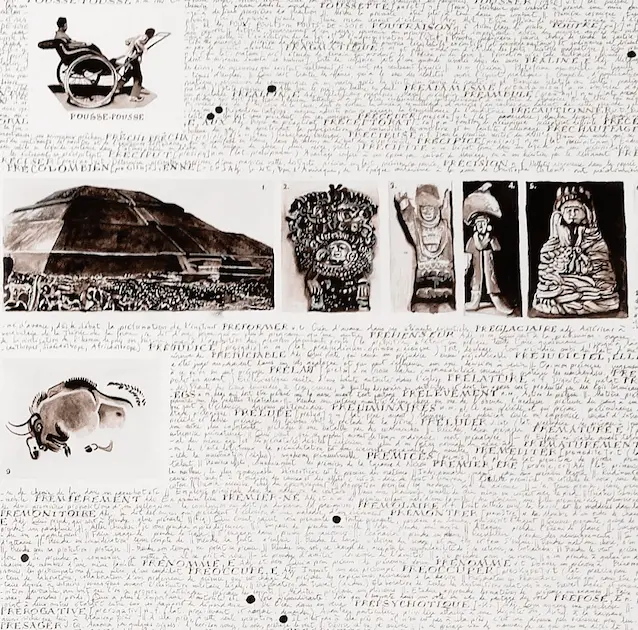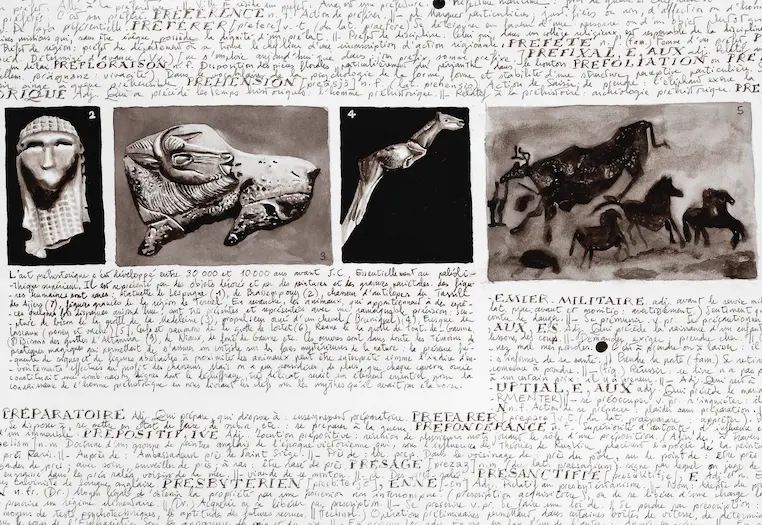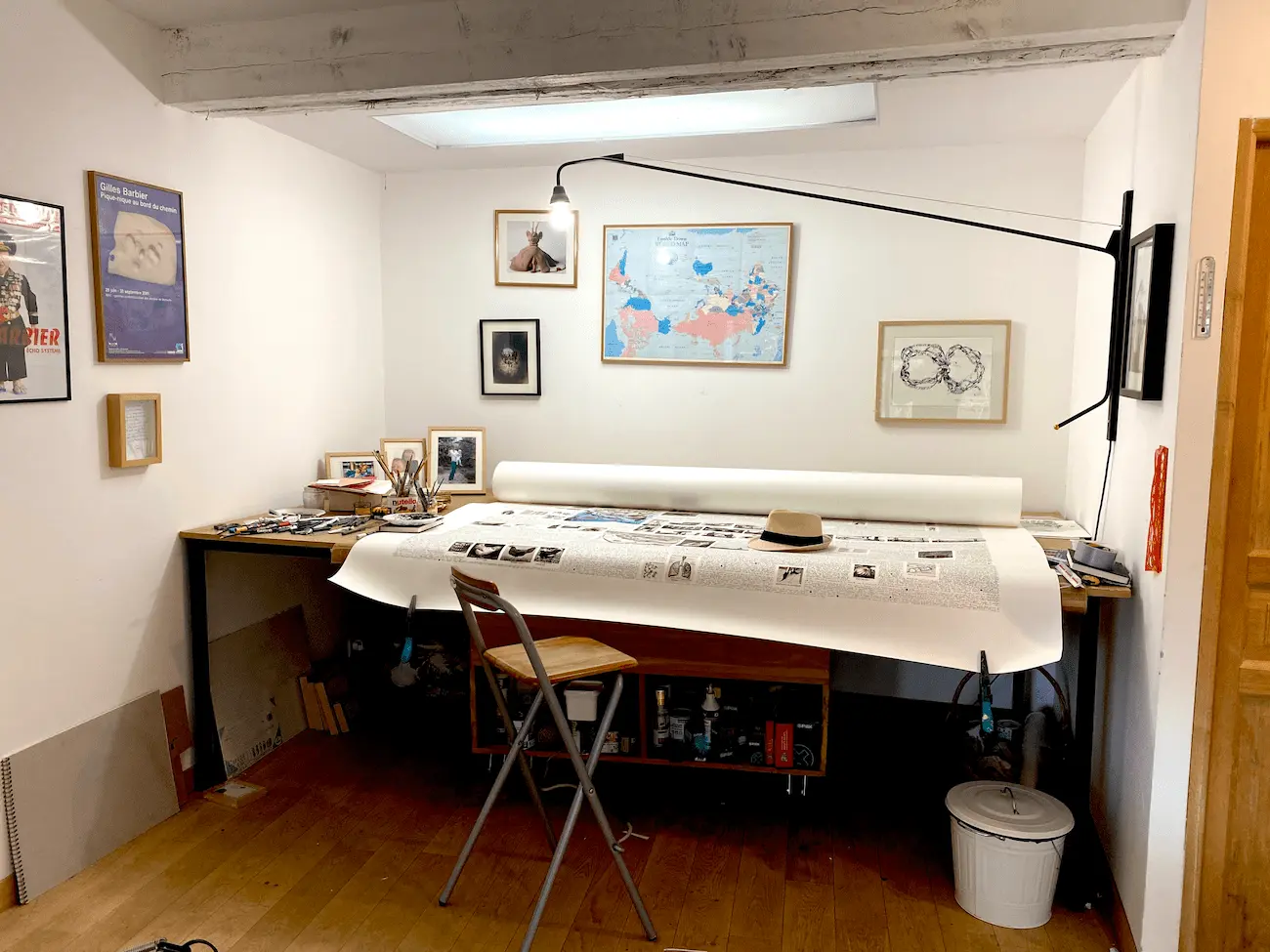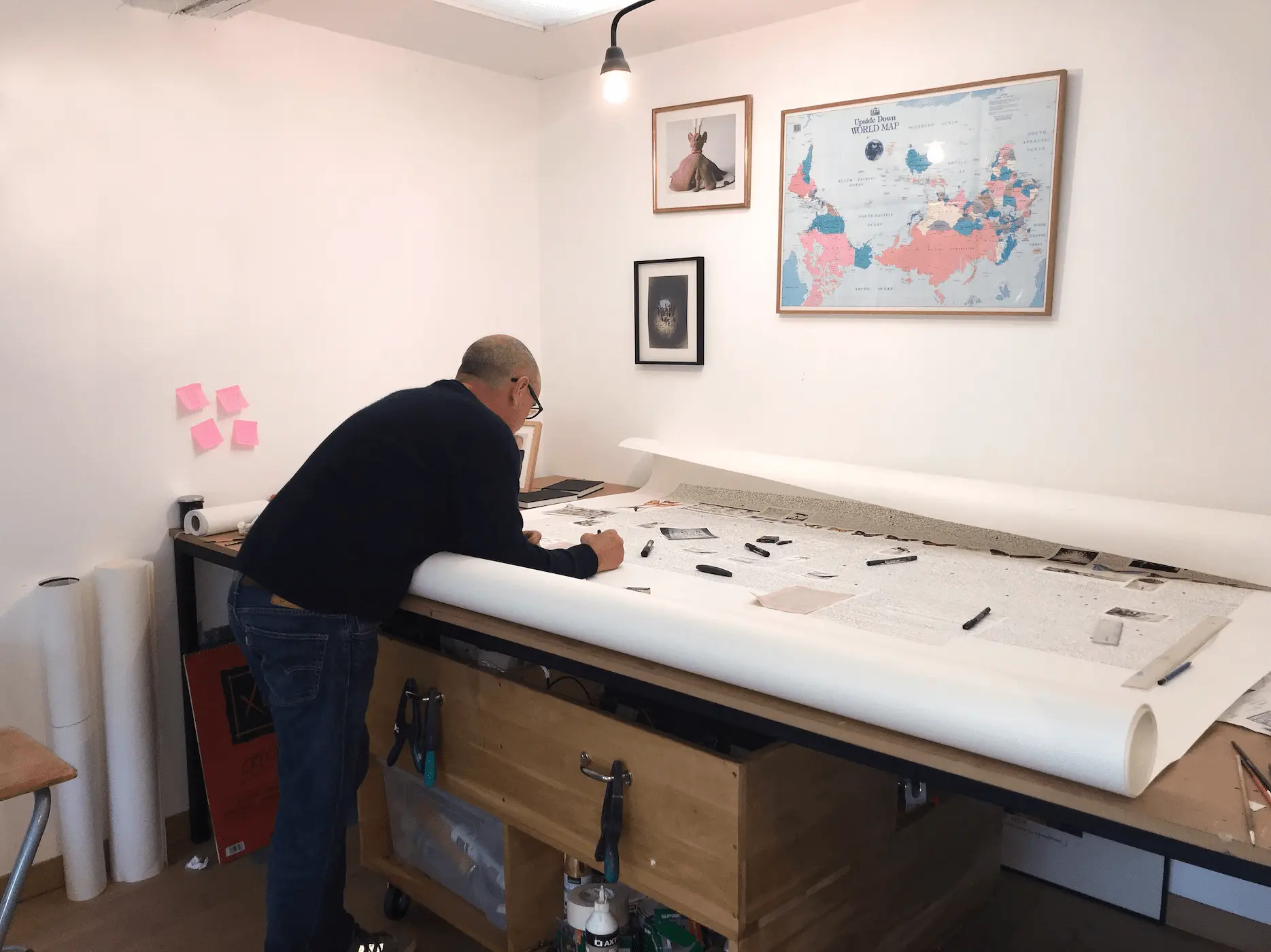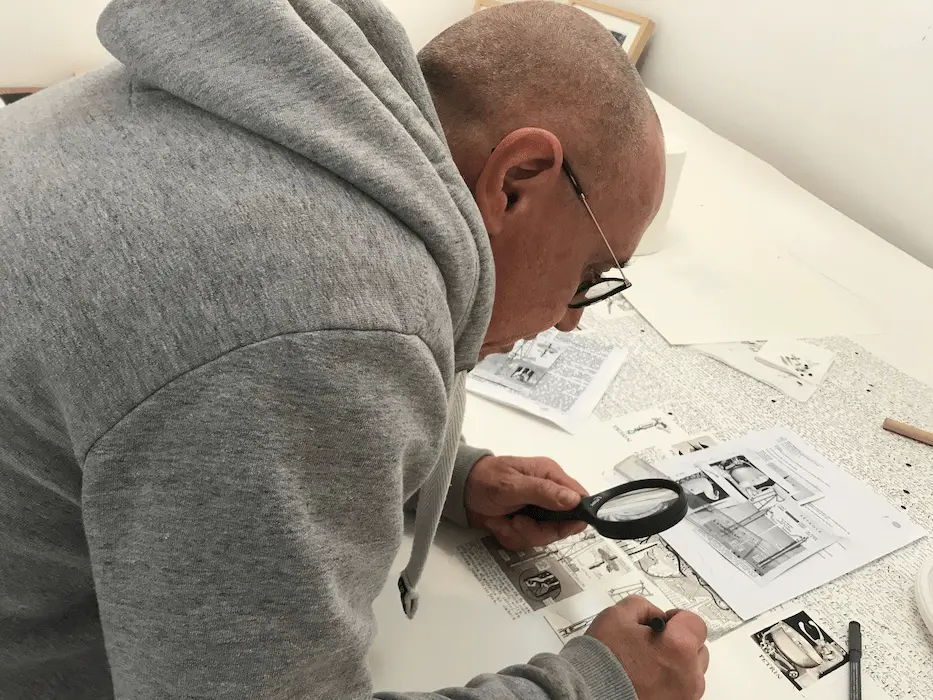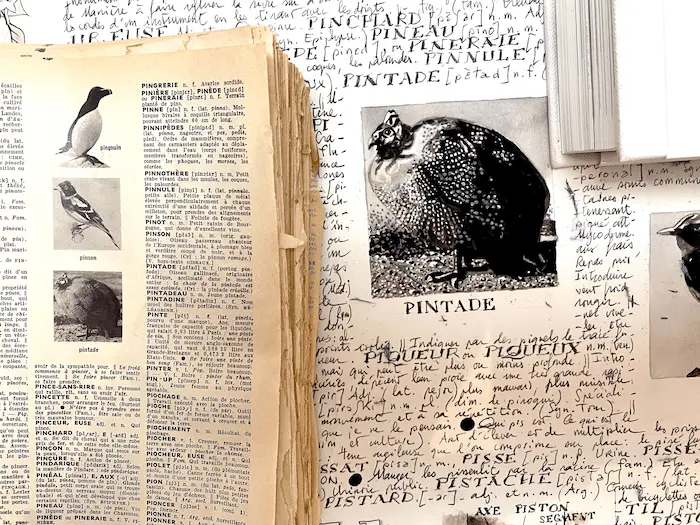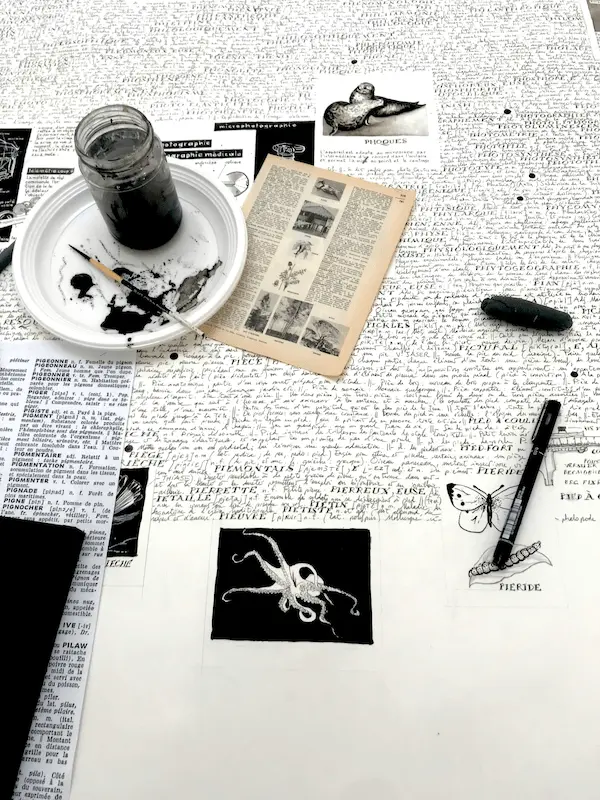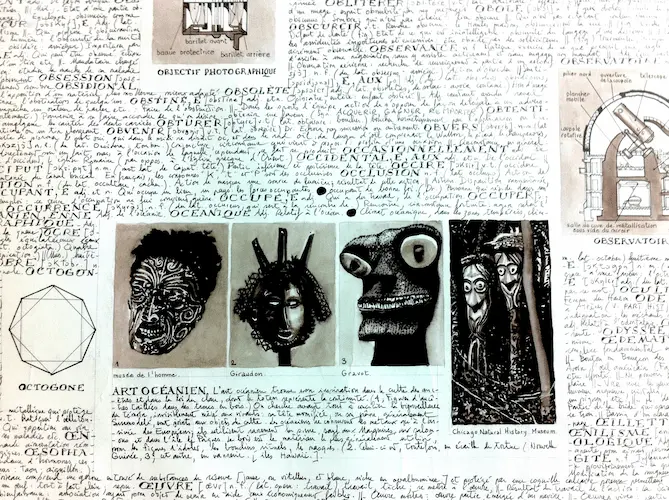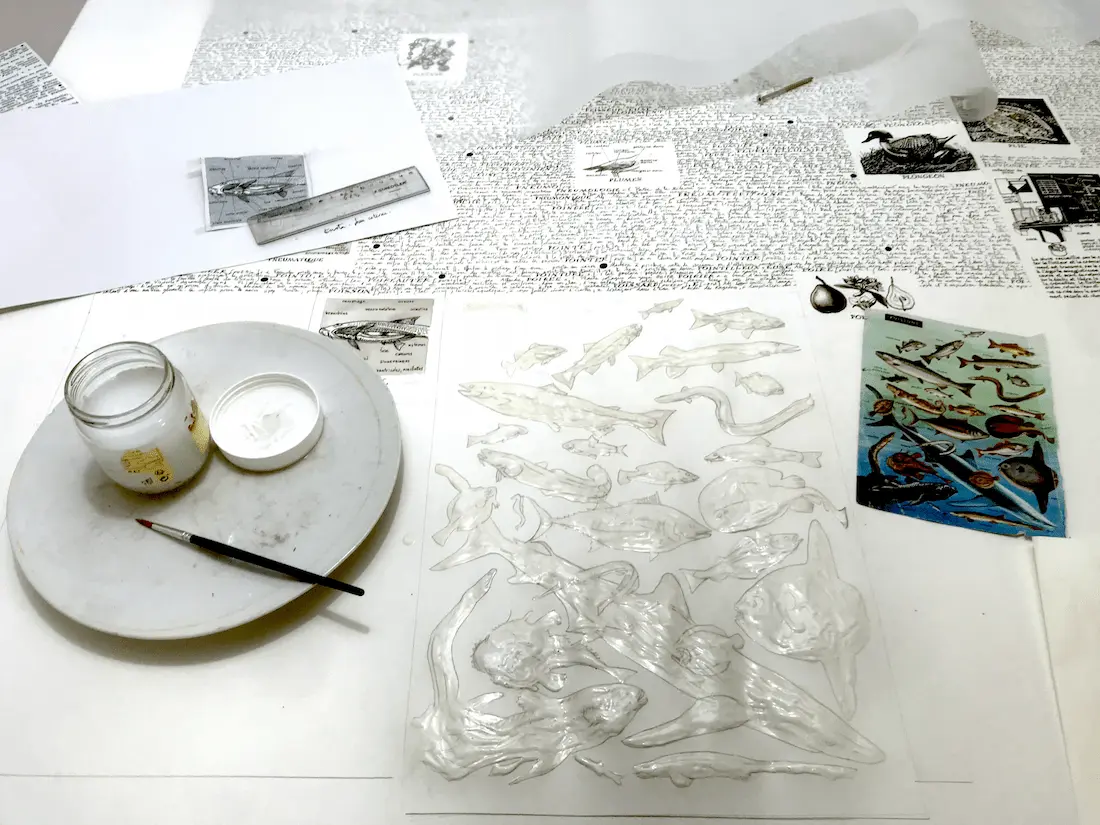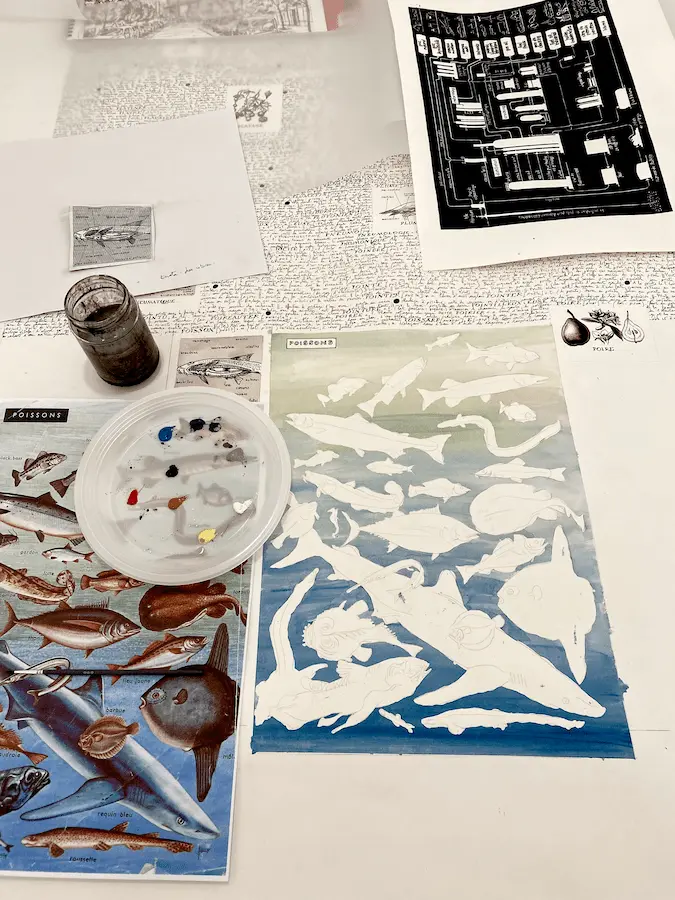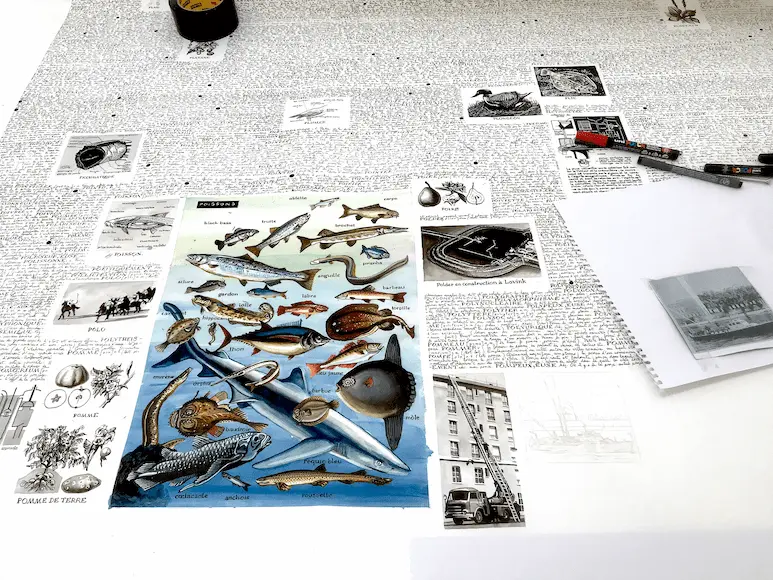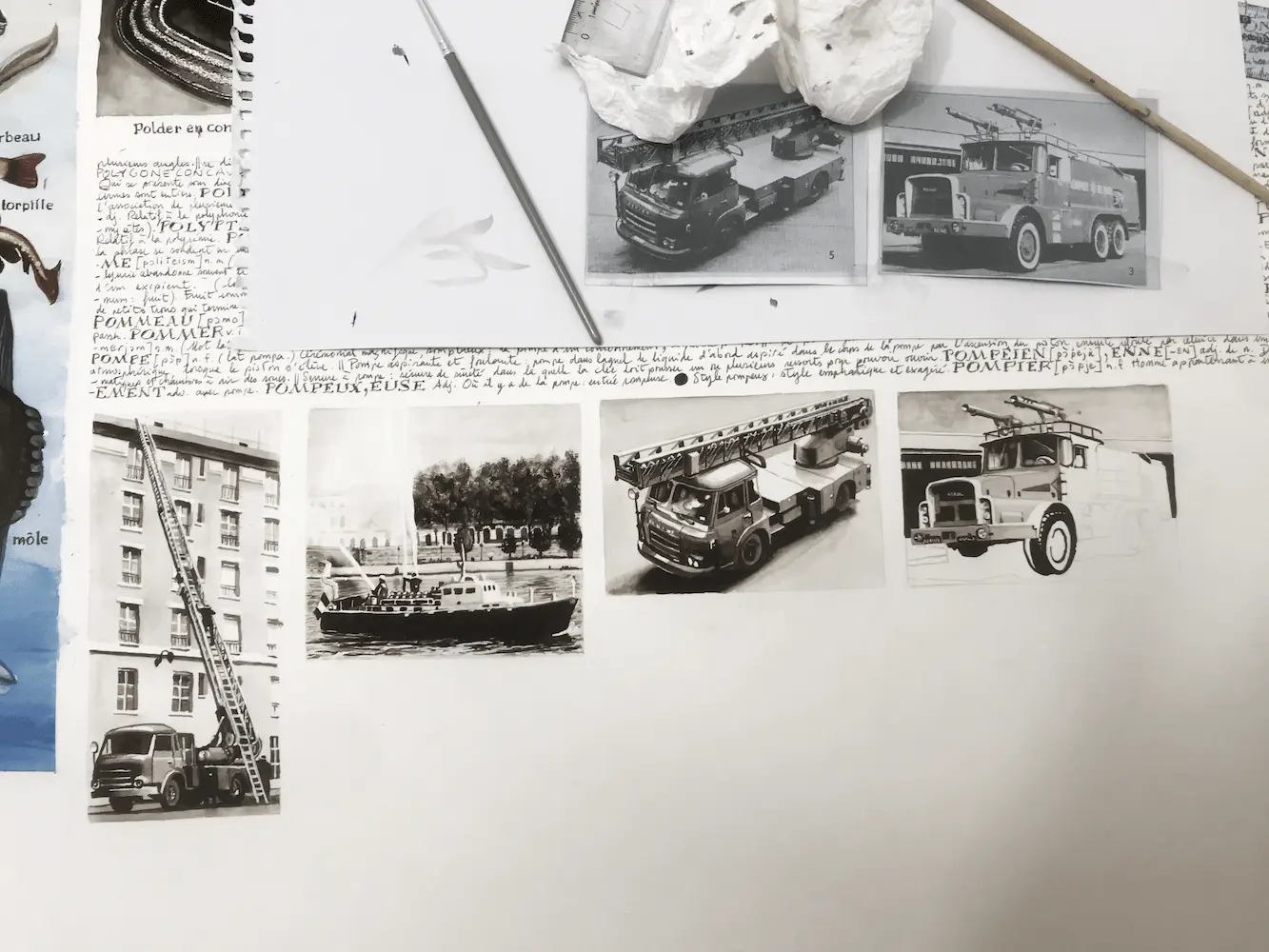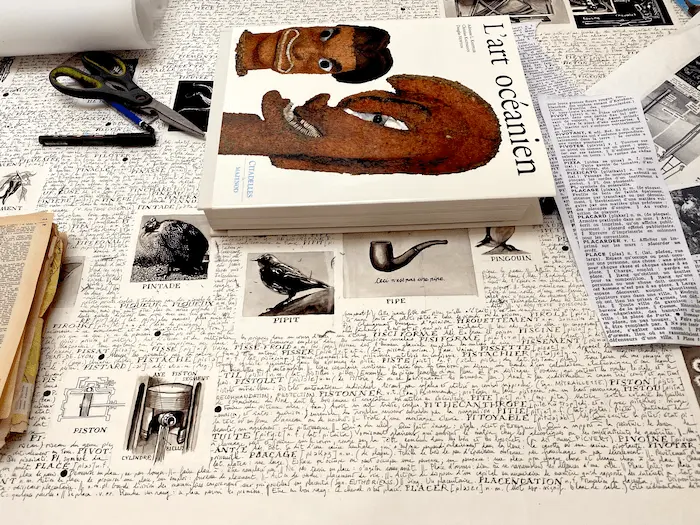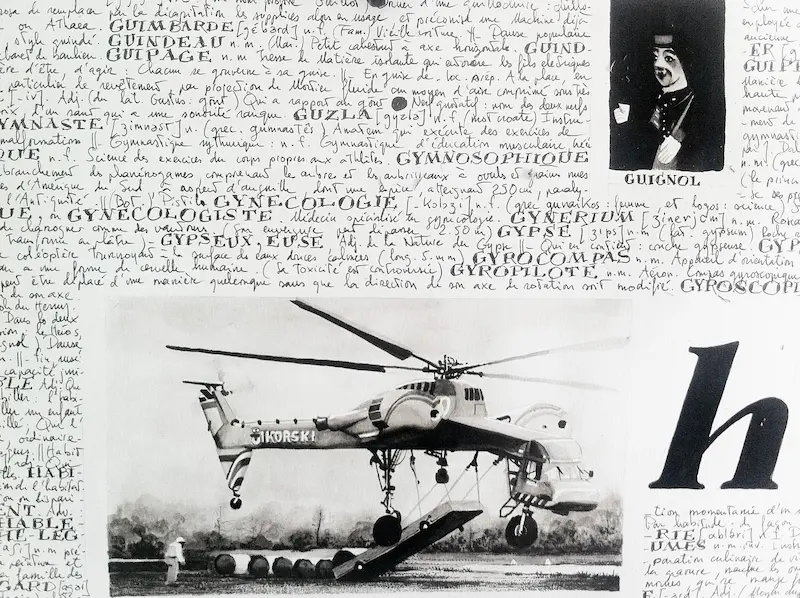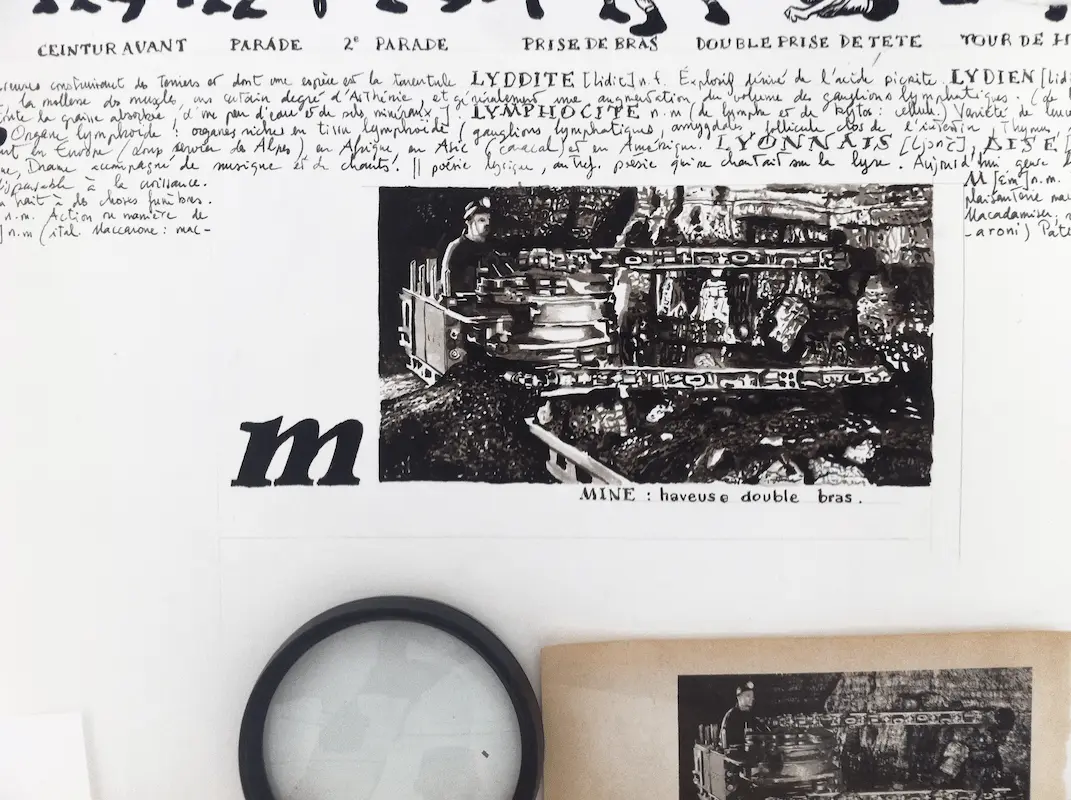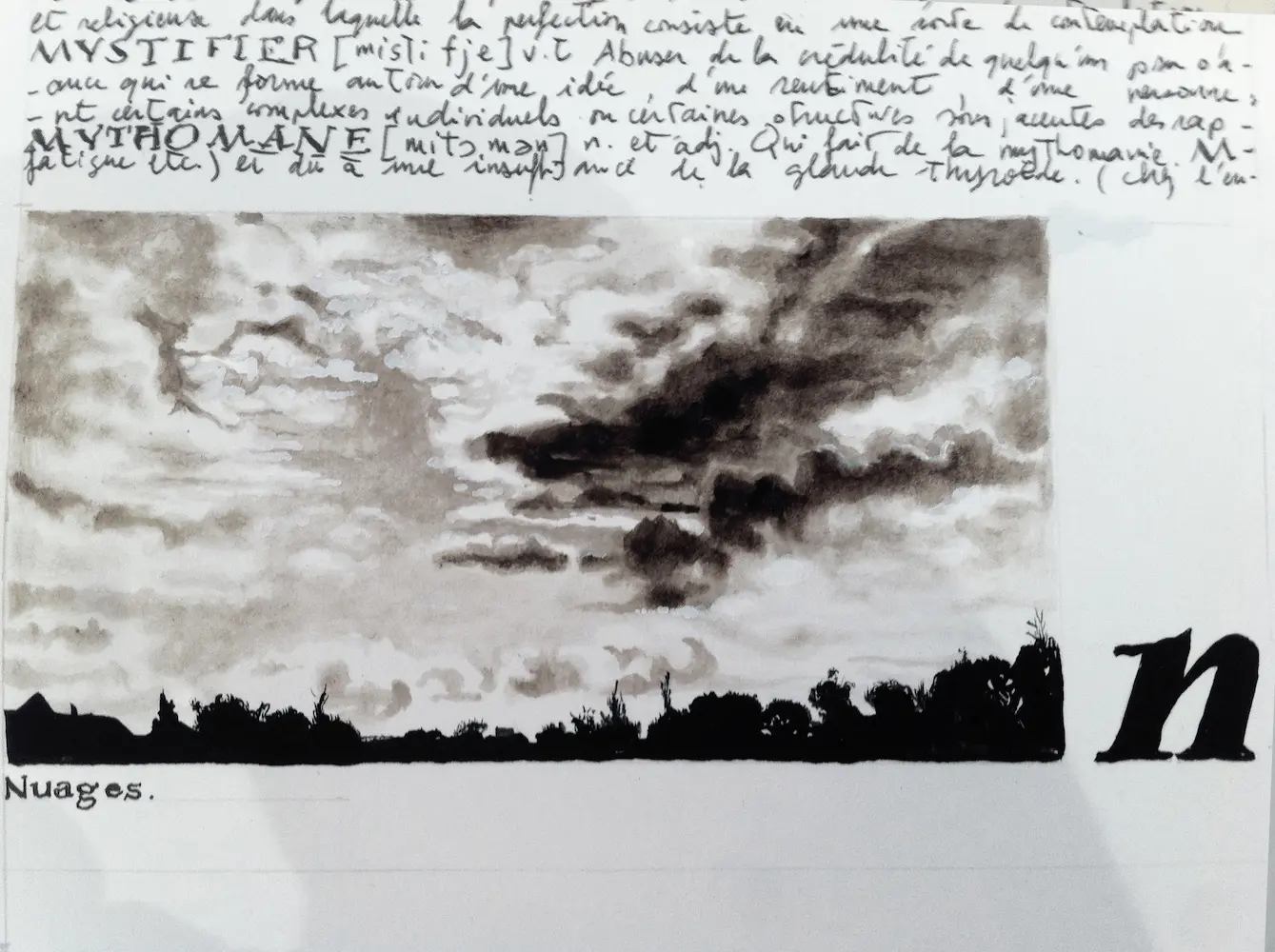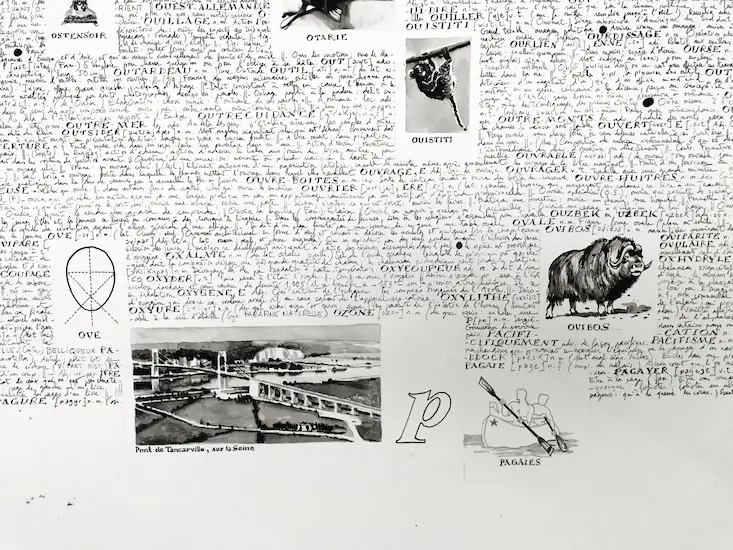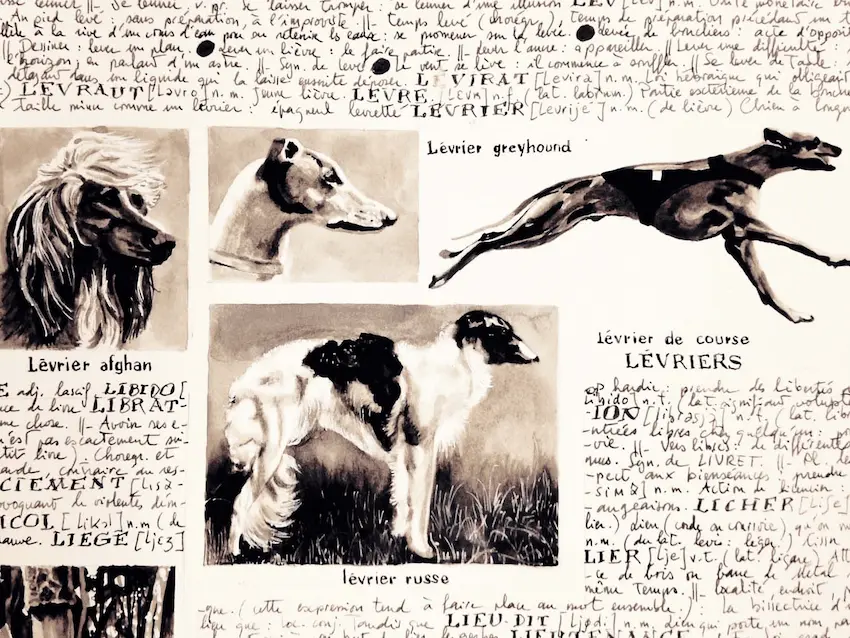Copy of the dictionary (Petit Larousse Illustré, 1966).
Gilles Barbier has been copying the 1966 edition of the Petit Larousse Illustré dictionary since the early 90s. The origin of this work lies in a conceptual device, the Game of Life, imagined by the artist in 1992. Composed of a checkerboard where a pawn moves randomly, this game delivers statements. ” Working on Sundays “was the one that triggered the copy protocol! A nod to Sunday painters and a monumental task à la Bouvard et Pécuchet, copying the dictionary has nonetheless, over time, become an integral part of work, generating its own architecture, its own time and its own ecosystem. In fact, if Gilles Barbier’s work were a city, this copy would play the role of a subway line! Line 1 to be precise. Crossing it from one end to the other, we could take it from the “de A à Alpha” station. Then get off at “de Minage à Naufragé(e) ” (from “Mining” to “Shipwrecked”). We don’t know the name of the terminus, which is still under construction, but the many other lines that already cross this line 1 allow the traveller to jump into other trains, heading off in other directions… A significant way of visiting Gilles Barbier’s universe, and its colossal amplitude.
Monique Barbier-Mueller, 2015.
Read more
The Protocol.
- Devote Sundays to copying the Petit Larousse Illustré dictionary (1966 edition).
- Start with the front page (flags).
- Write with a pen and reproduce the illustrations in gouache.
- The writing style is free but must remain legible, and the reproductions must be faithful to the models.
- Copy the dictionary word by word, in full and in the given order, on 215 x 215 cm paper, with a 15 cm white margin at the top and sides, and 20 cm at the bottom.
- If possible, place the reproduced illustrations under the referent word.
- Correct any errors or omissions in copying, as well as any illustrations that fail or do not fit into the established format, on one or more raisin-sized errata (65 x 50 cm), placed on the right.
- The number of errata is limited to six.
- If the authorized number of errata is exceeded, the performer must redo his copy in its entirety, as irrefutable proof of seriousness.
- The history of errors is recorded beforehand in a notebook: the Error Book which can be freely organized and presented.
- When the performer reaches the bottom of the imposed format, he continues working on the next format, respecting the rule of alphabetical order.
- The resulting segment title is formulated as follows: “first word top left” to “last word bottom right”.
- Once the “COMMON NAMES” section has been copied in its entirety, the performer proposes one or more efficient solutions for a pleasing presentation of the intermediate “PINK PAGES”, composed of Latin and foreign locutions.
- The executor then continues copying, following the same protocol with the “OWN NAMES” section.
Marseille, October 14, 1992.
“Working on Sundays”. As the adventure begins, I realize that the country where I was born doesn’t exist. (“Banana Hangar”). 2021
“Working on Sundays”. As the adventure begins, I realize that the country where I was born doesn’t exist. (“Banana Hangar”). 2021
From “A” to “ALPHA”. 1992, Ink and gouache on paper. 220 x 220 cm. Collection Publique FRAC Sud, Cité de l’Art Contemporain, Marseille
From “A” to “ALPHA”. 1992, Ink and gouache on paper. 220 x 220 cm. Collection Publique FRAC Sud, Cité de l’Art Contemporain, Marseille
From “A” to “ALPHA”. 1992, Ink and gouache on paper. 220 x 220 cm. Detail.
From “A” to “ALPHA”. 1992, Ink and gouache on paper. 220 x 220 cm. Detail.
From “A” to “ALPHA”. 1992, Ink and gouache on paper. 220 x 220 cm. Detail.
From “A” to “ALPHA”. 1992, Ink and gouache on paper. 220 x 220 cm. Detail.
From “ALPHABET” to “ARISTARQUE”. 1993, Ink and gouache on paper. 220 x 220 cm.
From “ALPHABET” to “ARISTARQUE”. 1993, Ink and gouache on paper. 220 x 220 cm.
From “ARISTOCRATE” to “BAGUE”. 1993 , Ink and gouache on paper. 220 x 220 cm.
From “ARISTOCRATE” to “BAGUE”. 1993 , Ink and gouache on paper. 220 x 220 cm.
From “BAGUENAUDE” to “BISAIGÜE”. 1993, Ink and gouache on paper. 220 x 220 cm. 1993 (Work destroyed).
From “BAGUENAUDE” to “BISAIGÜE”. 1993, Ink and gouache on paper. 220 x 220 cm. 1993 (Work destroyed).
From “BISANUEL” to “BULGARE”. 1994 , Ink and gouache on paper. 220 x 220 cm.
From “BISANUEL” to “BULGARE”. 1994 , Ink and gouache on paper. 220 x 220 cm.
From “BULGE” to “CASCADER”. 1994 , Ink and gouache on paper. 220 x 220 cm.
From “BULGE” to “CASCADER”. 1994 , Ink and gouache on paper. 220 x 220 cm.
From “BULGE” to “CASCADER”. 1994 , Ink and gouache on paper. 220 x 220 cm. Detail.
From “BULGE” to “CASCADER”. 1994 , Ink and gouache on paper. 220 x 220 cm. Detail.
From “BULGE” to “CASCADER”. 1994 , Ink and gouache on paper. 220 x 220 cm. Detail.
From “BULGE” to “CASCADER”. 1994 , Ink and gouache on paper. 220 x 220 cm. Detail.
From “BULGE” to “CASCADER”. 1994 , Ink and gouache on paper. 220 x 220 cm. Detail.
From “BULGE” to “CASCADER”. 1994 , Ink and gouache on paper. 220 x 220 cm. Detail.
From “BULGE” to “CASCADER”. 1994 , Ink and gouache on paper. 220 x 220 cm. Errata.
From “BULGE” to “CASCADER”. 1994 , Ink and gouache on paper. 220 x 220 cm. Errata.
From “CASCADEUR” to “CHAUFFE-ASSIETTE”. 1994, Ink and gouache on paper. 220 x 220 cm.
From “CASCADEUR” to “CHAUFFE-ASSIETTE”. 1994, Ink and gouache on paper. 220 x 220 cm.
From “CASCADEUR” to “CHAUFFE-ASSIETTE”. 1994, Ink and gouache on paper. 220 x 220 cm.
From “CASCADEUR” to “CHAUFFE-ASSIETTE”. 1994, Ink and gouache on paper. 220 x 220 cm.
From “CHAUFFE-BAIN” to “CINÉMITRAILLEUSE”. 1995, Ink and gouache on paper. 220 x 220 cm.
From “CHAUFFE-BAIN” to “CINÉMITRAILLEUSE”. 1995, Ink and gouache on paper. 220 x 220 cm.
From “CHAUFFE-BAIN” to “CINÉMITRAILLEUSE”. Detail.
From “CHAUFFE-BAIN” to “CINÉMITRAILLEUSE”. Detail.
From “CHAUFFE-BAIN” to “CINÉMITRAILLEUSE”. 1995, Ink and gouache on paper. 220 x 220 cm. Errata.
From “CHAUFFE-BAIN” to “CINÉMITRAILLEUSE”. 1995, Ink and gouache on paper. 220 x 220 cm. Errata.
From “CINEMATOGRAPHE” to “COLOPHANE”. 1995, Ink and gouache on paper. 220 x 220 cm.
From “CINEMATOGRAPHE” to “COLOPHANE”. 1995, Ink and gouache on paper. 220 x 220 cm.
From “COLOQUINTE” to “COORDINATOR (branch A)”. 1995, Ink and gouache on paper. 220 x 220 cm.
From “COLOQUINTE” to “COORDINATOR (branch A)”. 1995, Ink and gouache on paper. 220 x 220 cm.
From “COORDINATION” to “CRISTALLISATION (branch A)”. 1996, Ink and gouache on paper. 220 x 220 cm.
From “COORDINATION” to “CRISTALLISATION (branch A)”. 1996, Ink and gouache on paper. 220 x 220 cm.
From “COORDONNÉE” to “’CRISTALLISATION” (branch A). Detail.
From “COORDONNÉE” to “’CRISTALLISATION” (branch A). Detail.
From “CRISTALLISER” to “DÉCORATIF (branche A)”. 1997, Ink and gouache on paper. 220 x 220 cm.
From “CRISTALLISER” to “DÉCORATIF (branche A)”. 1997, Ink and gouache on paper. 220 x 220 cm.
From “CRISTALLISER” to “DÉCORATIF (branche A)”. Detail.
From “CRISTALLISER” to “DÉCORATIF (branche A)”. Detail.
From “CRISTALLISER” to “DÉCORATIF (branche A)”. Detail.
From “CRISTALLISER” to “DÉCORATIF (branche A)”. Detail.
From “DECORATION” to “DIFFORME (branch A)”. 1997, Ink and gouache on paper. 220 x 220 cm. Detail.
From “DECORATION” to “DIFFORME (branch A)”. 1997, Ink and gouache on paper. 220 x 220 cm. Detail.
From “DECORATION” to “DIFFORME (branch A)”. 1997, Ink and gouache on paper. 220 x 220 cm. Detail.
From “DECORATION” to “DIFFORME (branch A)”. 1997, Ink and gouache on paper. 220 x 220 cm. Detail.
From “DECORATION” to “DIFFORME (branch A)”. 1997, Ink and gouache on paper. 220 x 220 cm. Detail.
From “DECORATION” to “DIFFORME (branch A)”. 1997, Ink and gouache on paper. 220 x 220 cm. Detail.
From “DIFFORMITÉ” to “ÉCLAIREUR (branche A)”. 1997, Ink and gouache on paper. 220 x 220 cm.
From “DIFFORMITÉ” to “ÉCLAIREUR (branche A)”. 1997, Ink and gouache on paper. 220 x 220 cm. Résultat de la traduction From “DIFFORMITÉ” to “ÉCLAIREUR (branche A)”. 1997, Ink and gouache on paper. 220 x 220 cm.
From “DIFFORMITÉ” to “ÉCLAIREUR (branche A)”. 1997, Ink and gouache on paper. 220 x 220 cm. Detail.
From “DIFFORMITÉ” to “ÉCLAIREUR (branche A)”. 1997, Ink and gouache on paper. 220 x 220 cm. Detail.
From “DIFFORMITÉ” to “ÉCLAIREUR (branche A)”. 1997, Ink and gouache on paper. 220 x 220 cm. Detail.
From “DIFFORMITÉ” to “ÉCLAIREUR (branche A)”. 1997, Ink and gouache on paper. 220 x 220 cm. Detail.
From “DIFFORMITÉ” to “ÉCLAIREUR (branche A)”. 1997, Ink and gouache on paper. 220 x 220 cm. Detail.
From “DIFFORMITÉ” to “ÉCLAIREUR (branche A)”. 1997, Ink and gouache on paper. 220 x 220 cm. Detail.
From “DIFFORMITÉ” to “ÉCLAIREUR (branche A)”. 1997, Ink and gouache on paper. 220 x 220 cm. Errata.
From “DIFFORMITÉ” to “ÉCLAIREUR (branche A)”. 1997, Ink and gouache on paper. 220 x 220 cm. Errata.
From “ÉCLAMPSIE” to “ENDIMANCHER (branch A)”. 1998, Ink and gouache on paper. 220 x 220 cm.
From “ÉCLAMPSIE” to “ENDIMANCHER (branch A)”. 1998, Ink and gouache on paper. 220 x 220 cm.
From “ÉCLAMPSIE” to “ENDIMANCHER” (branch A). 1998, Ink and gouache on paper. 220 x 220 cm. Detail.
From “ÉCLAMPSIE” to “ENDIMANCHER” (branch A). 1998, Ink and gouache on paper. 220 x 220 cm. Detail.
From “ÉCLAMPSIE” to “ENDIMANCHER” (branch A). 1998, Ink and gouache on paper. 220 x 220 cm. Detail.
From “ÉCLAMPSIE” to “ENDIMANCHER” (branch A). 1998, Ink and gouache on paper. 220 x 220 cm. Detail.
From “ÉCLAMPSIE” to “ENDIMANCHER” (branch A). 1998, Ink and gouache on paper. 220 x 220 cm. Detail.
From “ÉCLAMPSIE” to “ENDIMANCHER” (branch A). 1998, Ink and gouache on paper. 220 x 220 cm. Detail.
From “ÉCLAMPSIE” to “ENDIMANCHER” (branch A). 1998, Ink and gouache on paper. 220 x 220 cm. Errata.
From “ÉCLAMPSIE” to “ENDIMANCHER” (branch A). 1998, Ink and gouache on paper. 220 x 220 cm. Errata.
From “ÉCLAMPSIE” to “ENDIMANCHER (branch A)”. 1998, Ink and gouache on paper. 220 x 220 cm. Errata
From “ÉCLAMPSIE” to “ENDIMANCHER (branch A)”. 1998, Ink and gouache on paper. 220 x 220 cm. Errata (complément).
From “ENDIVE” to “ESPION (branch A)”. 1998, Ink and gouache on paper. 220 x 220 cm.
From “ENDIVE” to “ESPION (branch A)”. 1998, Ink and gouache on paper. 220 x 220 cm.
From “ENDIVE” to “ESPION (branch A)”. 1998, Ink and gouache on paper. 220 x 220 cm. Detail.
From “ENDIVE” to “ESPION (branch A)”. 1998, Ink and gouache on paper. 220 x 220 cm. Detail.
From “COLOQUINTE” to “COUCHE-CULOTTE (branch B)”. 1997, Ink and gouache on paper. 220 x 220 cm.
From “COLOQUINTE” to “COUCHE-CULOTTE (branch B)”. 1997, Ink and gouache on paper. 220 x 220 cm.
From “COUCHER” to “DÉBORDER (branche B)”. 1997, Ink and gouache on paper. 220 x 220 cm.
From “COUCHER” to “DÉBORDER (branche B)”. 1997, Ink and gouache on paper. 220 x 220 cm.
From “COUCHER” to “DÉBORDER (branche B)”. 1997, Ink and gouache on paper. 220 x 220 cm. Detail.
From “COUCHER” to “DÉBORDER (branche B)”. 1997, Ink and gouache on paper. 220 x 220 cm. Detail.
From “COUCHER” to “DÉBORDER (branche B)”. 1997, Ink and gouache on paper. 220 x 220 cm. Errata
From “COUCHER” to “DÉBORDER (branche B)”. 1997, Ink and gouache on paper. 220 x 220 cm. Errata
From “COUCHER” to “DÉBORDER (branche B)”. 1997, Ink and gouache on paper. 220 x 220 cm. Errata.
From “COUCHER” to “DÉBORDER (branche B)”. 1997, Ink and gouache on paper. 220 x 220 cm. Errata.
From “DEBOSSELER” to “DIRECTEUR, TRICE (branche B)”. 1998, Ink and gouache on paper. 220 x 220 cm.
From “DEBOSSELER” to “DIRECTEUR, TRICE (branche B)”. 1998, Ink and gouache on paper. 220 x 220 cm.
De « DIRECTION » à « ÉLAGUER (branche B)». 1999, Encre et gouache sur papier. 220 x 220 cm.
De « DIRECTION » à « ÉLAGUER (branche B)». 1999, Encre et gouache sur papier. 220 x 220 cm.
From “DIRECTION” to “ÉLAGUER (branche B)”. 1999, Ink and gouache on paper. 220 x 220 cm. Errata.
From “DIRECTION” to “ÉLAGUER (branche B)”. 1999, Ink and gouache on paper. 220 x 220 cm. Errata.
From “DIRECTION” to “ÉLAGUER (branche B)”. 1999, Ink and gouache on paper. 220 x 220 cm. Errata (suite 1)
From “DIRECTION” to “ÉLAGUER (branche B)”. 1999, Ink and gouache on paper. 220 x 220 cm. Errata (suite 1)
From “DIRECTION” to “ÉLAGUER (branche B)”. 1999, Ink and gouache on paper. 220 x 220 cm. Errata (suite 2)
From “DIRECTION” to “ÉLAGUER (branche B)”. 1999, Ink and gouache on paper. 220 x 220 cm. Errata (suite 2)
From “DIRECTION” to “ÉLAGUER (branche B)”. 1999, Ink and gouache on paper. 220 x 220 cm. Errata (suite 4)
From “DIRECTION” to “ÉLAGUER (branche B)”. 1999, Ink and gouache on paper. 220 x 220 cm. Errata (suite 4)
From “DIRECTION” to “ÉLAGUER (branche B)”. 1999, Ink and gouache on paper. 220 x 220 cm. Errata (suite 3)
From “DIRECTION” to “ÉLAGUER (branche B)”. 1999, Ink and gouache on paper. 220 x 220 cm. Errata (suite 3)
From “DIRECTION” to “ÉLAGUER (branche B)”. 1999, Ink and gouache on paper. 220 x 220 cm. Errata (suite 5)
From “DIRECTION” to “ÉLAGUER (branche B)”. 1999, Ink and gouache on paper. 220 x 220 cm. Errata (suite 5)
From “ELARGIR” to “ENTREPRISE”. 1999, Ink and gouache on paper. 220 x 220 cm.
From “ELARGIR” to “ENTREPRISE”. 1999, Ink and gouache on paper. 220 x 220 cm.
From “ELARGIR” to “ENTREPRISE”. 1999, Ink and gouache on paper. 220 x 220 cm. Errata.
From “ELARGIR” to “ENTREPRISE”. 1999, Ink and gouache on paper. 220 x 220 cm. Errata.
From “ELARGIR” to “ENTREPRISE”. 1999, Ink and gouache on paper. 220 x 220 cm. Errata.
From “ELARGIR” to “ENTREPRISE”. 1999, Ink and gouache on paper. 220 x 220 cm. Errata.
From “ENTRER” to “EXPLOITATION”. 2000, Ink and gouache on paper. 220 x 220 cm.
From “ENTRER” to “EXPLOITATION”. 2000, Ink and gouache on paper. 220 x 220 cm.
From “ENTRER” to “EXPLOITATION”. 2000, Ink and gouache on paper. 220 x 220 cm. Detail.
From “ENTRER” to “EXPLOITATION”. 2000, Ink and gouache on paper. 220 x 220 cm. Detail.
From “ENTRER” to “EXPLOITATION”. 2000, Ink and gouache on paper. 220 x 220 cm. Detail.
From “ENTRER” to “EXPLOITATION”. 2000, Ink and gouache on paper. 220 x 220 cm. Detail.
From “EXPLOITER” to “FLOCULATION”. 2006, Ink and gouache on paper. 210 x 210 cm.
From “EXPLOITER” to “FLOCULATION”. 2006, Ink and gouache on paper. 210 x 210 cm.
From “EXPLOITER” to “FLOCULATION”. 2006, Ink and gouache on paper. 210 x 210 cm. Detail.
From “EXPLOITER” to “FLOCULATION”. 2006, Ink and gouache on paper. 210 x 210 cm. Detail.
From “EXPLOITER” to “FLOCULATION”. 2006, Ink and gouache on paper. 210 x 210 cm. Errata.
From “EXPLOITER” to “FLOCULATION”. 2006, Ink and gouache on paper. 210 x 210 cm. Errata.
From “EXPLOITER” to “FLOCULATION”. 2006, Ink and gouache on paper. 210 x 210 cm. Errata (suite 1).
From “EXPLOITER” to “FLOCULATION”. 2006, Ink and gouache on paper. 210 x 210 cm. Errata (suite 1).
From “EXPLOITER” to “FLOCULATION”. 2006, Ink and gouache on paper. 210 x 210 cm. Errata (suite 2).
From “EXPLOITER” to “FLOCULATION”. 2006, Ink and gouache on paper. 210 x 210 cm. Errata (suite 2).
From “FLOCULER” to “GARCE (branch B)”. Ink and gouache on paper. 210 x 210 cm.
From “FLOCULER” to “GARCE (branch B)”. Ink and gouache on paper. 210 x 210 cm.
De « FLOCULER » à « GARCE ». Encre et gouache sur papier. 210 x 210 cm. Détail.
De « FLOCULER » à « GARCE ». Encre et gouache sur papier. 210 x 210 cm. Détail.
From “FLOCULER” to “GARCE (branch B)”. Ink and gouache on paper. 210 x 210 cm. Detail.
From “FLOCULER” to “GARCE (branch B)”. Ink and gouache on paper. 210 x 210 cm. Detail.
From “FLOCULER” to “GARCE (branch B)”. Ink and gouache on paper. 210 x 210 cm. Detail.
From “FLOCULER” to “GARCE (branch B)”. Ink and gouache on paper. 210 x 210 cm. Detail.
From “GARCETTE” to “GROSSESSE (branche B)”. 2010, Ink and gouache on paper. 210 x 210 cm. 2010
From “GARCETTE” to “GROSSESSE (branche B)”. 2010, Ink and gouache on paper. 210 x 210 cm. 2010
garcette-grossesse-gilles-barbier-copie-dictionnaire-larousse-detail-1
From “GARCETTE” to “GROSSESSE (branche B)”. Detail.
From “GROSSEUR” to “HUMEUR”. 2011, Ink and gouache on paper. 210 x 210 cm.
From “GROSSEUR” to “HUMEUR”. 2011, Ink and gouache on paper. 210 x 210 cm.
From “GROSSEUR” to “HUMEUR”. 2011, Ink and gouache on paper. 210 x 210 cm. Detail.
From “GROSSEUR” to “HUMEUR”. 2011, Ink and gouache on paper. 210 x 210 cm. Detail.
From “GROSSEUR” to “HUMEUR”. 2011, Ink and gouache on paper. 210 x 210 cm. Detail.
From “GROSSEUR” to “HUMEUR”. 2011, Ink and gouache on paper. 210 x 210 cm. Detail.
From “ HUMIDE ‘ to ’ INVALIDITÉ ”. 2012, Ink and gouache on paper. 210 x 210 cm.
From “ HUMIDE ‘ to ’ INVALIDITÉ ”. 2012, Ink and gouache on paper. 210 x 210 cm.
From “ HUMIDE ‘ to ’ INVALIDITÉ ”. 2012, Ink and gouache on paper. 210 x 210 cm.
From “ HUMIDE ‘ to ’ INVALIDITÉ ”. 2012, Ink and gouache on paper. 210 x 210 cm.
From “ HUMIDE ‘ to ’ INVALIDITÉ ”. 2012, Ink and gouache on paper. 210 x 210 cm.
From “ HUMIDE ‘ to ’ INVALIDITÉ ”. 2012, Ink and gouache on paper. 210 x 210 cm.
From “INVAR” to “LESBIENNE” (branch B). 2013, Ink and gouache on paper. 210 x 210 cm.
From “INVAR” to “LESBIENNE” (branch B). 2013, Ink and gouache on paper. 210 x 210 cm.
From “LÈSE” to “MANNEQUIN” branch B). 2016, Ink and gouache on paper. 210 x 210 cm.
From “LÈSE” to “MANNEQUIN” branch B). 2016, Ink and gouache on paper. 210 x 210 cm.
From “MANNEQUINAT” to “MINABLE” (branch B). 2016, Ink and gouache on paper. 210 x 210 cm.
From “MANNEQUINAT” to “MINABLE” (branch B). 2016, Ink and gouache on paper. 210 x 210 cm.
From “MANNEQUINAT” to “MINABLE”. Errata (continued).
From “MANNEQUINAT” to “MINABLE”. Errata (continued).
De « MINAGE » à « NAUFRAGÉ » (branche B). 2016, Encre et gouache sur papier. 210 x 210 cm.
De « MINAGE » à « NAUFRAGÉ » (branche B). 2016, Encre et gouache sur papier. 210 x 210 cm.
From “NAUFRAGER” to “OMOPLATE” (branch B). 2017, Ink and gouache on paper. 210 x 210 cm.
From “NAUFRAGER” to “OMOPLATE” (branch B). 2017, Ink and gouache on paper. 210 x 210 cm.
From “OU” to “PANNE” (branch B). 2018, Ink and gouache on paper. 210 x 210 cm.
From “OU” to “PANNE” (branch B). 2018, Ink and gouache on paper. 210 x 210 cm.
From “ PANNEAU ‘ to ’ PERDRE ”(branch B). 2019, Ink and gouache on paper. 210 x 210 cm.
From “ PANNEAU ‘ to ’ PERDRE ”(branch B). 2019, Ink and gouache on paper. 210 x 210 cm.
From “ PANNEAU ‘ to ’ PERDRE ”(branch B). 2019, Ink and gouache on paper. 210 x 210 cm.
From “ PANNEAU ‘ to ’ PERDRE ”(branch B). 2019, Ink and gouache on paper. 210 x 210 cm.
From “PERDREAU” to “PLACIDE” branch B). 2019, Ink and gouache on paper. 210 x 210 cm.
From “PERDREAU” to “PLACIDE” branch B). 2019, Ink and gouache on paper. 210 x 210 cm.
From “ PLACIDITÉ ‘ to ’ POURRIR ”. 2020, Ink and gouache on paper. 210 x 210 cm.
From “ PLACIDITÉ ‘ to ’ POURRIR ”. 2020, Ink and gouache on paper. 210 x 210 cm.
From “POURRISSAGE” to “PYRAMIDE” (branch B). 2021, Ink and gouache on paper. 210 x 210 cm.
From “POURRISSAGE” to “PYRAMIDE” (branch B). 2021, Ink and gouache on paper. 210 x 210 cm.
